Exhibit 96.2

Warrior Met Coal, Inc. Mine No. 4 Year End 2022 Reserve Analysis Technical Report Summary May 17, 2023 Prepared for: Prepared by: Warrior Met Coal, Inc. MARSHALL MILLER & ASSOCIATES, INC. 16243 Highway 216 582 Industrial Park Road Brookwood, Alabama 35444 Bluefield, Virginia 24605 www.mma1.com

Warrior Met Coal, Inc. Mine No. 4 Year End 2022 Reserve Analysis Technical Report Summary Statement of Use and Preparation This Technical Report Summary (TRS) was prepared for the sole use of Warrior Met Coal, Inc. (Warrior Met) and its affiliated and subsidiary companies and advisors. Copies or references to information in this report may not be used without the written permission of Warrior. The report provides a statement of coal resources and coal reserves for Warrior Met, as defined under the United States Securities and Exchange Commission (SEC). The statement is based on information provided by Warrior Met and reviewed by various professionals within Marshall Miller & Associates, Inc. (MM&A). MM&A professionals who contributed to the drafting of this report meet the definition of Qualified Persons (QPs), consistent with the requirements of the SEC. The information in this TRS related to coal resources and reserves is based on, and fairly represents, information compiled by the QPs. At the time of reporting, MM&A’s QPs have sufficient experience relevant to the style of mineralization and type of deposit under consideration and to the activity they are undertaking to qualify as a QP as defined by the SEC. Certain information set forth in this report contains “forward-looking information”, including production, productivity, operating costs, capital costs, sales prices, and other assumptions. These statements are not guarantees of future performance and undue reliance should not be placed on them. The assumptions used to develop forward-looking information and the risks that could cause the actual results to differ materially are detailed in the body of this report. MM&A hereby consents: (i) to the use of the information contained in this report dated December 31, 2022, relating to estimates of coal resources and coal reserves controlled by Warrior Met,(ii) to the use of MM&A’s name, any quotation from or summarization of this TRS in Warrior Met’s SEC filings, and (iii) to the filing of this TRS as an exhibit to Warrior Met’s SEC filings. This report was prepared by: Qualified Person: /s/ Marshall Miller & Associates, Inc. May 17, 2023 MARSHALL MILLER & ASSOCIATES, INC. 1

Table of Contents Statement of Use and Preparation 1 Table of Contents 2 1 Executive Summary 8 1.1 Property Description . 8 1.2 Ownership . 9 1.3 Geology . 10 1.4 Exploration Status . 11 1.5 Operations and Development 12 1.6 Mineral Resource 12 1.7 Mineral Reserve 13 1.8 Capital Summary . 14 1.9 Operating Costs 14 1.10 Economic Evaluation 15 1.10.1 Cash Flow Analysis 18 1.10.2 Sensitivity Analysis 19 1.11 Permitting . 19 1.12 Conclusion and Recommendations 20 2 Introduction . 20 2.1 Registrant and Terms of Reference . 20 2.2 Information Sources 20 2.3 Personal Inspections 21 2.4 Updates to Previous TRS 22 3 Property Description . 22 3.1 Location 22 3.2 Titles, Claims or Leases . 24 3.3 Mineral Rights 24 3.4 Encumbrances 24 3.5 Other Risks 25 4 Accessibility, Climate, Local Resources, Infrastructure and Physiography 25 4.1 Topography, Elevation, and Vegetation 25 4.2 Access and Transport. 25 4.3 Proximity to Population Centers 26 4.4 Climate and Length of Operating Season 26 4.5 Infrastructure. 26 MARSHALL MILLER & ASSOCIATES, INC. 2
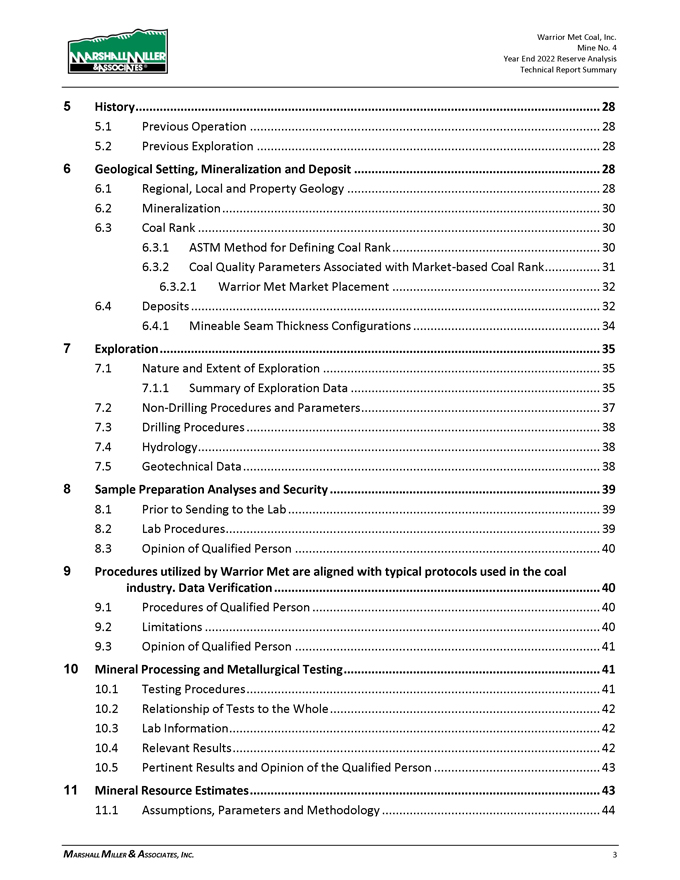
5 History. 28 5.1 Previous Operation. 28 5.2 Previous Exploration 28 6 Geological Setting, Mineralization and Deposit 28 6.1 Regional, Local and Property Geology 28 6.2 Mineralization 30 6.3 Coal Rank 30 6.3.1 ASTM Method for Defining Coal Rank. 30 6.3.2 Coal Quality Parameters Associated with Market-based Coal Rank 31 6.3.2.1 Warrior Met Market Placement. 32 6.4 Deposits 32 6.4.1 Mineable Seam Thickness Configurations 34 7 Exploration. 35 7.1 Nature and Extent of Exploration 35 7.1.1 Summary of Exploration Data. 35 7.2 Non-Drilling Procedures and Parameters 37 7.3 Drilling Procedures 38 7.4 Hydrology 38 7.5 Geotechnical Data. 38 8 Sample Preparation Analyses and Security 39 8.1 Prior to Sending to the Lab 39 8.2 Lab Procedures. 39 8.3 Opinion of Qualified Person. 40 9 Procedures utilized by Warrior Met are aligned with typical protocols used in the coal industry. Data Verification. 40 9.1 Procedures of Qualified Person 40 9.2 Limitations 40 9.3 Opinion of Qualified Person. 41 10 Mineral Processing and Metallurgical Testing. 41 10.1 Testing Procedures 41 10.2 Relationship of Tests to the Whole 42 10.3 Lab Information 42 10.4 Relevant Results 42 10.5 Pertinent Results and Opinion of the Qualified Person. 43 11 Mineral Resource Estimates. 43 11.1 Assumptions, Parameters and Methodology. 44 MARSHALL MILLER & ASSOCIATES, INC. 3

11.1.1 Geostatistical Analysis for Classification . 46 11.1.1.1 Additional Commentary on Measured and Indicated Breakdowns . 49 11.2 Qualified Person’s Estimates 50 12 Mineral Reserve Estimates . 51 12.1 Assumptions, Parameters and Methodology . 51 12.2 Qualified Person’s Estimates 53 12.3 Qualified Person’s Opinion 54 13 Mining Methods . 54 13.1 Geotechnical and Hydrologic Issues 54 13.2 Production Rates . 55 13.3 Mining-Related Requirements 56 13.4 Required Equipment and Personnel 56 14 Processing and Recovery Methods . 57 14.1 Description or Flowsheet 57 14.2 Requirements for Energy, Water, Material and Personnel . 57 15 Infrastructure 58 16 Market Studies 59 16.1 Market Description . 59 16.2 Price Forecasts . 59 16.3 Contract Requirements 60 17 Environmental Studies, Permitting and Plans, Negotiations or Agreements with Local Individuals . 61 17.1 Results of Studies 61 17.2 Requirements and Plans for Waste Disposal 61 17.3 Permit Requirements and Status . 61 17.4 Local Plans, Negotiations or Agreements 62 17.5 Mine Closure Plans 62 17.6 Qualified Person’s Opinion 63 18 Capital and Operating Costs . 63 18.1 Capital Cost Estimate 63 18.2 Operating Cost Estimate . 64 18.3 Capex & Opex Summary Tables 65 19 Economic Analysis 66 19.1 Assumptions, Parameters and Methods . 66 19.2 Results 69 19.3 Sensitivity 71 MARSHALL MILLER & ASSOCIATES, INC. 4
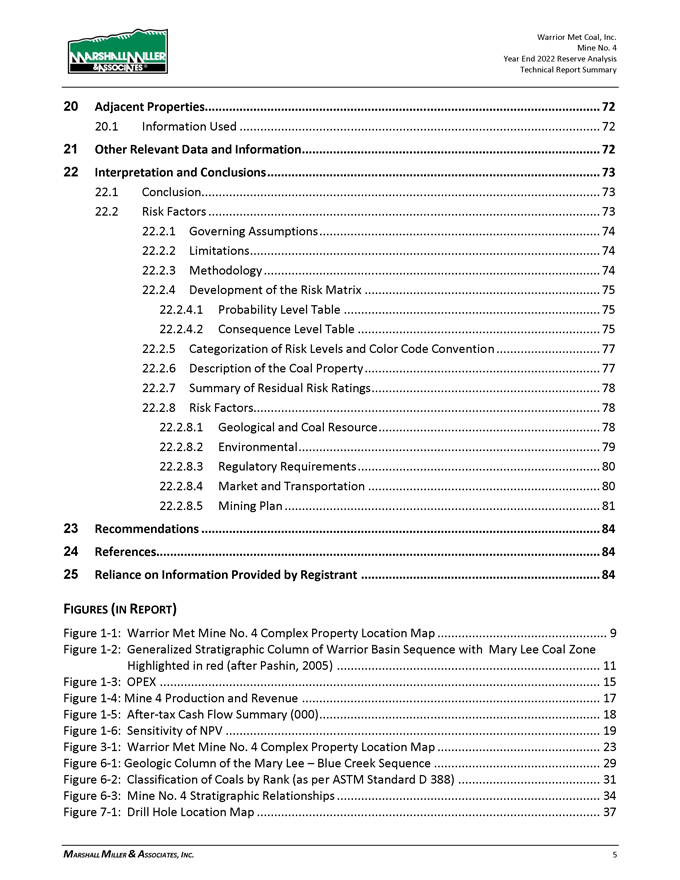
20 Adjacent Properties 72 20.1 Information Used 72 21 Other Relevant Data and Information . 72 22 Interpretation and Conclusions . 73 22.1 Conclusion . 73 22.2 Risk Factors 73 22.2.1 Governing Assumptions . 74 22.2.2 Limitations . 74 22.2.3 Methodology 74 22.2.4 Development of the Risk Matrix 75 22.2.4.1 Probability Level Table . 75 22.2.4.2 Consequence Level Table . 75 22.2.5 Categorization of Risk Levels and Color Code Convention 77 22.2.6 Description of the Coal Property 77 22.2.7 Summary of Residual Risk Ratings 78 22.2.8 Risk Factors 78 22.2.8.1 Geological and Coal Resource 78 22.2.8.2 Environmental 79 22.2.8.3 Regulatory Requirements . 80 22.2.8.4 Market and Transportation . 80 22.2.8.5 Mining Plan . 81 23 Recommendations . 84 24 References 84 25 Reliance on Information Provided by Registrant 84 FIGURES (IN REPORT) Figure 1-1: Warrior Met Mine No. 4 Complex Property Location Map 9 Figure 1-2: Generalized Stratigraphic Column of Warrior Basin Sequence with Mary Lee Coal Zone Highlighted in red (after Pashin, 2005) 11 Figure 1-3: OPEX . 15 Figure 1-4: Mine 4 Production and Revenue . 17 Figure 1-5: After-tax Cash Flow Summary (000) . 18 Figure 1-6: Sensitivity of NPV . 19 Figure 3-1: Warrior Met Mine No. 4 Complex Property Location Map 23 Figure 6-1: Geologic Column of the Mary Lee – Blue Creek Sequence . 29 Figure 6-2: Classification of Coals by Rank (as per ASTM Standard D 388) . 31 Figure 6-3: Mine No. 4 Stratigraphic Relationships 34 Figure 7-1: Drill Hole Location Map 37 MARSHALL MILLER & ASSOCIATES, INC. 5
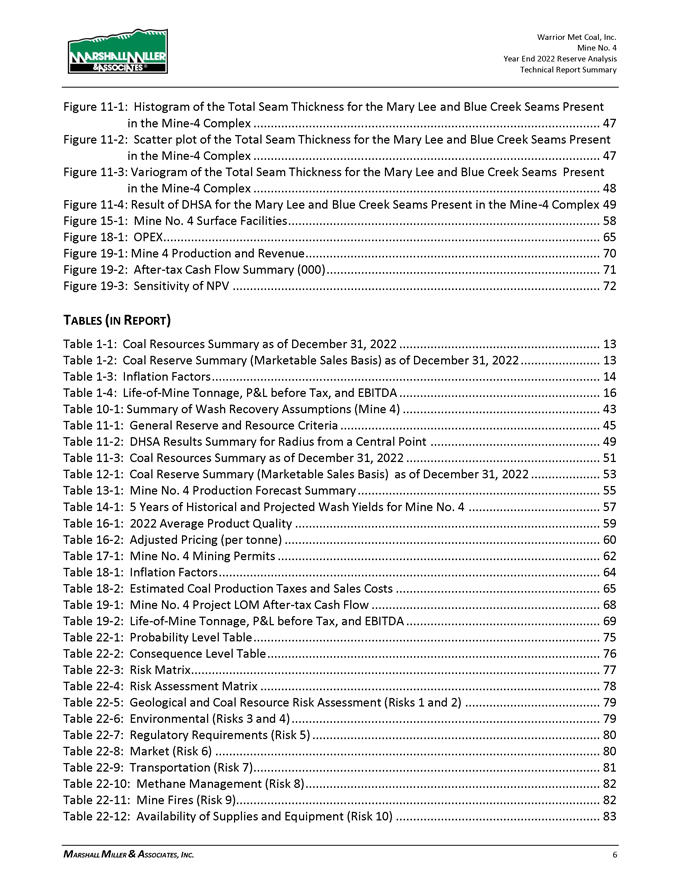
Figure 11-1: Histogram of the Total Seam Thickness for the Mary Lee and Blue Creek Seams Present in the Mine-4 Complex 47 Figure 11-2: Scatter plot of the Total Seam Thickness for the Mary Lee and Blue Creek Seams Present in the Mine-4 Complex 47 Figure 11-3: Variogram of the Total Seam Thickness for the Mary Lee and Blue Creek Seams Present in the Mine-4 Complex 48 Figure 11-4: Result of DHSA for the Mary Lee and Blue Creek Seams Present in the Mine-4 Complex 49 Figure 15-1: Mine No. 4 Surface Facilities 58 Figure 18-1: OPEX 65 Figure 19-1: Mine 4 Production and Revenue 70 Figure 19-2: After-tax Cash Flow Summary (000) . 71 Figure 19-3: Sensitivity of NPV 72 TABLES (IN REPORT) Table 1-1: Coal Resources Summary as of December 31, 2022 13 Table 1-2: Coal Reserve Summary (Marketable Sales Basis) as of December 31, 2022 13 Table 1-3: Inflation Factors . 14 Table 1-4: Life-of-Mine Tonnage, P&L before Tax, and EBITDA 16 Table 10-1: Summary of Wash Recovery Assumptions (Mine 4) . 43 Table 11-1: General Reserve and Resource Criteria 45 Table 11-2: DHSA Results Summary for Radius from a Central Point 49 Table 11-3: Coal Resources Summary as of December 31, 2022 51 Table 12-1: Coal Reserve Summary (Marketable Sales Basis) as of December 31, 2022 53 Table 13-1: Mine No. 4 Production Forecast Summary . 55 Table 14-1: 5 Years of Historical and Projected Wash Yields for Mine No. 4 57 Table 16-1: 2022 Average Product Quality . 59 Table 16-2: Adjusted Pricing (per tonne) . 60 Table 17-1: Mine No. 4 Mining Permits 62 Table 18-1: Inflation Factors . 64 Table 18-2: Estimated Coal Production Taxes and Sales Costs 65 Table 19-1: Mine No. 4 Project LOM After-tax Cash Flow 68 Table 19-2: Life-of-Mine Tonnage, P&L before Tax, and EBITDA 69 Table 22-1: Probability Level Table 75 Table 22-2: Consequence Level Table . 76 Table 22-3: Risk Matrix 77 Table 22-4: Risk Assessment Matrix . 78 Table 22-5: Geological and Coal Resource Risk Assessment (Risks 1 and 2) . 79 Table 22-6: Environmental (Risks 3 and 4) 79 Table 22-7: Regulatory Requirements (Risk 5) 80 Table 22-8: Market (Risk 6) 80 Table 22-9: Transportation (Risk 7) 81 Table 22-10: Methane Management (Risk 8) 82 Table 22-11: Mine Fires (Risk 9) . 82 Table 22-12: Availability of Supplies and Equipment (Risk 10) 83 MARSHALL MILLER & ASSOCIATES, INC. 6

Table 22-13: Labor – Work Stoppage (Risk 11) 83 Table 22-14: Labor – Retirement (Risk 12) 83 Appendices A Table B . Market Projections Provided by Warrior Met MARSHALL MILLER & ASSOCIATES, INC. 7
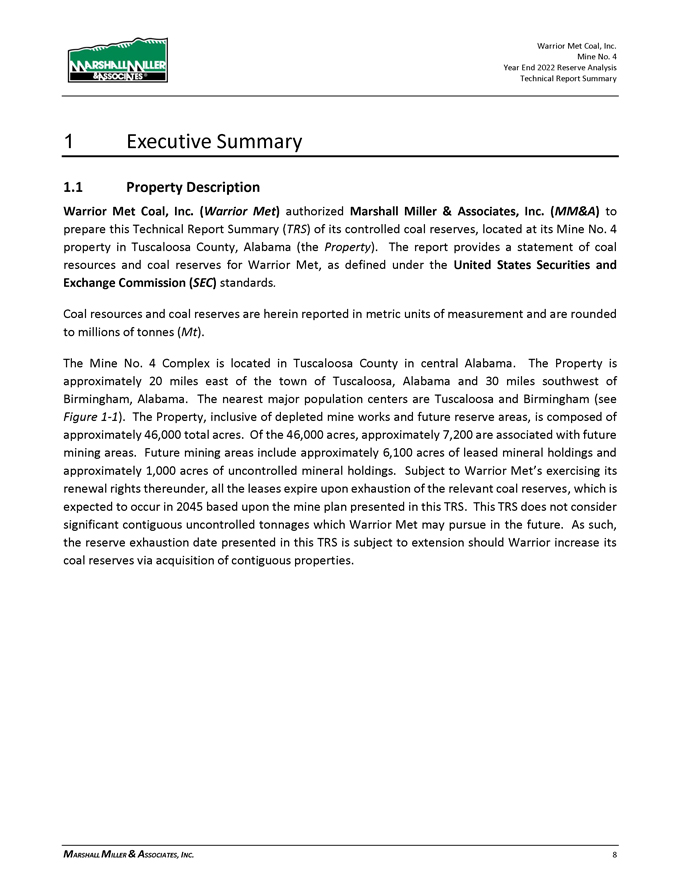
1 Executive Summary 1.1 Property Description Warrior Met Coal, Inc. (Warrior Met) authorized Marshall Miller & Associates, Inc. (MM&A) to prepare this Technical Report Summary (TRS) of its controlled coal reserves, located at its Mine No. 4 property in Tuscaloosa County, Alabama (the Property). The report provides a statement of coal resources and coal reserves for Warrior Met, as defined under the United States Securities and Exchange Commission (SEC) standards. Coal resources and coal reserves are herein reported in metric units of measurement and are rounded to millions of tonnes (Mt). The Mine No. 4 Complex is located in Tuscaloosa County in central Alabama. The Property is approximately 20 miles east of the town of Tuscaloosa, Alabama and 30 miles southwest of Birmingham, Alabama. The nearest major population centers are Tuscaloosa and Birmingham (see Figure 1-1). The Property, inclusive of depleted mine works and future reserve areas, is composed of approximately 46,000 total acres. Of the 46,000 acres, approximately 7,200 are associated with future mining areas. Future mining areas include approximately 6,100 acres of leased mineral holdings and approximately 1,000 acres of uncontrolled mineral holdings. Subject to Warrior Met’s exercising its renewal rights thereunder, all the leases expire upon exhaustion of the relevant coal reserves, which is expected to occur in 2045 based upon the mine plan presented in this TRS. This TRS does not consider significant contiguous uncontrolled tonnages which Warrior Met may pursue in the future. As such, the reserve exhaustion date presented in this TRS is subject to extension should Warrior increase its coal reserves via acquisition of contiguous properties. MARSHALL MILLER & ASSOCIATES, INC. 8
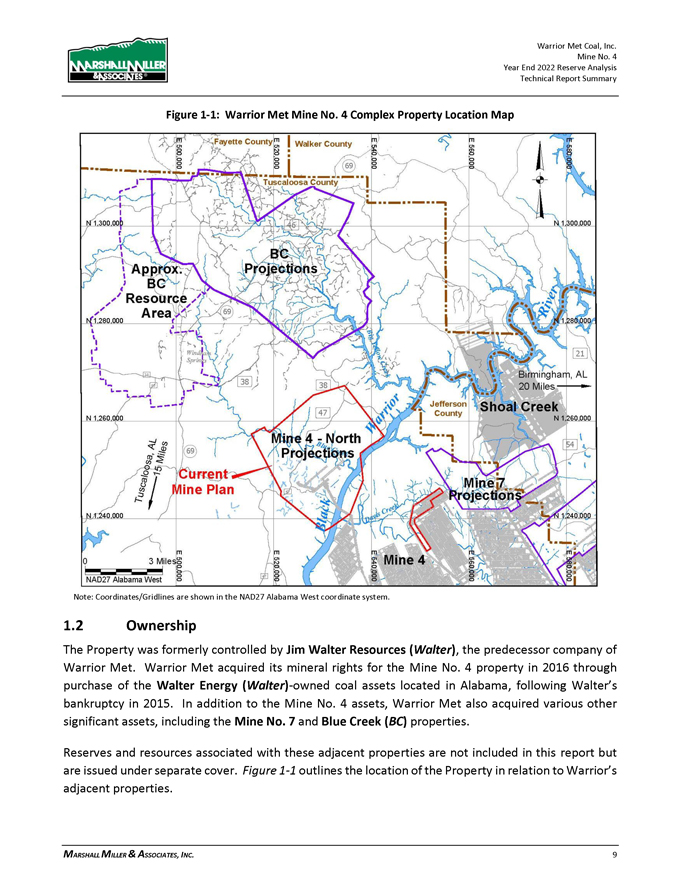
Figure 1-1: Warrior Met Mine No. 4 Complex Property Location Map Note: Coordinates/Gridlines are shown in the NAD27 Alabama West coordinate system. 1.2 Ownership The Property was formerly controlled by Jim Walter Resources (Walter), the predecessor company of Warrior Met. Warrior Met acquired its mineral rights for the Mine No. 4 property in 2016 through purchase of the Walter Energy (Walter)-owned coal assets located in Alabama, following Walter’s bankruptcy in 2015. In addition to the Mine No. 4 assets, Warrior Met also acquired various other significant assets, including the Mine No. 7 and Blue Creek (BC) properties. Reserves and resources associated with these adjacent properties are not included in this report but are issued under separate cover. Figure 1-1 outlines the location of the Property in relation to Warrior’s adjacent properties. MARSHALL MILLER & ASSOCIATES, INC. 9

1.3 Geology Operations at the Mine No. 4 Complex extract the Mary Lee and Blue Creek coal beds by longwall mining methods. The strata of economic interest for this TRS belong to the Pennsylvanian-age Mary Lee Coal Group or Zone (see Figure 1-3), and the subject seams are the principal coal seams of interest within that formation for the present evaluation. High-angle normal faults located within the Property have a direct impact upon mine layout and design. Due to the high value of this coal, it has been extensively mined in the region. Warrior Met reports that current market placement at Mine No. 4 is generally an average of the Premium Low-Volatile Indices (PLV) and the Mid-Volatile Indices (MV), this average will be referenced as Premium Low–Mid-Vol Average (PLMV). Mine projections suggest that Warrior Met will continue to produce coal in the current “East” district for less than one year before transitioning to the western reserve areas. As development activities continue to transition to the “North” district and the longwall mines out the “East” district, coal produced from Mine No. 4 will likely incur an increase in volatile matter. Based on regional trends and laboratory data, volatile matter contents for the subject coals in the western area will gradually edge upward. Since the potential exists for pricing to change as the volatiles vary in future areas as they are developed, MM&A, with support from Warrior Met, has used the PLMV as a basis for pricing. MARSHALL MILLER & ASSOCIATES, INC. 10

Figure 1-2: Generalized Stratigraphic Column of Warrior Basin Sequence with Mary Lee Coal Zone Highlighted in red (after Pashin, 2005) 1.4 Exploration Status Since as early as 1916, the Property has been extensively explored by means of: continuous coring and analytic testing; rotary drilling, and ongoing development associated with coalbed methane (CBM) production; by downhole geophysical logging of gas wells; and by in-seam channel sampling during mining. The majority of the data was acquired or generated by previous owners of the Property but has been supplemented by exploration drilling conducted by Warrior Met over the past 6 years (as recently as 2022). These sources comprise the primary data used in the evaluation of the coal resources and coal reserves identified on the Property. MM&A examined the data available for the evaluation MARSHALL MILLER & ASSOCIATES, INC. 11
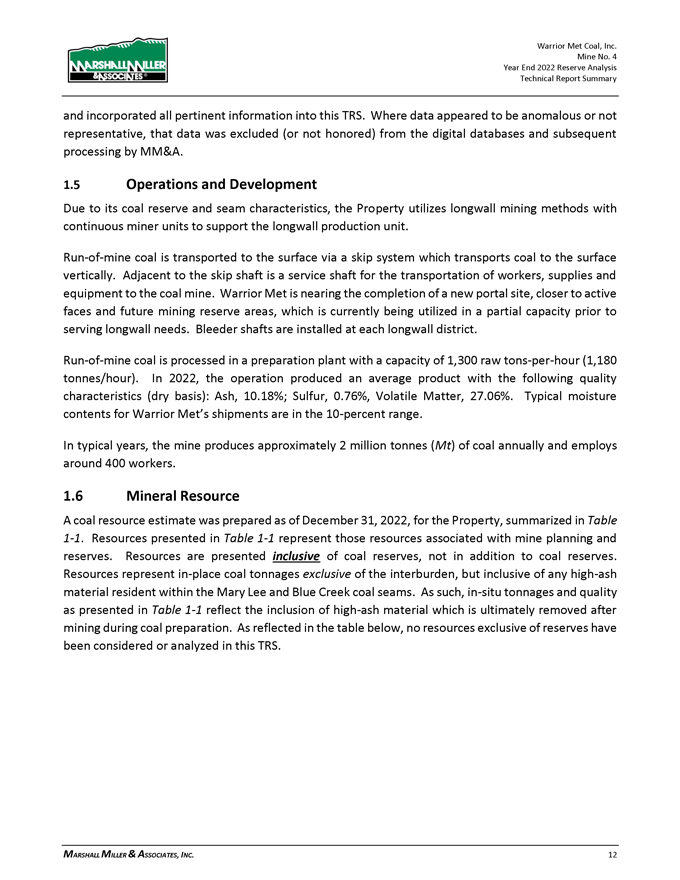
and incorporated all pertinent information into this TRS. Where data appeared to be anomalous or not representative, that data was excluded (or not honored) from the digital databases and subsequent processing by MM&A. 1.5 Operations and Development Due to its coal reserve and seam characteristics, the Property utilizes longwall mining methods with continuous miner units to support the longwall production unit. Run-of-mine coal is transported to the surface via a skip system which transports coal to the surface vertically. Adjacent to the skip shaft is a service shaft for the transportation of workers, supplies and equipment to the coal mine. Warrior Met is nearing the completion of a new portal site, closer to active faces and future mining reserve areas, which is currently being utilized in a partial capacity prior to serving longwall needs. Bleeder shafts are installed at each longwall district. Run-of-mine coal is processed in a preparation plant with a capacity of 1,300 raw tons-per-hour (1,180 tonnes/hour). In 2022, the operation produced an average product with the following quality characteristics (dry basis): Ash, 10.18%; Sulfur, 0.76%, Volatile Matter, 27.06%. Typical moisture contents for Warrior Met’s shipments are in the 10-percent range. In typical years, the mine produces approximately 2 million tonnes (Mt) of coal annually and employs around 400 workers. 1.6 Mineral Resource A coal resource estimate was prepared as of December 31, 2022, for the Property, summarized in Table 1-1. Resources presented in Table 1-1 represent those resources associated with mine planning and reserves. Resources are presented inclusive of coal reserves, not in addition to coal reserves. Resources represent in-place coal tonnages exclusive of the interburden, but inclusive of any high-ash material resident within the Mary Lee and Blue Creek coal seams. As such, in-situ tonnages and quality as presented in Table 1-1 reflect the inclusion of high-ash material which is ultimately removed after mining during coal preparation. As reflected in the table below, no resources exclusive of reserves have been considered or analyzed in this TRS. MARSHALL MILLER & ASSOCIATES, INC. 12

Table 1-1: Coal Resources Summary as of December 31, 2022 Coal Resource (Dry Tonnes, In Situ, Mt) Resource Quality (Dry) Seam Measured Indicated Inferred Total Ash% Sulfur% VM% Inclusive of Reserves Mary Lee 16.5 0.3 0.0 16.7 ——Blue Creek 42.4 0.6 0.0 43.0 —— Total 58.9 0.8 0.0 59.7 16.5 0.9 28 Exclusive of Reserves Mary Lee 0.0 0.0 0.0 0.0 ——Blue Creek 0.0 0.0 0.0 0.0 —— Total 0.0 0.0 0.0 0.0 0.0 0.0 0 Grand Total 58.9 0.8 0.0 59.7 16.5 0.9 28 Note 1: Coal resources are reported on a dry basis, inclusive of high-ash partings which are ultimately removed during coal preparation. Surface moisture and inherent moisture are excluded. Totals may not add due to rounding. 1.7 Mineral Reserve Resource modeling and estimates are used as the basis for the Property’s reserve calculation and is based on a reasonable Pre-Feasibility level, life-of-mine (LOM) mine plan and practical recovery factors. Such factors include a mine recovery of 72 percent derived from an engineered mine plan, the consideration of out-of-seam and in-seam dilution material, an effective a wash recovery of 49 percent and the consideration of moisture factors. Proven and probable coal reserves were derived from the defined in-situ coal resource considering relevant processing, economic (including technical estimates of capital, revenue and cost), marketing, legal, environmental, socioeconomic, and regulatory factors. The proven and probable coal reserves on the Property are summarized below in Table 1-2. Table 1-2: Coal Reserve Summary (Marketable Sales Basis) as of December 31, 2022 Demonstrated Coal Reserves (Wet Tonnes, Washed or Direct Shipped, Mt) By Reliability Category By Control Type Quality (Dry Basis) Wash Seam Proven Probable Total Owned Leased Ash% Sulfur% VM% Recovery Mary Lee 11.3 0.2 11.5 0.0 11.5 —— Blue Creek 27.4 0.4 27.8 0.0 27.8 ——49% Total 38.7 0.5 39.2 0.0 39.2 10.2 0.8 30 Note 1: Marketable reserve tonnes are reported on a moist basis, including a combination of surface and inherent moisture. The combination of surface and inherent moisture is modeled at 10-percent, comparable to Warrior Met’s current product moisture. Actual product moisture is dependent upon multiple geological factors, operational factors, and product contract specifications. Note 2: Wash recovery is based on LOM planning and reflects projected plant recovery after the consideration of out-of-seam dilution. Wash recovery is not stated on a seam-by-seam basis, as the Mary Lee and Blue Creek seams are mined together – allocation of dilution material on a seam-by-seam basis would introduce confusion with regards to wash recovery. Detailed reserve tables (see Appendix) show projected in-seam wash recovery on a seam-by -seam basis, absent dilution assumptions. Note 3: Coal Reserves are based upon sales assumptions provided to MM&A by Warrior and were relied upon by MM&A. Financial modeling assumes sales prices of approximately $129.46/ tonne (FOB-mine) in 2023, increasing to a long-term price of approximately $161.24/tonne. See Chapter 16 for further details on marketing assumptions. Totals may not add due to rounding. MARSHALL MILLER & ASSOCIATES, INC. 13
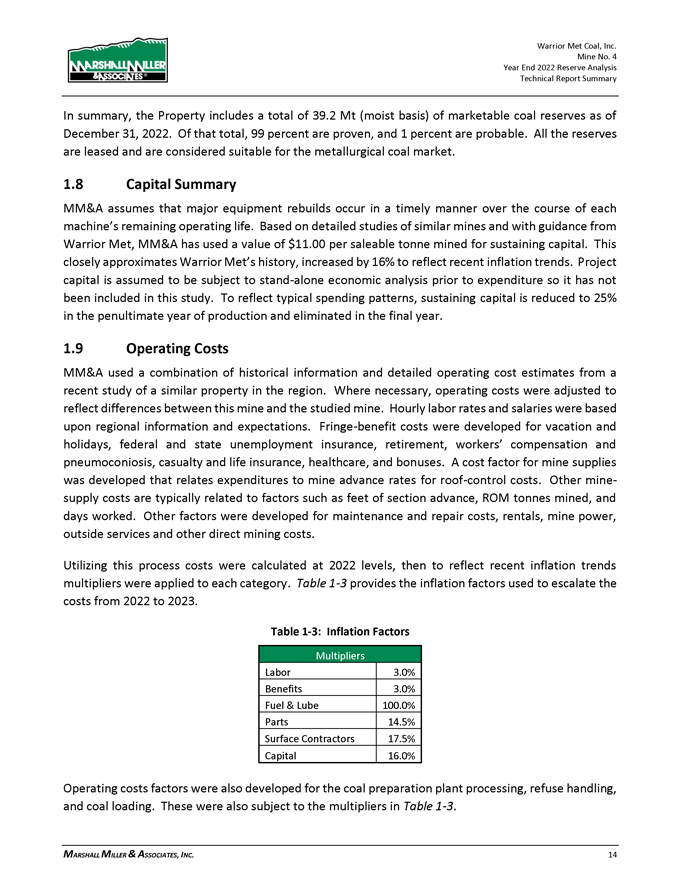
In summary, the Property includes a total of 39.2 Mt (moist basis) of marketable coal reserves as of December 31, 2022. Of that total, 99 percent are proven, and 1 percent are probable. All the reserves are leased and are considered suitable for the metallurgical coal market. 1.8 Capital Summary MM&A assumes that major equipment rebuilds occur in a timely manner over the course of each machine’s remaining operating life. Based on detailed studies of similar mines and with guidance from Warrior Met, MM&A has used a value of $11.00 per saleable tonne mined for sustaining capital. This closely approximates Warrior Met’s history, increased by 16% to reflect recent inflation trends. Project capital is assumed to be subject to stand-alone economic analysis prior to expenditure so it has not been included in this study. To reflect typical spending patterns, sustaining capital is reduced to 25% in the penultimate year of production and eliminated in the final year. 1.9 Operating Costs MM&A used a combination of historical information and detailed operating cost estimates from a recent study of a similar property in the region. Where necessary, operating costs were adjusted to reflect differences between this mine and the studied mine. Hourly labor rates and salaries were based upon regional information and expectations. Fringe-benefit costs were developed for vacation and holidays, federal and state unemployment insurance, retirement, workers’ compensation and pneumoconiosis, casualty and life insurance, healthcare, and bonuses. A cost factor for mine supplies was developed that relates expenditures to mine advance rates for roof-control costs. Other mine-supply costs are typically related to factors such as feet of section advance, ROM tonnes mined, and days worked. Other factors were developed for maintenance and repair costs, rentals, mine power, outside services and other direct mining costs. Utilizing this process costs were calculated at 2022 levels, then to reflect recent inflation trends multipliers were applied to each category. Table 1-3 provides the inflation factors used to escalate the costs from 2022 to 2023. Table 1-3: Inflation Factors Multipliers Labor 3.0% Benefits 3.0% Fuel & Lube 100.0% Parts 14.5% Surface Contractors 17.5% Capital 16.0% Operating costs factors were also developed for the coal preparation plant processing, refuse handling, and coal loading. These were also subject to the multipliers in Table 1-3. MARSHALL MILLER & ASSOCIATES, INC. 14
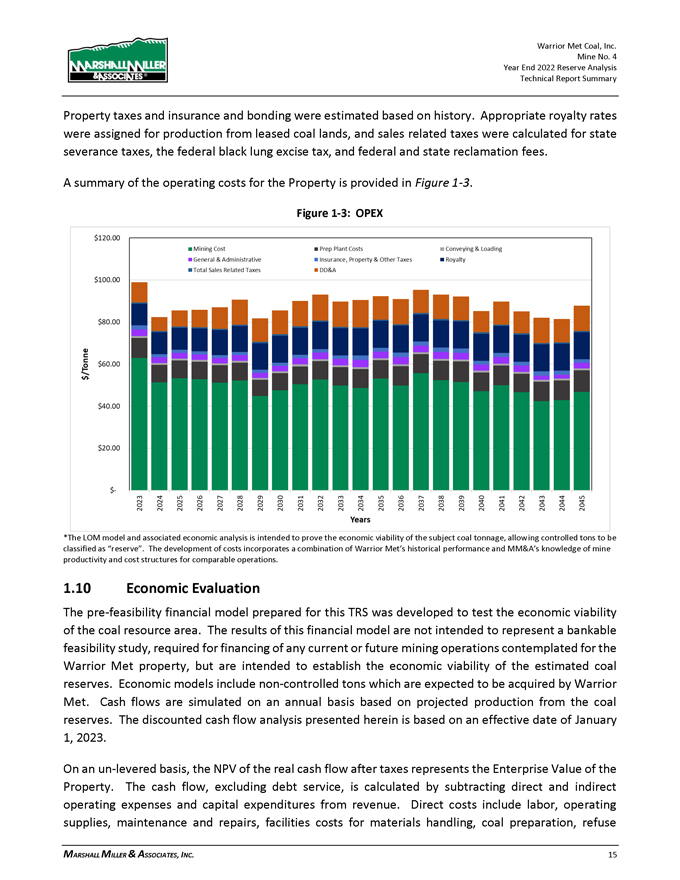
Property taxes and insurance and bonding were estimated based on history. Appropriate royalty rates were assigned for production from leased coal lands, and sales related taxes were calculated for state severance taxes, the federal black lung excise tax, and federal and state reclamation fees. A summary of the operating costs for the Property is provided in Figure 1-3. Figure 1-3: OPEX *The LOM model and associated economic analysis is intended to prove the economic viability of the subject coal tonnage, allowing controlled tons to be classified as “reserve”. The development of costs incorporates a combination of Warrior Met’s historical performance and MM&A’s knowledge of mine productivity and cost structures for comparable operations. 1.10 Economic Evaluation The pre-feasibility financial model prepared for this TRS was developed to test the economic viability of the coal resource area. The results of this financial model are not intended to represent a bankable feasibility study, required for financing of any current or future mining operations contemplated for the Warrior Met property, but are intended to establish the economic viability of the estimated coal reserves. Economic models include non-controlled tons which are expected to be acquired by Warrior Met. Cash flows are simulated on an annual basis based on projected production from the coal reserves. The discounted cash flow analysis presented herein is based on an effective date of January 1, 2023. On an un-levered basis, the NPV of the real cash flow after taxes represents the Enterprise Value of the Property. The cash flow, excluding debt service, is calculated by subtracting direct and indirect operating expenses and capital expenditures from revenue. Direct costs include labor, operating supplies, maintenance and repairs, facilities costs for materials handling, coal preparation, refuse MARSHALL MILLER & ASSOCIATES, INC. 15

disposal, coal loading, reclamation and general and administrative costs. Indirect costs include statutory and legally agreed upon fees related to direct extraction of the mineral. The indirect costs are the Federal black lung tax, Federal and State reclamation taxes, property taxes, coal production royalties, and income taxes. Table 1-4 shows LOM tonnage, P&L, and EBITDA for Mine No. 4. Table 1-4: Life-of-Mine Tonnage, P&L before Tax, and EBITDA Tonnes Pre-Tax P&L P&L EBITDA EBITDA (000) ($000) per Tonne ($000) per Tonne Mine #4 44,700 $2,936,114 $65.69 $3,416,521 $76.44 Note 1: The LOM model includes a small portion of tonnage contained within adverse tracts which are not included in reserve estimates. Note 2: The LOM model and associated economic analysis is intended to prove the economic viability of the subject coal tonnage, allowing controlled tons to be classified as “reserve”. The exercise should not be construed to represent a valuation of Warrior Met’s holdings. Long-term cash flows incorporate forward-looking market projections which are expected to vary over time based upon historic volatility of coal markets. The development of costs incorporates a combination of Warrior Met’s historical performance and MM&A’s knowledge of mine productivity and cost structures for comparable operations. As shown in Table 1-4, Mine No. 4 shows positive EBITDA over the LOM. Overall, the Warrior Met consolidated operation shows positive LOM P&L and EBITDA of $2.9 billion and $3.4 billion, respectively. Warrior Met’s Mine No. 4 annual production and revenue are shown in Figure 1-4 and the Mine’s after-tax cash flow summary in constant dollars, excluding debt service, is shown in Figure 1-5 below. MARSHALL MILLER & ASSOCIATES, INC. 16
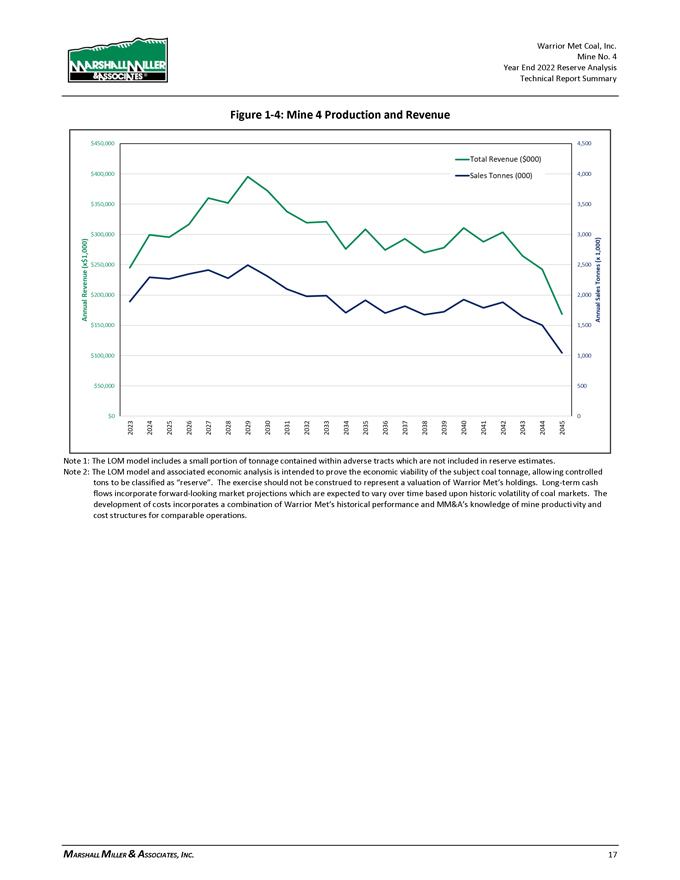
Figure 1-4: Mine 4 Production and Revenue Note 1: The LOM model includes a small portion of tonnage contained within adverse tracts which are not included in reserve estimates. Note 2: The LOM model and associated economic analysis is intended to prove the economic viability of the subject coal tonnage, allowing controlled tons to be classified as “reserve”. The exercise should not be construed to represent a valuation of Warrior Met’s holdings. Long-term cash flows incorporate forward-looking market projections which are expected to vary over time based upon historic volatility of coal markets. The development of costs incorporates a combination of Warrior Met’s historical performance and MM&A’s knowledge of mine productivity and cost structures for comparable operations. MARSHALL MILLER & ASSOCIATES, INC. 17
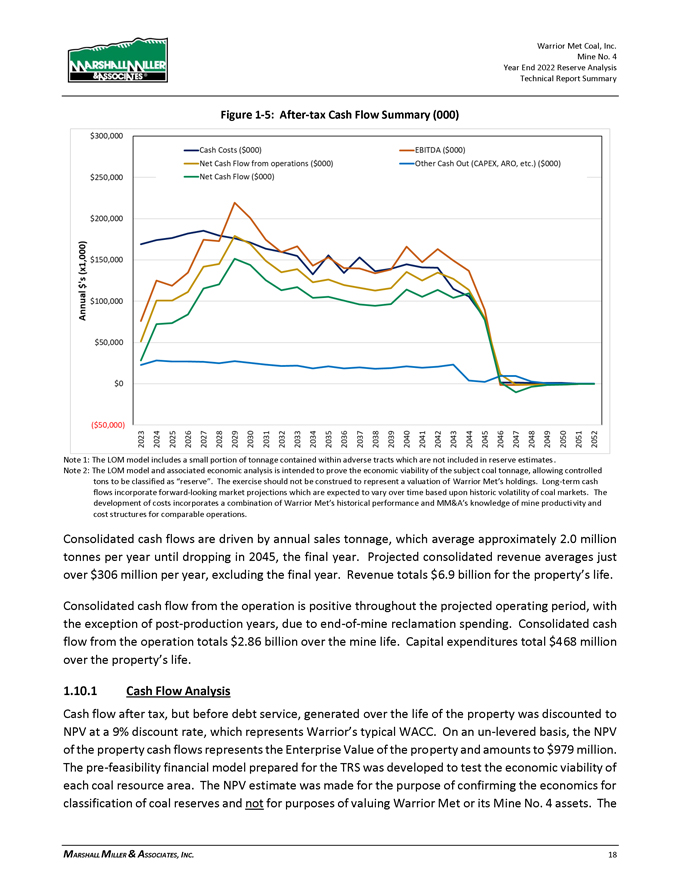
Figure 1-5: After-tax Cash Flow Summary (000) Note 1: The LOM model includes a small portion of tonnage contained within adverse tracts which are not included in reserve estimates. Note 2: The LOM model and associated economic analysis is intended to prove the economic viability of the subject coal tonnage, allowing controlled tons to be classified as “reserve”. The exercise should not be construed to represent a valuation of Warrior Met’s holdings. Long-term cash flows incorporate forward-looking market projections which are expected to vary over time based upon historic volatility of coal markets. The development of costs incorporates a combination of Warrior Met’s historical performance and MM&A’s knowledge of mine productivity and cost structures for comparable operations. Consolidated cash flows are driven by annual sales tonnage, which average approximately 2.0 million tonnes per year until dropping in 2045, the final year. Projected consolidated revenue averages just over $306 million per year, excluding the final year. Revenue totals $6.9 billion for the property’s life. Consolidated cash flow from the operation is positive throughout the projected operating period, with the exception of post-production years, due to end-of-mine reclamation spending. Consolidated cash flow from the operation totals $2.86 billion over the mine life. Capital expenditures total $468 million over the property’s life. 1.10.1 Cash Flow Analysis Cash flow after tax, but before debt service, generated over the life of the property was discounted to NPV at a 9% discount rate, which represents Warrior’s typical WACC. On an un-levered basis, the NPV of the property cash flows represents the Enterprise Value of the property and amounts to $979 million. The pre-feasibility financial model prepared for the TRS was developed to test the economic viability of each coal resource area. The NPV estimate was made for the purpose of confirming the economics for classification of coal reserves and not for purposes of valuing Warrior Met or its Mine No. 4 assets. The MARSHALL MILLER & ASSOCIATES, INC. 18
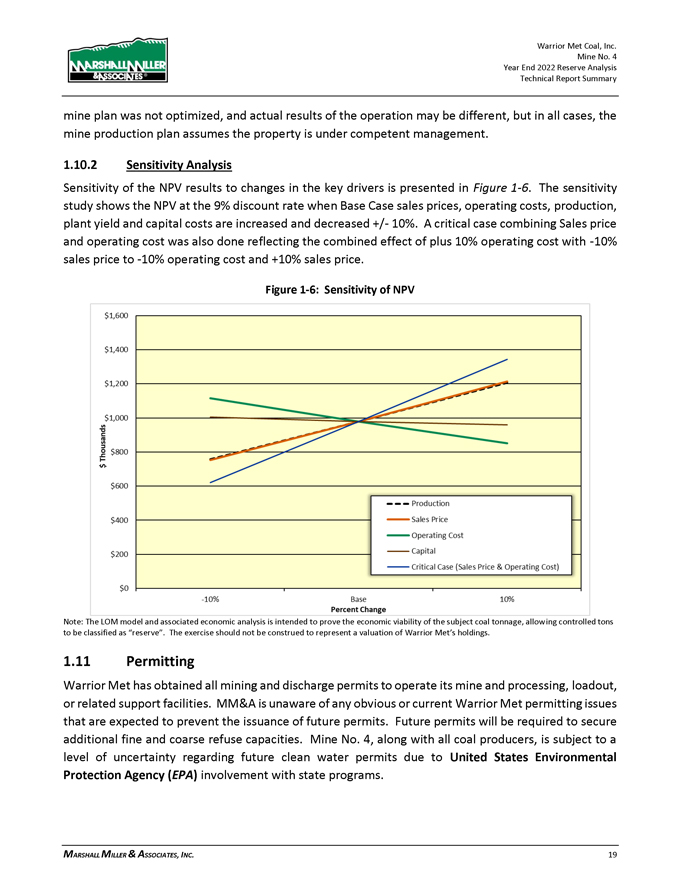
mine plan was not optimized, and actual results of the operation may be different, but in all cases, the mine production plan assumes the property is under competent management. 1.10.2 Sensitivity Analysis Sensitivity of the NPV results to changes in the key drivers is presented in Figure 1-6. The sensitivity study shows the NPV at the 9% discount rate when Base Case sales prices, operating costs, production, plant yield and capital costs are increased and decreased +/- 10%. A critical case combining Sales price and operating cost was also done reflecting the combined effect of plus 10% operating cost with -10% sales price to -10% operating cost and +10% sales price. Figure 1-6: Sensitivity of NPV Note: The LOM model and associated economic analysis is intended to prove the economic viability of the subject coal tonnage, allowing controlled tons to be classified as “reserve”. The exercise should not be construed to represent a valuation of Warrior Met’s holdings. 1.11 Permitting Warrior Met has obtained all mining and discharge permits to operate its mine and processing, loadout, or related support facilities. MM&A is unaware of any obvious or current Warrior Met permitting issues that are expected to prevent the issuance of future permits. Future permits will be required to secure additional fine and coarse refuse capacities. Mine No. 4, along with all coal producers, is subject to a level of uncertainty regarding future clean water permits due to United States Environmental Protection Agency (EPA) involvement with state programs. MARSHALL MILLER & ASSOCIATES, INC. 19
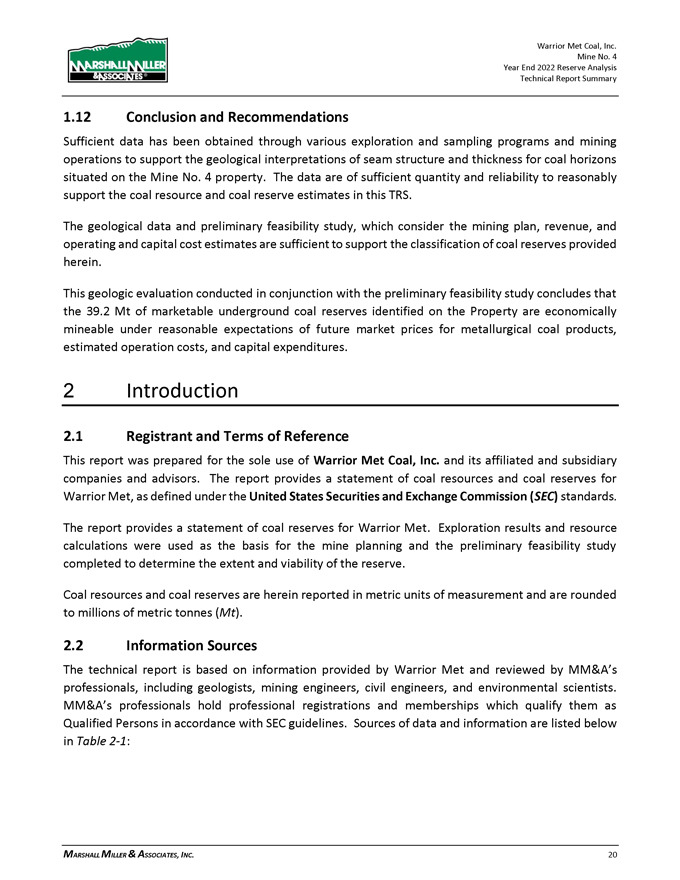
1.12 Conclusion and Recommendations Sufficient data has been obtained through various exploration and sampling programs and mining operations to support the geological interpretations of seam structure and thickness for coal horizons situated on the Mine No. 4 property. The data are of sufficient quantity and reliability to reasonably support the coal resource and coal reserve estimates in this TRS. The geological data and preliminary feasibility study, which consider the mining plan, revenue, and operating and capital cost estimates are sufficient to support the classification of coal reserves provided herein. This geologic evaluation conducted in conjunction with the preliminary feasibility study concludes that the 39.2 Mt of marketable underground coal reserves identified on the Property are economically mineable under reasonable expectations of future market prices for metallurgical coal products, estimated operation costs, and capital expenditures. 2 Introduction 2.1 Registrant and Terms of Reference This report was prepared for the sole use of Warrior Met Coal, Inc. and its affiliated and subsidiary companies and advisors. The report provides a statement of coal resources and coal reserves for Warrior Met, as defined under the United States Securities and Exchange Commission (SEC) standards. The report provides a statement of coal reserves for Warrior Met. Exploration results and resource calculations were used as the basis for the mine planning and the preliminary feasibility study completed to determine the extent and viability of the reserve. Coal resources and coal reserves are herein reported in metric units of measurement and are rounded to millions of metric tonnes (Mt). 2.2 Information Sources The technical report is based on information provided by Warrior Met and reviewed by MM&A’s professionals, including geologists, mining engineers, civil engineers, and environmental scientists. MM&A’s professionals hold professional registrations and memberships which qualify them as Qualified Persons in accordance with SEC guidelines. Sources of data and information are listed below in Table 2-1: MARSHALL MILLER & ASSOCIATES, INC. 20
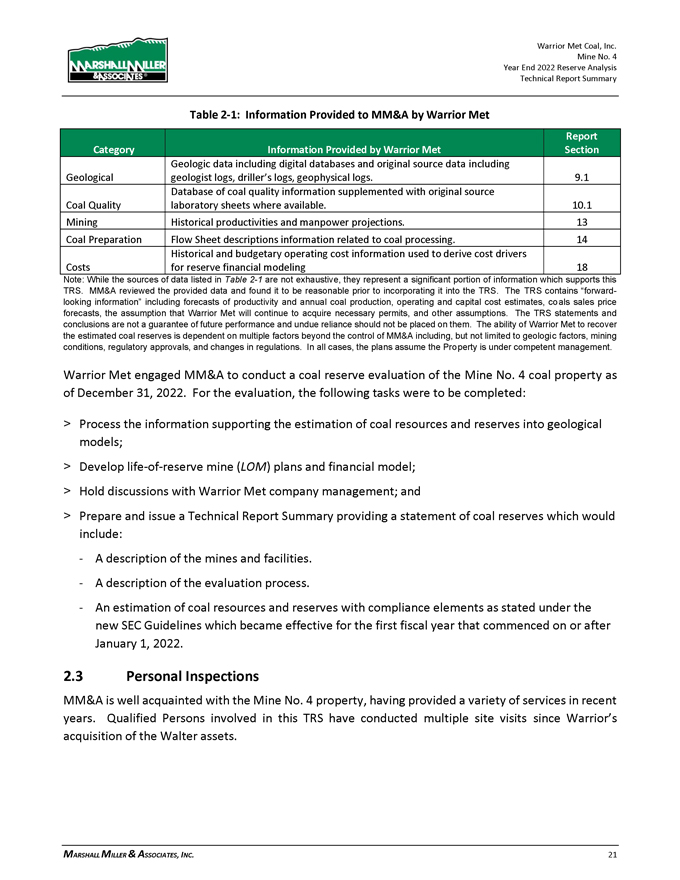
Table 2-1: Information Provided to MM&A by Warrior Met Report Category Information Provided by Warrior Met Section Geologic data including digital databases and original source data including Geological geologist logs, driller’s logs, geophysical logs. 9.1 Database of coal quality information supplemented with original source Coal Quality laboratory sheets where available. 10.1 Mining Historical productivities and manpower projections. 13 Coal Preparation Flow Sheet descriptions information related to coal processing. 14 Historical and budgetary operating cost information used to derive cost drivers Costs for reserve financial modeling 18 Note: While the sources of data listed in Table 2-1 are not exhaustive, they represent a significant portion of information which supports this TRS. MM&A reviewed the provided data and found it to be reasonable prior to incorporating it into the TRS. The TRS contains “forward-looking information” including forecasts of productivity and annual coal production, operating and capital cost estimates, co als sales price forecasts, the assumption that Warrior Met will continue to acquire necessary permits, and other assumptions. The TRS statements and conclusions are not a guarantee of future performance and undue reliance should not be placed on them. The ability of Warrior Met to recover the estimated coal reserves is dependent on multiple factors beyond the control of MM&A including, but not limited to geologic factors, mining conditions, regulatory approvals, and changes in regulations. In all cases, the plans assume the Property is under competent management. Warrior Met engaged MM&A to conduct a coal reserve evaluation of the Mine No. 4 coal property as of December 31, 2022. For the evaluation, the following tasks were to be completed: > Process the information supporting the estimation of coal resources and reserves into geological models; > Develop life-of-reserve mine (LOM) plans and financial model; > Hold discussions with Warrior Met company management; and > Prepare and issue a Technical Report Summary providing a statement of coal reserves which would include: —A description of the mines and facilities.—A description of the evaluation process. —An estimation of coal resources and reserves with compliance elements as stated under the new SEC Guidelines which became effective for the first fiscal year that commenced on or after January 1, 2022. 2.3 Personal Inspections MM&A is well acquainted with the Mine No. 4 property, having provided a variety of services in recent years. Qualified Persons involved in this TRS have conducted multiple site visits since Warrior’s acquisition of the Walter assets. MARSHALL MILLER & ASSOCIATES, INC. 21
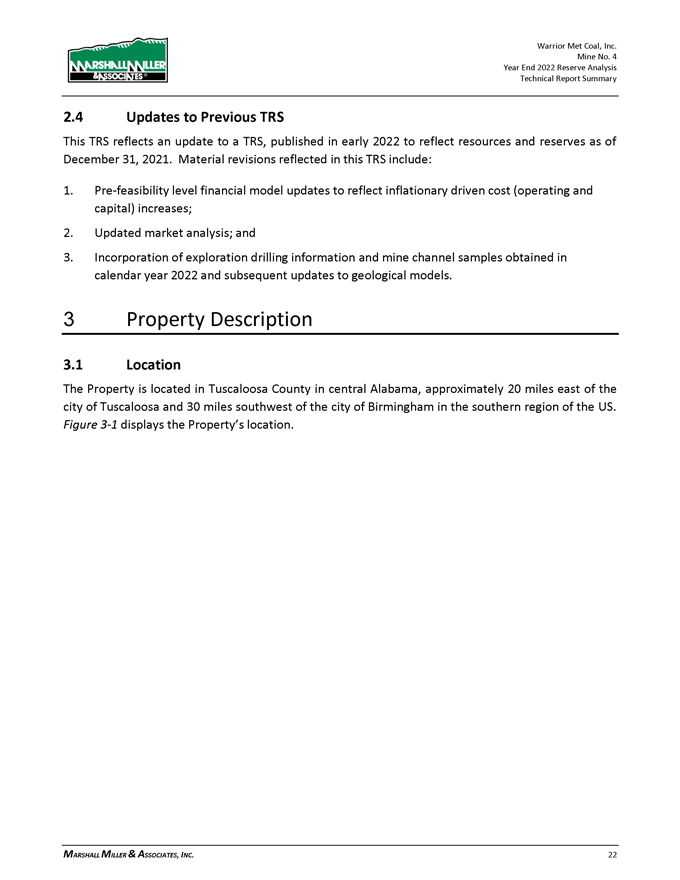
2.4 Updates to Previous TRS This TRS reflects an update to a TRS, published in early 2022 to reflect resources and reserves as of December 31, 2021. Material revisions reflected in this TRS include: 1. Pre-feasibility level financial model updates to reflect inflationary driven cost (operating and capital) increases; 2. Updated market analysis; and 3. Incorporation of exploration drilling information and mine channel samples obtained in calendar year 2022 and subsequent updates to geological models. 3 Property Description 3.1 Location The Property is located in Tuscaloosa County in central Alabama, approximately 20 miles east of the city of Tuscaloosa and 30 miles southwest of the city of Birmingham in the southern region of the US. Figure 3-1 displays the Property’s location. MARSHALL MILLER & ASSOCIATES, INC. 22
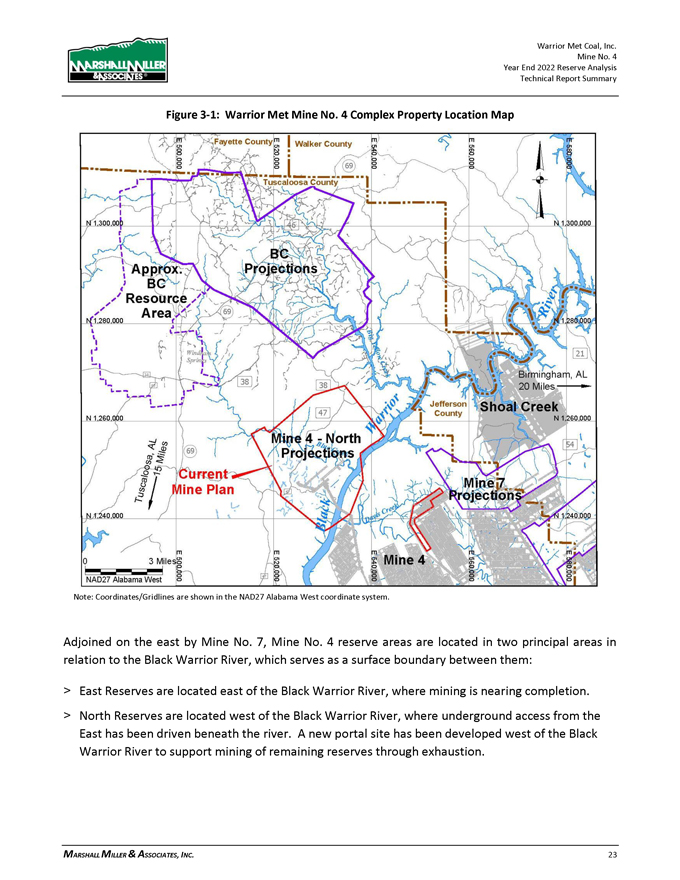
Figure 3-1: Warrior Met Mine No. 4 Complex Property Location Map Note: Coordinates/Gridlines are shown in the NAD27 Alabama West coordinate system. Adjoined on the east by Mine No. 7, Mine No. 4 reserve areas are located in two principal areas in relation to the Black Warrior River, which serves as a surface boundary between them: > East Reserves are located east of the Black Warrior River, where mining is nearing completion. > North Reserves are located west of the Black Warrior River, where underground access from the East has been driven beneath the river. A new portal site has been developed west of the Black Warrior River to support mining of remaining reserves through exhaustion. MARSHALL MILLER & ASSOCIATES, INC. 23

3.2 Titles, Claims or Leases MM&A has not carried out a separate title verification for the coal property and has not verified leases, deeds, surveys or other property control instruments pertinent to the subject resources. Warrior Met has represented to MM&A that it controls the mining rights to the reserves as shown on its property maps, and MM&A has accepted these as being a true and accurate depiction of the mineral rights controlled by Warrior Met. 3.3 Mineral Rights Warrior Met, through its acquisition of the Walter’s assets in 2016, acquired mineral rights for the Mine No. 4 property. At the time of purchase, this acquisition also notably included Mine No. 7 and BC Properties. Currently, Warrior Met has mineral rights on approximately 7,200 acres associated with the remaining resource and controls the surface rights where facilities are located. Life-of-mine plans reported herein require the acquisition of approximately 1,000 acres of additional mineral control. It is of important note that tracts categorized as “owned” represent those in which Warrior Met owns a percentage of tract’s mineral rights. In addition to Warrior Met, other parties and entities own various portions of the “owned” tracts mineral rights. Additionally, the “leased” category includes those tracts in which Warrior Met leases a percentage of the tract’s mineral rights. By assignment, as part of the Study, MM&A has not completed a review of the major leases. Due to confidentiality, only general facts related to the major leases are noted. The majority of the coal leases have an identical initial term of 20 years from the date of execution with an additional 20-year lease term extension. A portion of the coal leases have 10-year term extensions. Certain leases have performance terms related to mining execution. The leases can be extended so long as mining operations are being conducted on the leased premises. The leases are then held by a series of earned production royalty payments. The annual minimum royalty is reduced by the amount of earned production royalty paid on mined coal. All annual minimum royalty payments are recoupable against any earned royalty due under the coal leases on a lease-by-lease basis. The royalty rates for Mine No. 4 are estimated to be 8.0% of the sales revenue FOB the mine after deduction of all transportation and loading costs between the mine and the vessel. By assignment, MM&A has not independently verified property boundaries specific to each lease; however, MM&A has reviewed Warrior Met-supplied boundary mapping. 3.4 Encumbrances No Title Encumbrances are known. By assignment, MM&A did not complete a query related to Title Encumbrances. MARSHALL MILLER & ASSOCIATES, INC. 24

3.5 Other Risks There is always risk involved in property control. Warrior Met has had their legal teams examine the deeds and title control in order to minimize the risk. Historically, property control has not posed any challenges related to Mine No. 4’s operations. A significant portion of uncontrolled tracts which must be obtained by Warrior Met in order to execute the mine plan presented herein are owned by the Federal Government’s Bureau of Land Management (BLM). Regionally, operators (including Warrior Met’s predecessors) have experienced a successful track record of obtaining mining rights to BLM properties. Warrior actively pursues uncontrolled properties critical for short and long term mine planning. 4 Accessibility, Climate, Local Resources, Infrastructure and Physiography 4.1 Topography, Elevation, and Vegetation The Property is located in the physiographic region of central Alabama within the Black Warrior Basin (BWB) region of the US. The area is rugged upland of moderate topography with more than 200 feet of relief adjacent to major streams. The property east of the Black Warrior River is dissected by streams that flow to the west and eventually to the Black Warrior River. Two major drainage basins lie east of the Black Warrior River and consist of Davis Creek and its tributaries towards the northern boundary and Pegues Creek and its tributaries towards the southern boundary. The property west of the Black Warrior River is dissected by Blue Creek and its tributaries which flow to the east and eventually to The Black Warrior River. The upland topographic features are controlled by lithology, with large flat surfaces formed by underlying sandstone with steeper slopes formed by weathered shale and siltstones. Maximum relief within the Property is approximately 525 feet with elevation ranging from 185 feet above mean sea level (MSL) along banks of the Black Warrior River to 710 feet along the top of the flat ridges. 4.2 Access and Transport General access to the Property complex is very good via State Route 59 (Lock 17 Road). Lock 17 Road is a well maintained, paved, two-lane road with Interstate access in close proximity to the south. Interstates 59 and 20 are approximately 12 miles to the south with Tuscaloosa about 15 miles to the west and Birmingham about 40 miles to the east. Access to the preparation and coal handling facilities, as well as the supply yard at the mine slope is directly off of Lock 17 Road. which runs south to north through the Property. The deep mine’s portal and shaft facilities lie along an unimproved road approximately one-half mile off of Lock 17 Road. All MARSHALL MILLER & ASSOCIATES, INC. 25

of the facilities are in close proximity to high quality, public roads and lie within 2 miles of each other. A multitude of coalbed methane (CBM) and gas well roads bisect the Property providing exceptional surface access to areas overlying the mineral boundaries. Rail transport for the mine sites utilizes a rail line that is located on the east side of the Property southwest of the intersection of Lock 17 Road and Davis Road. River transport is available approximately 4 miles to the west of the plant facilities on the Black Warrior River. Coal is being shipped into the seaborne metallurgical markets. As part of a commercial real estate transaction with Alabama State Port Authority in 2014, Warrior Met secured expansion capacity of the McDuffie Terminal to accommodate planned production. 4.3 Proximity to Population Centers The Property lies in close proximity to two large population centers. The city of Tuscaloosa lies approximately 20 miles west and Birmingham lies about 30 miles northeast of the mine sites. The Tuscaloosa and Birmingham metropolitan areas have populations of approximately 235 thousand and 1.1 million respectively (as of 2022). Both areas have large industrial and manufacturing bases with employers such as Honda, Michelin and Mercedes-Benz having production facilities in the area. The city of Birmingham is home to the Birmingham-Shuttlesworth International Airport which handles close to 3-million passengers annually. 4.4 Climate and Length of Operating Season The typical climate in this portion of Alabama is rather humid but temperate. The average annual temperature is 66 degrees Fahrenheit. The climate is hot during the summer when temperatures are typically in the 90-degree Fahrenheit range and cool during the winter when temperatures are typically in the upper 40-degree Fahrenheit range. The warmest month is generally July, and the coldest month is generally January. Alabama receives on average 56 inches of rainfall per year. The area is somewhat prone to severe thunderstorms resulting in occasional tornado activity and the inland effects of seasonal hurricanes. Seasonal variations in climate typically do not affect underground mining in the area, however, weather events could potentially impact the efficiency of surface and preparation plant operations on a very limited basis. 4.5 Infrastructure Infrastructure in the area surrounding the Property is very diverse, well established and robust due to the large populations and current industrial activity in the surrounding metropolitan areas of Birmingham and Tuscaloosa. All of the primary infrastructure that the mine needs to operate (power, water, transportation/roads) is available with reasonable access requirements. Below is a list of the regional infrastructure near the Mine No. 4 operation: MARSHALL MILLER & ASSOCIATES, INC. 26
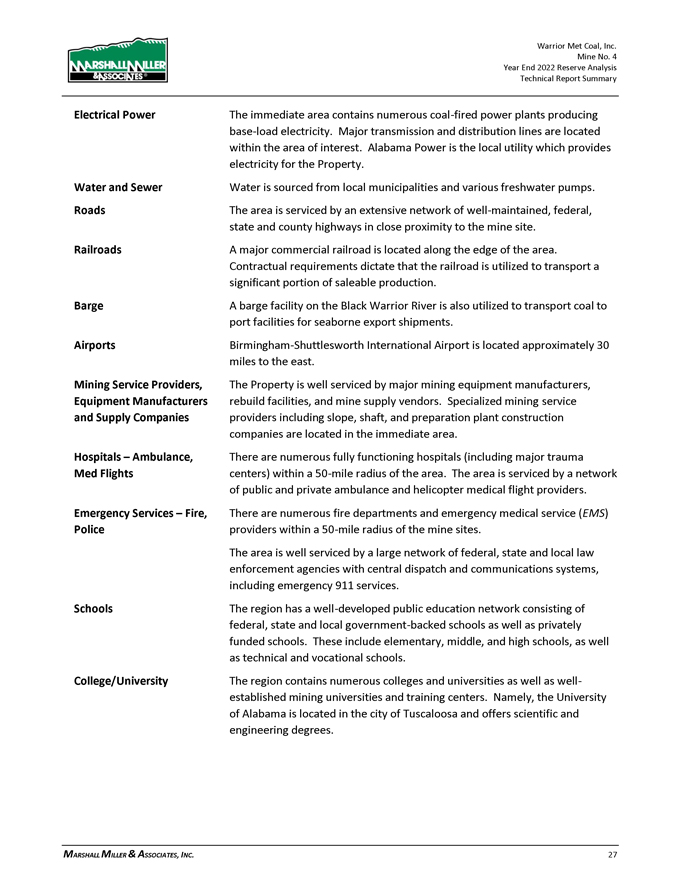
Electrical Power The immediate area contains numerous coal-fired power plants producing base-load electricity. Major transmission and distribution lines are located within the area of interest. Alabama Power is the local utility which provides electricity for the Property. Water and Sewer Water is sourced from local municipalities and various freshwater pumps. Roads The area is serviced by an extensive network of well-maintained, federal, state and county highways in close proximity to the mine site. Railroads A major commercial railroad is located along the edge of the area. Contractual requirements dictate that the railroad is utilized to transport a significant portion of saleable production. Barge A barge facility on the Black Warrior River is also utilized to transport coal to port facilities for seaborne export shipments. Airports Birmingham-Shuttlesworth International Airport is located approximately 30 miles to the east. Mining Service Providers, The Property is well serviced by major mining equipment manufacturers, Equipment Manufacturers rebuild facilities, and mine supply vendors. Specialized mining service and Supply Companies providers including slope, shaft, and preparation plant construction companies are located in the immediate area. Hospitals – Ambulance, There are numerous fully functioning hospitals (including major trauma Med Flights centers) within a 50-mile radius of the area. The area is serviced by a network of public and private ambulance and helicopter medical flight providers. Emergency Services – Fire, There are numerous fire departments and emergency medical service (EMS) Police providers within a 50-mile radius of the mine sites. The area is well serviced by a large network of federal, state and local law enforcement agencies with central dispatch and communications systems, including emergency 911 services. Schools The region has a well-developed public education network consisting of federal, state and local government-backed schools as well as privately funded schools. These include elementary, middle, and high schools, as well as technical and vocational schools. College/University The region contains numerous colleges and universities as well as well-established mining universities and training centers. Namely, the University of Alabama is located in the city of Tuscaloosa and offers scientific and engineering degrees. MARSHALL MILLER & ASSOCIATES, INC. 27

5 History 5.1 Previous Operation Mine No. 4 was opened by Walter in 1974. Following the bankruptcy of Walter in 2015, Warrior Met acquired the assets of Walter in 2016. 5.2 Previous Exploration The Property has been extensively explored as early as 1916 and as recently as 2022 by subsurface drilling efforts carried out by numerous entities, the majority of which were completed prior to acquisition by Warrior Met including: Tennessee Coal, Iron & Railroad Company; U.S. Steel; The Pittsburgh & Midway (P&M) Coal Mining Company/Chevron; and Walter. The majority of the drilling was accomplished by means of conventional core hole exploration and air rotary drilling with geophysical logging for CBM wells. 6 Geological Setting, Mineralization and Deposit 6.1 Regional, Local and Property Geology The Black Warrior coal basin (BWB), which encompasses the subject Property, is a foreland basin covering approximately 23,000 square miles (59,570 square kilometers) of northwestern and central Alabama. The basin extends approximately 230 miles from west to east and 188 miles from north to south. The BWB lies within the Cumberland Plateau portion of the Appalachian Highlands and contains Pennsylvanian System (300 million years) sedimentary coal-bearing strata of the Upper Pottsville Formation. Metallurgical coal deposits in northern Alabama are divided into three coal fields; the Black Warrior, the Cahaba, and the Coosa, of which the Black Warrior is the largest in both size and productivity. Of the coal groups within the BWB, historically the most dominant is the Mary Lee group (see Figure 6-1). This sequence is “tagged” or identified with a 4-digit numeric system that typically includes the following strata (in descending stratigraphic order): > 7200 / 7300 – New Castle (typically present as Upper and Lower benches), 30 to 50 feet above the Mary Lee seam > 7400 – Mary Lee seam > 7450 – Middleman (rock parting) > 7480 – Rider seam (not always present) – included as part of the Middleman > 7490 – Parting between the Rider and Blue Creek seams (not always present) – included as part of the Middleman MARSHALL MILLER & ASSOCIATES, INC. 28

> 7500 – Blue Creek seam > 7600 – Jagger seam, where present, typically a few feet to tens of feet below the Blue Creek; however, may locally become part of the mineable section with the overlying Blue Creek seam. Figure 6-1: Geologic Column of the Mary Lee – Blue Creek Sequence The BWB is bound by the Alabama Valley and Ridge, Highland Rim, and East Gulf Coastal Plain physiographic providences. The southwestern and southeastern margins of the basin are terminated MARSHALL MILLER & ASSOCIATES, INC. 29
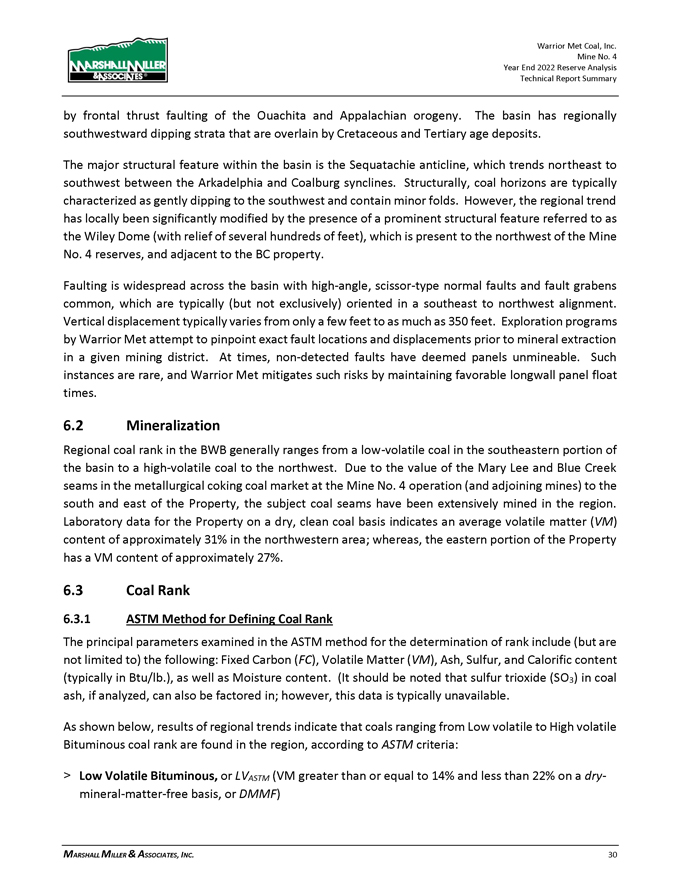
by frontal thrust faulting of the Ouachita and Appalachian orogeny. The basin has regionally southwestward dipping strata that are overlain by Cretaceous and Tertiary age deposits. The major structural feature within the basin is the Sequatachie anticline, which trends northeast to southwest between the Arkadelphia and Coalburg synclines. Structurally, coal horizons are typically characterized as gently dipping to the southwest and contain minor folds. However, the regional trend has locally been significantly modified by the presence of a prominent structural feature referred to as the Wiley Dome (with relief of several hundreds of feet), which is present to the northwest of the Mine No. 4 reserves, and adjacent to the BC property. Faulting is widespread across the basin with high-angle, scissor-type normal faults and fault grabens common, which are typically (but not exclusively) oriented in a southeast to northwest alignment. Vertical displacement typically varies from only a few feet to as much as 350 feet. Exploration programs by Warrior Met attempt to pinpoint exact fault locations and displacements prior to mineral extraction in a given mining district. At times, non-detected faults have deemed panels unmineable. Such instances are rare, and Warrior Met mitigates such risks by maintaining favorable longwall panel float times. 6.2 Mineralization Regional coal rank in the BWB generally ranges from a low-volatile coal in the southeastern portion of the basin to a high-volatile coal to the northwest. Due to the value of the Mary Lee and Blue Creek seams in the metallurgical coking coal market at the Mine No. 4 operation (and adjoining mines) to the south and east of the Property, the subject coal seams have been extensively mined in the region. Laboratory data for the Property on a dry, clean coal basis indicates an average volatile matter (VM) content of approximately 31% in the northwestern area; whereas, the eastern portion of the Property has a VM content of approximately 27%. 6.3 Coal Rank 6.3.1 ASTM Method for Defining Coal Rank The principal parameters examined in the ASTM method for the determination of rank include (but are not limited to) the following: Fixed Carbon (FC), Volatile Matter (VM), Ash, Sulfur, and Calorific content (typically in Btu/lb.), as well as Moisture content. (It should be noted that sulfur trioxide (SO3) in coal ash, if analyzed, can also be factored in; however, this data is typically unavailable. As shown below, results of regional trends indicate that coals ranging from Low volatile to High volatile Bituminous coal rank are found in the region, according to ASTM criteria: > Low Volatile Bituminous, or LVASTM (VM greater than or equal to 14% and less than 22% on a dry-mineral-matter-free basis, or DMMF) MARSHALL MILLER & ASSOCIATES, INC. 30

> Medium Volatile Bituminous, or MVASTM (VM greater than or equal to 22% and less than 31% on a dry-mineral-matter-free basis, or DMMF) > High Volatile A Bituminous, or HVAASTM (VM greater than 31% on a dry-mineral-matter-free basis, or DMMF, and calorific content greater than or equal to 14,000 Btu/lb. on a moist-mineral-matter-free basis) > High Volatile B Bituminous, or HVBASTM (greater than or equal to 13,000 and less than 14,000 Btu/lb.) Furthermore, utilizing ASTM criteria, coal rank for the coals sampled on the Property range from Medium Volatile to High Volatile bituminous. Figure 6-2: Classification of Coals by Rank (as per ASTM Standard D 388) 6.3.2 Coal Quality Parameters Associated with Market-based Coal Rank It is important to note that market-based parameters are significantly different from definitions defined by ASTM for coal rank. ASTM rank is not defined by favorability in the marketplace. Coal quality parameters analyzed to define the market-based coal rank typically include, but are not limited to: > Volatile Matter% (dry basis) MARSHALL MILLER & ASSOCIATES, INC. 31
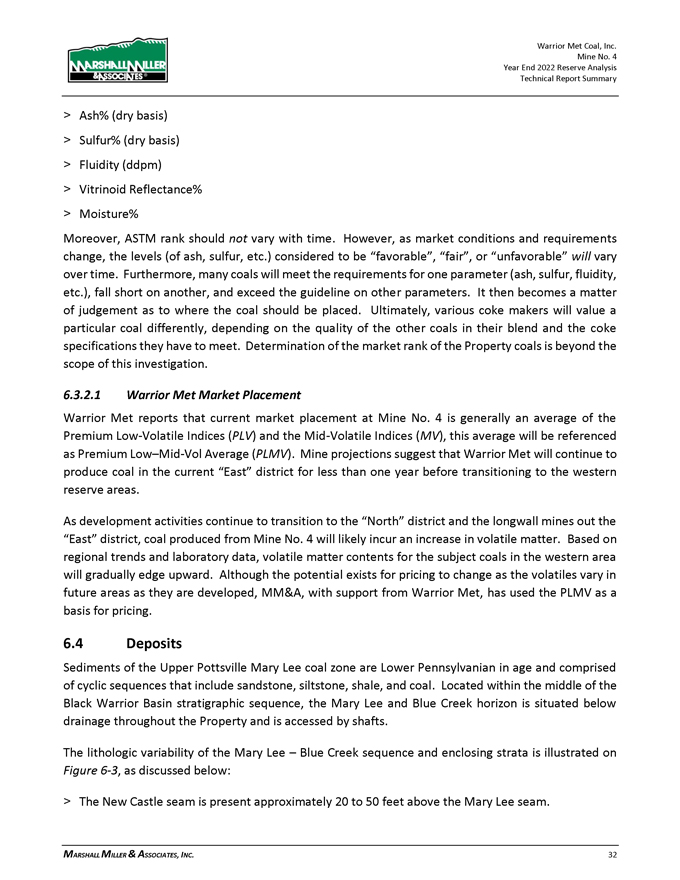
> Ash% (dry basis) > Sulfur% (dry basis) > Fluidity (ddpm) > Vitrinoid Reflectance% > Moisture% Moreover, ASTM rank should not vary with time. However, as market conditions and requirements change, the levels (of ash, sulfur, etc.) considered to be “favorable”, “fair”, or “unfavorable”will vary over time. Furthermore, many coals will meet the requirements for one parameter (ash, sulfur, fluidity, etc.), fall short on another, and exceed the guideline on other parameters. It then becomes a matter of judgement as to where the coal should be placed. Ultimately, various coke makers will value a particular coal differently, depending on the quality of the other coals in their blend and the coke specifications they have to meet. Determination of the market rank of the Property coals is beyond the scope of this investigation. 6.3.2.1 Warrior Met Market Placement Warrior Met reports that current market placement at Mine No. 4 is generally an average of the Premium Low-Volatile Indices (PLV) and the Mid-Volatile Indices (MV), this average will be referenced as Premium Low–Mid-Vol Average (PLMV). Mine projections suggest that Warrior Met will continue to produce coal in the current “East” district for less than one year before transitioning to the western reserve areas. As development activities continue to transition to the “North” district and the longwall mines out the “East” district, coal produced from Mine No. 4 will likely incur an increase in volatile matter. Based on regional trends and laboratory data, volatile matter contents for the subject coals in the western area will gradually edge upward. Although the potential exists for pricing to change as the volatiles vary in future areas as they are developed, MM&A, with support from Warrior Met, has used the PLMV as a basis for pricing. 6.4 Deposits Sediments of the Upper Pottsville Mary Lee coal zone are Lower Pennsylvanian in age and comprised of cyclic sequences that include sandstone, siltstone, shale, and coal. Located within the middle of the Black Warrior Basin stratigraphic sequence, the Mary Lee and Blue Creek horizon is situated below drainage throughout the Property and is accessed by shafts. The lithologic variability of the Mary Lee – Blue Creek sequence and enclosing strata is illustrated on Figure 6-3, as discussed below: > The New Castle seam is present approximately 20 to 50 feet above the Mary Lee seam. MARSHALL MILLER & ASSOCIATES, INC. 32
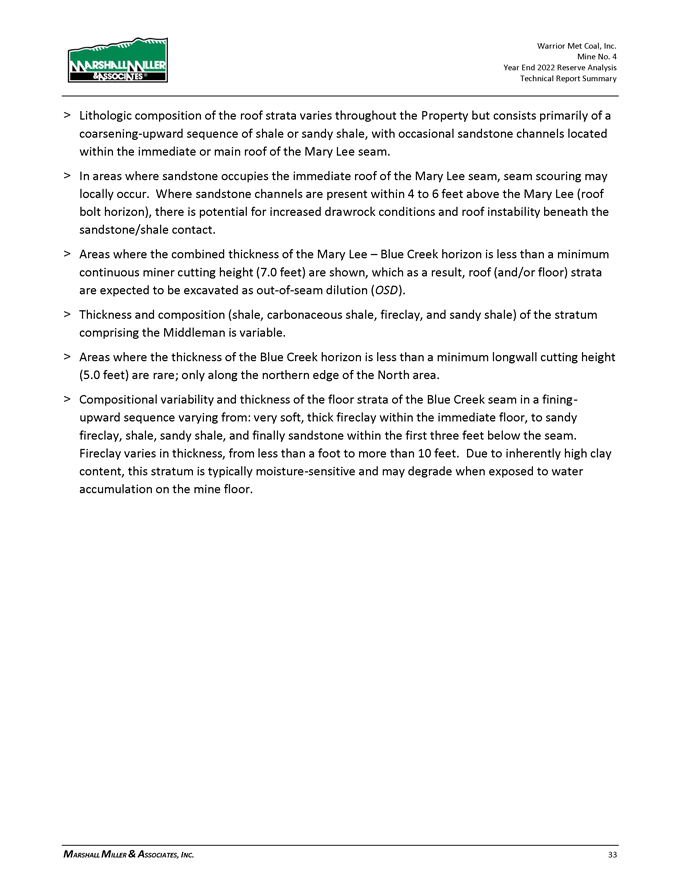
> Lithologic composition of the roof strata varies throughout the Property but consists primarily of a coarsening-upward sequence of shale or sandy shale, with occasional sandstone channels located within the immediate or main roof of the Mary Lee seam. > In areas where sandstone occupies the immediate roof of the Mary Lee seam, seam scouring may locally occur. Where sandstone channels are present within 4 to 6 feet above the Mary Lee (roof bolt horizon), there is potential for increased drawrock conditions and roof instability beneath the sandstone/shale contact. > Areas where the combined thickness of the Mary Lee – Blue Creek horizon is less than a minimum continuous miner cutting height (7.0 feet) are shown, which as a result, roof (and/or floor) strata are expected to be excavated as out-of-seam dilution (OSD). > Thickness and composition (shale, carbonaceous shale, fireclay, and sandy shale) of the stratum comprising the Middleman is variable. > Areas where the thickness of the Blue Creek horizon is less than a minimum longwall cutting height (5.0 feet) are rare; only along the northern edge of the North area. > Compositional variability and thickness of the floor strata of the Blue Creek seam in a fining-upward sequence varying from: very soft, thick fireclay within the immediate floor, to sandy fireclay, shale, sandy shale, and finally sandstone within the first three feet below the seam. Fireclay varies in thickness, from less than a foot to more than 10 feet. Due to inherently high clay content, this stratum is typically moisture-sensitive and may degrade when exposed to water accumulation on the mine floor. MARSHALL MILLER & ASSOCIATES, INC. 33

Figure 6-3: Mine No. 4 Stratigraphic Relationships 6.4.1 Mineable Seam Thickness Configurations The mineable seam configuration of Mine No. 4 consists of the Mary Lee, Middleman, and Blue Creek seams, also referred to as “twin seam” mining, with the following thickness ranges. > The Mary Lee averages approximately 1.3-feet throughout the mine plan area. Detailed seam mapping exhibits are retained in MM&A’s files but are not included with this report. > Between the two seams, the “Middleman” parting averages around 1.6-feet; the parting generally thickens to the southeast. > The Blue Creek seam, which typically represents the better metallurgical quality than the overlying Mary Lee seam, typically averages around 3.5-feet (Detailed seam mapping exhibits are retained in MM&A’s files but are not included with this report.) MARSHALL MILLER & ASSOCIATES, INC. 34
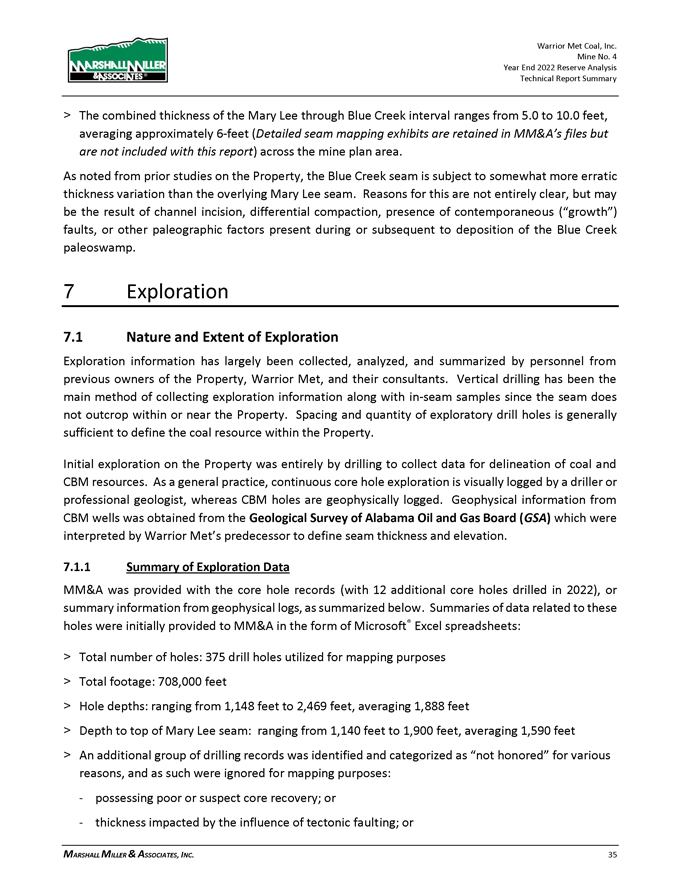
> The combined thickness of the Mary Lee through Blue Creek interval ranges from 5.0 to 10.0 feet, averaging approximately 6-feet (Detailed seam mapping exhibits are retained in MM&A’s files but are not included with this report) across the mine plan area. As noted from prior studies on the Property, the Blue Creek seam is subject to somewhat more erratic thickness variation than the overlying Mary Lee seam. Reasons for this are not entirely clear, but may be the result of channel incision, differential compaction, presence of contemporaneous (“growth”) faults, or other paleographic factors present during or subsequent to deposition of the Blue Creek paleoswamp. 7 Exploration 7.1 Nature and Extent of Exploration Exploration information has largely been collected, analyzed, and summarized by personnel from previous owners of the Property, Warrior Met, and their consultants. Vertical drilling has been the main method of collecting exploration information along with in-seam samples since the seam does not outcrop within or near the Property. Spacing and quantity of exploratory drill holes is generally sufficient to define the coal resource within the Property. Initial exploration on the Property was entirely by drilling to collect data for delineation of coal and CBM resources. As a general practice, continuous core hole exploration is visually logged by a driller or professional geologist, whereas CBM holes are geophysically logged. Geophysical information from CBM wells was obtained from the Geological Survey of Alabama Oil and Gas Board (GSA) which were interpreted by Warrior Met’s predecessor to define seam thickness and elevation. 7.1.1 Summary of Exploration Data MM&A was provided with the core hole records (with 12 additional core holes drilled in 2022), or summary information from geophysical logs, as summarized below. Summaries of data related to these holes were initially provided to MM&A in the form of Microsoft® Excel spreadsheets: > Total number of holes: 375 drill holes utilized for mapping purposes > Total footage: 708,000 feet > Hole depths: ranging from 1,148 feet to 2,469 feet, averaging 1,888 feet > Depth to top of Mary Lee seam: ranging from 1,140 feet to 1,900 feet, averaging 1,590 feet > An additional group of drilling records was identified and categorized as “not honored” for various reasons, and as such were ignored for mapping purposes: —possessing poor or suspect core recovery; or —thickness impacted by the influence of tectonic faulting; or MARSHALL MILLER & ASSOCIATES, INC. 35
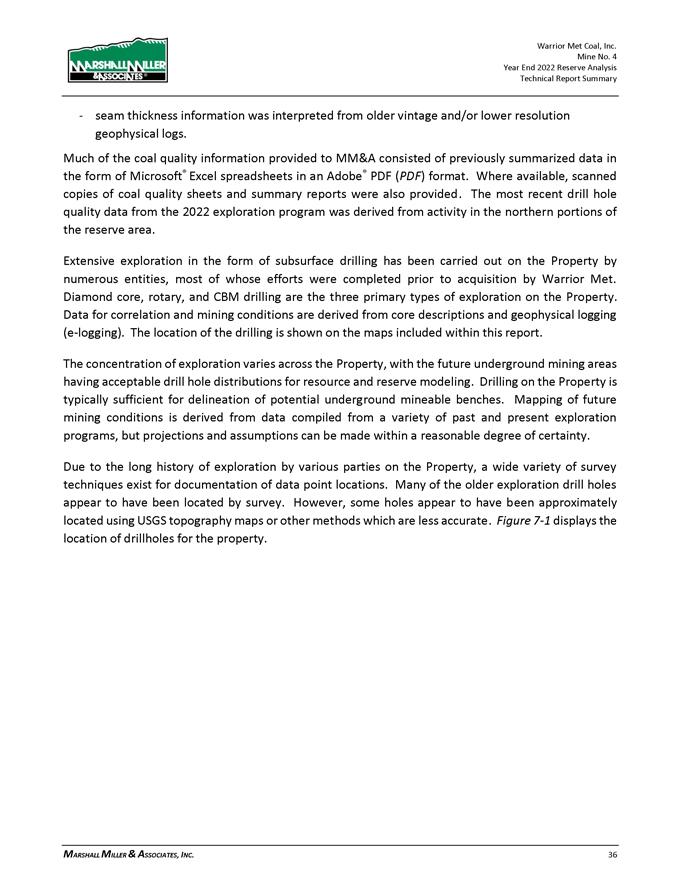
—seam thickness information was interpreted from older vintage and/or lower resolution geophysical logs. Much of the coal quality information provided to MM&A consisted of previously summarized data in the form of Microsoft® Excel spreadsheets in an Adobe® PDF (PDF) format. Where available, scanned copies of coal quality sheets and summary reports were also provided. The most recent drill hole quality data from the 2022 exploration program was derived from activity in the northern portions of the reserve area. Extensive exploration in the form of subsurface drilling has been carried out on the Property by numerous entities, most of whose efforts were completed prior to acquisition by Warrior Met. Diamond core, rotary, and CBM drilling are the three primary types of exploration on the Property. Data for correlation and mining conditions are derived from core descriptions and geophysical logging (e-logging). The location of the drilling is shown on the maps included within this report. The concentration of exploration varies across the Property, with the future underground mining areas having acceptable drill hole distributions for resource and reserve modeling. Drilling on the Property is typically sufficient for delineation of potential underground mineable benches. Mapping of future mining conditions is derived from data compiled from a variety of past and present exploration programs, but projections and assumptions can be made within a reasonable degree of certainty. Due to the long history of exploration by various parties on the Property, a wide variety of survey techniques exist for documentation of data point locations. Many of the older exploration drill holes appear to have been located by survey. However, some holes appear to have been approximately located using USGS topography maps or other methods which are less accurate. Figure 7-1 displays the location of drillholes for the property. MARSHALL MILLER & ASSOCIATES, INC. 36

Figure 7-1: Drill Hole Location Map 7.2 Non-Drilling Procedures and Parameters Some analyses, such as rheological and petrographic properties, and sulfur types, are not as prevalent as others in the testing done on samples recovered by drilling. To supplement the information database, samples have been collected from mine stockpiles and either truck or train shipment samples. Additionally, Warrior Met conducts regular channel sampling in its active underground works as a means of predicting coal quality and tonnages. Channel samples are generally obtained in headgate and tailgate development sections prior to longwall mining. MARSHALL MILLER & ASSOCIATES, INC. 37

7.3 Drilling Procedures Core drilling methods utilize NX-size (21/ inch) or similar-sized core cylinders to recover core samples, 8 which can be used to delineate geologic characteristics, and for coal quality testing and geotechnical logging. In addition to the core holes, rotary drilled holes also exist on most of the Property. Data for the rotary drilled holes are mainly derived from downhole geophysical logs, which are used to interpret coal and rock thickness and depth since logging of the drill cuttings is not reliable. CBM holes are always logged geophysically, and the resulting interpreted data are incorporated into the geological model. Exploratory drilling generally requires drilling to depths from 1,140 to 1,900 feet to penetrate the target coal seams on the Property. A wide variety of core-logging techniques exist for the Property. For many of the core holes, the primary data source is a generalized lithology description by the driller, which may be supplemented by a more detailed core log completed by a geologist. These drilling logs were provided to MM&A as a geological database. MM&A geologists were not involved in the production of original core logs but did perform a basic check of information within the provided database. 7.4 Hydrology Mine No. 4 is an active mine and Warrior Met reports that it has experienced minimal hydrologic concerns or material issues. Notably, the operation recently completed development under the Black Warrior River to access its northern reserve areas. Future mining is projected to occur in areas exhibiting similar hydrogeological conditions as past mining including stream undermining, undermining of aquifers and mining through hydraulically fractured (frac’d) coalbed methane wells. Based upon the successful history of the operation with regards to hydrogeological features, MM&A assumes that the operation will not be hindered by such issues in the future. 7.5 Geotechnical Data The general mining plan for this underground mine was developed by Warrior Met. Section layouts, pillar sizes, and panel dimensions largely mimic what Warrior Met has recently utilized in its active sections. Depths of cover should not significantly change over the life of the operation in comparison to current and historic values. Warrior Met and its predecessor have successfully mined adjacent to and through faults without significant geotechnical issues. MM&A does not anticipate that geotechnical issues will significantly hinder development or longwall mining activity for the mine plan presented in this TRS. MARSHALL MILLER & ASSOCIATES, INC. 38

8 Sample Preparation Analyses and Security 8.1 Prior to Sending to the Lab Most of the coal samples have been obtained from the Property by subsurface exploration using core drilling techniques. The protocol for preparing and testing the samples has varied over time and is not well documented for the older holes drilled on the Property. Typical core-drilling sampling methods for coal in the United States involves drilling through the seam, removing the core from the barrel, describing the lithology, wrapping the sample in a sealed plastic sleeve and placing it lengthwise into a covered core box, and carefully marking hole ID and depth intervals on each box and lid, allowing the core to be delivered to a laboratory in correct stratigraphic order, and with original moisture content. This process has been the norm for both historical and ongoing exploration activities at the Property. This work is typically performed by the supervising driller, geologist, or company personnel. Samples are most often delivered to the company by the driller after each shift or acquired by company personnel or representatives. Most of the coal core samples were obtained by previous or current operators on the Property. MM&A did not participate in the collection, sampling, and analysis of the core samples. However, it is reasonable to assume, given the consistency of quality from previous operators, that these samples were generally collected and processed under industry best practices. This assumption is based on MM&A’s familiarity with the operating companies and the companies used to perform the analyses. 8.2 Lab Procedures Coal-quality testing has been performed over many years by operating companies using different laboratories and testing regimens. Some of the samples have raw analyses and washabilities on the full seam (with coal and rock parting layers co-mingled) and are mainly useful for characterizing the coal quality for projected production from underground mining. Other samples have coal and rock analyzed separately, the results of which can be manipulated to forecast underground mining quality. Care has been taken to use only those analyses that are representative of the coal quality parameters for the appropriate mining type for each sample. Standard procedure upon receipt of core samples by the testing laboratory is to: 1) log the depth and thickness of the sample; then 2) perform testing as specified by a representative of the operating company. Each sample is then analyzed in accordance with procedures defined under American Society for Testing and Materials (ASTM) standards including, but not limited to washability (ASTM D4371); ash (ASTM D3174); sulfur (ASTM D4239); Btu/lb. (ASTM D5865); volatile matter (ASTM D3175); Free Swell Index (FSI) (ASTM D720). While not confirmed by MM&A, it is assumed that best practices and ASTM (or equivalent standards at the time of testing) were utilized in laboratory quality testing. MARSHALL MILLER & ASSOCIATES, INC. 39
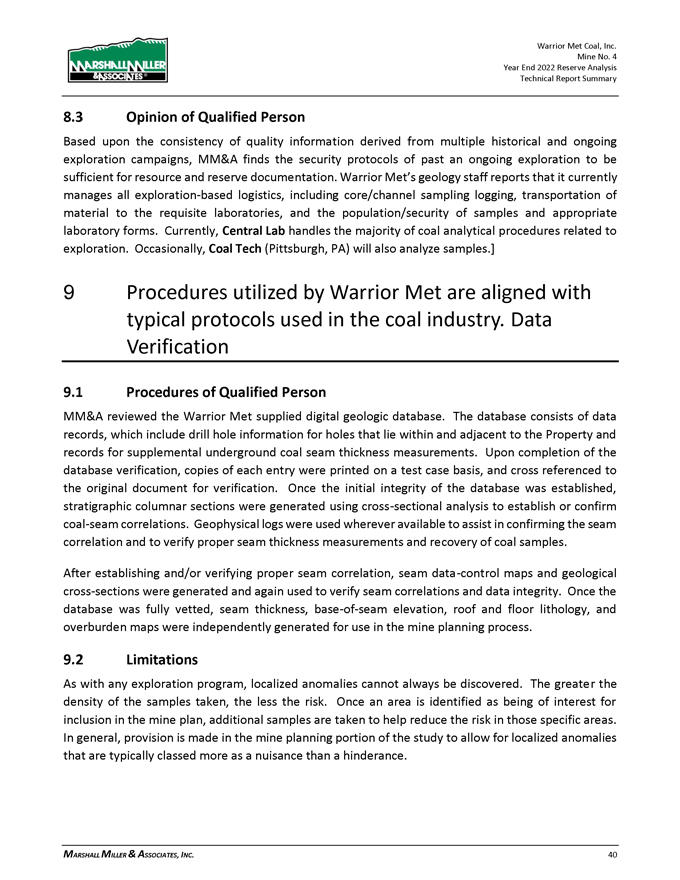
8.3 Opinion of Qualified Person Based upon the consistency of quality information derived from multiple historical and ongoing exploration campaigns, MM&A finds the security protocols of past an ongoing exploration to be sufficient for resource and reserve documentation. Warrior Met’s geology staff reports that it currently manages all exploration-based logistics, including core/channel sampling logging, transportation of material to the requisite laboratories, and the population/security of samples and appropriate laboratory forms. Currently, Central Lab handles the majority of coal analytical procedures related to exploration. Occasionally, Coal Tech (Pittsburgh, PA) will also analyze samples.] 9 Procedures utilized by Warrior Met are aligned with typical protocols used in the coal industry. Data Verification 9.1 Procedures of Qualified Person MM&A reviewed the Warrior Met supplied digital geologic database. The database consists of data records, which include drill hole information for holes that lie within and adjacent to the Property and records for supplemental underground coal seam thickness measurements. Upon completion of the database verification, copies of each entry were printed on a test case basis, and cross referenced to the original document for verification. Once the initial integrity of the database was established, stratigraphic columnar sections were generated using cross-sectional analysis to establish or confirm coal-seam correlations. Geophysical logs were used wherever available to assist in confirming the seam correlation and to verify proper seam thickness measurements and recovery of coal samples. After establishing and/or verifying proper seam correlation, seam data-control maps and geological cross-sections were generated and again used to verify seam correlations and data integrity. Once the database was fully vetted, seam thickness, base-of-seam elevation, roof and floor lithology, and overburden maps were independently generated for use in the mine planning process. 9.2 Limitations as with any exploration program, localized anomalies cannot always be discovered. The greater the density of the samples taken, the less the risk. Once an area is identified as being of interest for inclusion in the mine plan, additional samples are taken to help reduce the risk in those specific areas. In general, provision is made in the mine planning portion of the study to allow for localized anomalies that are typically classed more as a nuisance than a hindrance. MARSHALL MILLER & ASSOCIATES, INC. 40
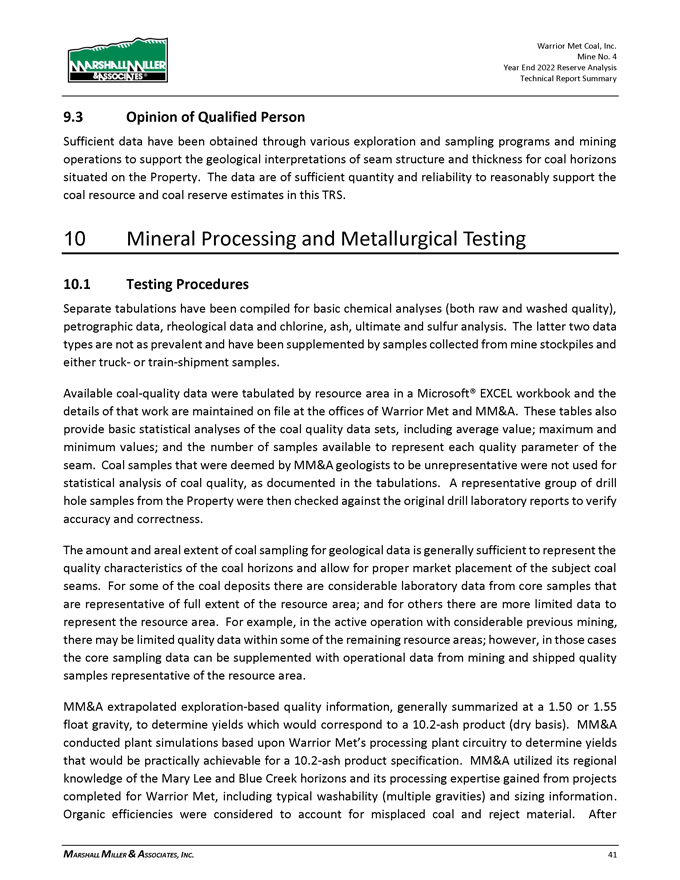
9.3 Opinion of Qualified Person Sufficient data have been obtained through various exploration and sampling programs and mining operations to support the geological interpretations of seam structure and thickness for coal horizons situated on the Property. The data are of sufficient quantity and reliability to reasonably support the coal resource and coal reserve estimates in this TRS. 10 Mineral Processing and Metallurgical Testing 10.1 Testing Procedures Separate tabulations have been compiled for basic chemical analyses (both raw and washed quality), petrographic data, rheological data and chlorine, ash, ultimate and sulfur analysis. The latter two data types are not as prevalent and have been supplemented by samples collected from mine stockpiles and either truck- or train-shipment samples. Available coal-quality data were tabulated by resource area in a Microsoft® EXCEL workbook and the details of that work are maintained on file at the offices of Warrior Met and MM&A. These tables also provide basic statistical analyses of the coal quality data sets, including average value; maximum and minimum values; and the number of samples available to represent each quality parameter of the seam. Coal samples that were deemed by MM&A geologists to be unrepresentative were not used for statistical analysis of coal quality, as documented in the tabulations. A representative group of drill hole samples from the Property were then checked against the original drill laboratory reports to verify accuracy and correctness. The amount and areal extent of coal sampling for geological data is generally sufficient to represent the quality characteristics of the coal horizons and allow for proper market placement of the subject coal seams. For some of the coal deposits there are considerable laboratory data from core samples that are representative of full extent of the resource area; and for others there are more limited data to represent the resource area. For example, in the active operation with considerable previous mining, there may be limited quality data within some of the remaining resource areas; however, in those cases the core sampling data can be supplemented with operational data from mining and shipped quality samples representative of the resource area. MM&A extrapolated exploration-based quality information, generally summarized at a 1.50 or 1.55 float gravity, to determine yields which would correspond to a 10.2-ash product (dry basis). MM&A conducted plant simulations based upon Warrior Met’s processing plant circuitry to determine yields that would be practically achievable for a 10.2-ash product specification. MM&A utilized its regional knowledge of the Mary Lee and Blue Creek horizons and its processing expertise gained from projects completed for Warrior Met, including typical wash ability (multiple gravities) and sizing information. Organic efficiencies were considered to account for misplaced coal and reject material. After MARSHALL MILLER & ASSOCIATES, INC. 41
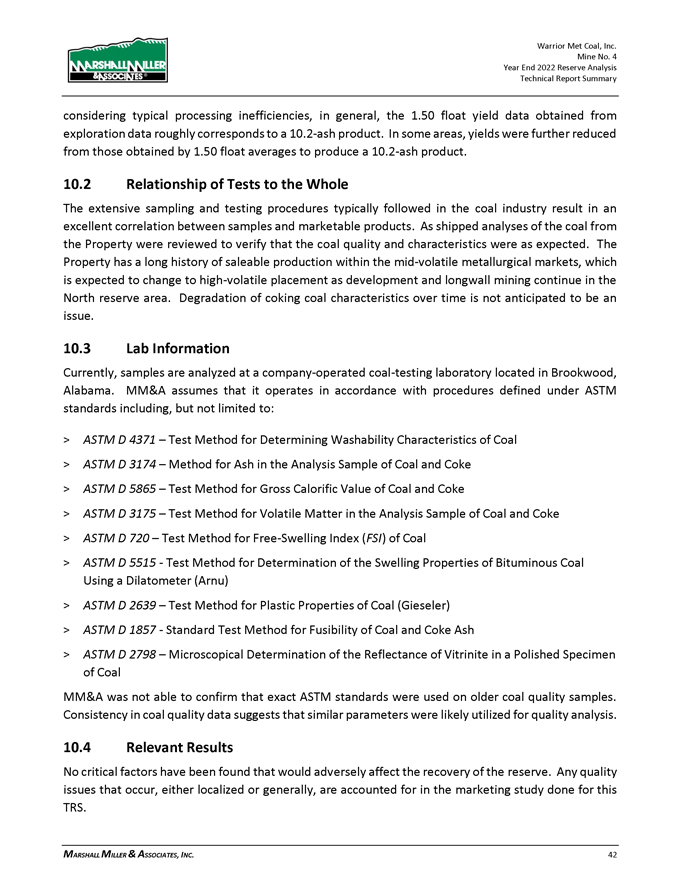
considering typical processing inefficiencies, in general, the 1.50 float yield data obtained from exploration data roughly corresponds to a 10.2-ash product. In some areas, yields were further reduced from those obtained by 1.50 float averages to produce a 10.2-ash product. 10.2 Relationship of Tests to the Whole The extensive sampling and testing procedures typically followed in the coal industry result in an excellent correlation between samples and marketable products. As shipped analyses of the coal from the Property were reviewed to verify that the coal quality and characteristics were as expected. The Property has a long history of saleable production within the mid-volatile metallurgical markets, which is expected to change to high-volatile placement as development and long wall mining continue in the North reserve area. Degradation of coking coal characteristics over time is not anticipated to be an issue. 10.3 Lab Information Currently, samples are analyzed at a company-operated coal-testing laboratory located in Brook wood, Alabama. MM&A assumes that it operates in accordance with procedures defined under ASTM standards including, but not limited to: > ASTM D 4371 – Test Method for Determining Wash ability Characteristics of Coal > ASTM D 3174 – Method for Ash in the Analysis Sample of Coal and Coke > ASTM D 5865 – Test Method for Gross Calorific Value of Coal and Coke > ASTM D 3175 – Test Method for Volatile Matter in the Analysis Sample of Coal and Coke > ASTM D 720 – Test Method for Free-Swelling Index (FSI) of Coal > ASTM D 5515 - Test Method for Determination of the Swelling Properties of Bituminous Coal Using a Dilatometer (Arno) > ASTM D 2639 – Test Method for Plastic Properties of Coal (Gisele) > ASTM D 1857 - Standard Test Method for Fusibility of Coal and Coke Ash > ASTM D 2798 – Microscopically Determination of the Reflectance of Vitrine in a Polished Specimen of Coal MM&A was not able to confirm that exact ASTM standards were used on older coal quality samples. Consistency in coal quality data suggests that similar parameters were likely utilized for quality analysis. 10.4 Relevant Results No critical factors have been found that would adversely affect the recovery of the reserve. Any quality issues that occur, either localized or generally, are accounted for in the marketing study done for this TRS. MARSHALL MILLER & ASSOCIATES, INC. 42

10.5 Pertinent Results and Opinion of the Qualified Person Wash recovery factors on a seam-by-seam basis, exclusive of dilution material, is summarized in the table below. Additionally, wash recovery estimates on a LOM basis are included, reflective of dilution material. Table 10-1: Summary of Wash Recovery Assumptions (Mine 4) Seam Basis Wash Recovery (%) Area 5/East Mary Lee & Blue Creek Simulations to Achieve 10.2% Ash Product 78.9% Area 6/North Mary Lee Simulations to Achieve 10.2% Ash Product 83.8% Blue Creek 78.5% LOM Mary Lee + Blue Creek + Dilution Above Assumptions + Consideration of Dilution 49.2% The Qualified Persons finds that the metallurgical and mineral processing information derived from historical and ongoing exploration campaigns is adequate to document mineral resources and reserves presented herein. The distribution of quality information has been considered in measured and indicated resource status, and subsequently in probable and proven reserve status. Warrior Met’s ongoing drilling campaigns are addressing short-term and long-term quality projections. 11 Mineral Resource Estimates MM&A independently created a geologic model to define the coal resources at the Property. Coal resources were estimated as of December 31, 2022. Resources are reported inclusive of coal reserves for Mine No. 4. The resources presented herein are utilized for mine planning purposes, and subsequently, reserve estimates. Resources are not reported in addition to coal reserves. There are no resources exclusive of reserves included in this TRS. Due to constraints imposed by differences in coal quality testing methodology, resources represent in-place coal tonnages and in-place coal quality, exclusive of the interbred between the Mary Lee and Blue Creek seams (a.k.a. Middleman). Ash bands and partings within the Mary Lee and Blue Creek horizons are included in tonnage and quality projections for the property’s resource. Pertinent definitions related to mineral resources are shown below. > Mineral Resource is a concentration or occurrence of material of economic interest in or on the Earth’s crust in such form, grade or quality, and quantity that there are reasonable prospects for economic extraction. A mineral resource is a reasonable estimate of mineralization, taking into account relevant factors such as cut-off grade, likely mining dimensions, location or continuity, that, with the assumed and justifiable technical and economic conditions, is likely to, in whole or in MARSHALL MILLER & ASSOCIATES, INC. 43

part, become economically extractable. It is not merely an inventory of all mineralization drilled or sampled. > Inferred Mineral Resource is that part of a mineral resource for which quantity and grade or quality are estimated on the basis of limited geological evidence and sampling. The level of geological uncertainty associated with an inferred mineral resource is too high to apply relevant technical and economic factors likely to influence the prospects of economic extraction in a manner useful for evaluation of economic viability. Because an inferred mineral resource has the lowest level of geological confidence of all mineral resources, which prevents the application of the modifying factors in a manner useful for evaluation of economic viability, an inferred mineral resource may not be considered when assessing the economic viability of a mining project and may not be converted to a mineral reserve. No inferred mineral resources are considered as part of this exercise. > Indicated Mineral Resource is that part of a mineral resource for which quantity and grade or quality are estimated on the basis of adequate geological evidence and sampling. The level of geological certainty associated with an indicated mineral resource is sufficient to allow a qualified person to apply modifying factors in sufficient detail to support mine planning and evaluation of the economic viability of the deposit. Because an indicated mineral resource has a lower level of confidence than the level of confidence of a measured mineral resource, an indicated mineral resource may only be converted to a probable mineral reserve. > Measured Mineral Resource is that part of a mineral resource for which quantity and grade or quality are estimated on the basis of conclusive geological evidence and sampling. The level of geological certainty associated with a measured mineral resource is sufficient to allow a qualified person to apply modifying factors, as defined in this section, in sufficient detail to support detailed mine planning and final evaluation of the economic viability of the deposit. Because a measured mineral resource has a higher level of confidence than the level of confidence of either an indicated mineral resource or an inferred mineral resource, a measured mineral resource may be converted to a proven mineral reserve or to a probable mineral reserve. 11.1 Assumptions, Parameters and Methodology Geological data was imported into Carlson Mining® (formerly SurvCADD®) geological modelling software in the form of Microsoft® Excel files incorporating drill hole collars, seam and thickness picks, bottom seam elevations and raw and washed coal quality. These data files were validated prior to importing into the software. Once imported, a geologic model was created, reviewed and verified with a key element being a gridded model of coal seam thickness. Resource tones were estimated by using the seam thickness grid based on each valid point of observation and by defining resource confidence arcs around the points of observation. Points of observation for Measured and Indicated confidence arcs were defined for all valid drill holes that intersected the seam using standards deemed acceptable by MM&A based on a detailed geologic evaluation and a statistical analysis of all drill holes within the projected reserve areas as described in Section 11.1.1. The geological evaluation incorporated an MARSHALL MILLER & ASSOCIATES, INC. 44

analysis of seam thickness related to depositional environments, adjacent roof and floor lithology’s, and structural influences. After validating coal seam data and establishing correlations, the thickness and elevation for seams of economic interest were used to generate a geologic model. Due to the relative structural simplicity of the deposits and the reasonable continuity of the tabular coal beds, the principal geological interpretation necessary to define the geometry of the coal deposits is the proper modeling of their thickness and elevation. Both coal thickness and quality data are deemed by MM&A to be reasonably sufficient within the resource areas. Therefore, there is a reasonable level of confidence in the geologic interpretations required for coal resource determination based on the available data and the techniques applied to the data. Table 11-1 below provides the geological mapping and coal tonnage estimation criteria used for the coal resource and reserve evaluation. These cut-off parameters have been developed by MM&A based on its experience with the Warrior Met property and are typical of mining operations in the Black Warrior coal basin. This experience includes technical and economic evaluations of numerous properties in the region for the purposes of determining the economic viability of the subject coal reserves. Table 11-1: General Reserve and Resource Criteria Item Parameters Technical Notes & Exceptions* • General Reserve Criteria Reserve Classification Reserve and Resource Reliability Categories Reserve (Proven and Probable) Measured Resources and Proven Reserves Only Considered Resource (Measured and Indicated) if located with 0.75 miles of a quality location or 0.25 miles of an active mining section. Further, Measured Resources and Proven Reserves Must Be Located with 0.25 miles of a point of observation or active section. Effective Date of Resource Estimate December 31, 2022 Coal resources were updated for depletion based on information from Warrior Met. Effective date for coal resources is as of December 31, 2022. Effective Date of Reserve Estimate December 31, 2022 Coal reserves were updated for depletion based on information from Warrior Met. Effective date for coal reserves is as of December 31, 2022. Seam Density Variable, dependent upon seam characteristics (based on available drill hole quality). • Underground-Mineable Criteria Map Thickness Total seam thickness Minimum Seam Thickness 4.5 feet Minimum Mining Thickness 5.0 Feet for Long wall 7.0 Feet for Continuous Mining Minimum In-Seam Wash Recovery Accounted for in seam thickness cutoffs. Minimum Annual Wash Recovery (inclusive of dilution) of approximately 30%. LOM Average = 47%. Wash Recovery Applied to Coal Reserves Based on average yield for drill holes within reserve area and simulated plant models to produce a 10.2-percent ash product. Out-of-Seam Dilution Thickness for Run- Minimum of 3 inches or delta between mining 2.3 SG used for dilution tonnage estimate of-Mine Tones Applied to Coal Reserves height and total seam (Mary Lee + Blue Creek + Middleman) height. Mine Barrier Not Applicable – Reserves Not Adjacent to Abandoned Works MARSHALL MILLER & ASSOCIATES, INC. 45

Item Parameters Technical Notes & Exceptions* CBM Wells CBM Wells Assumed to be Plugged Ahead of Mining and Mined Through. No reserve/resource reductions considered. Adjustments Applied to Coal Reserves 10 percent moisture increase Note: Exceptions for application of these criteria to reserve estimation are made as warranted and demonstrated by either actual mining experience or detailed data that allows for empirical evaluation of mining conditions. Final classification of coal reserve is made based on the pre-feasibility evaluation. 11.1.1 Geostatistical Analysis for Classification MM&A completed a geostatistical analysis on the Blue Creek’s supporting drill holes within the reserve boundaries to determine the applicability of the common United States classification system for measured and indicated coal resources. Warrior Met’s exploration dataset is unique in that a significant portion of data is sourced from geophysical logs associated with coalbed methane wells. Commonly, geophysical data from some of the earlier-vintage gas well log exhibits (with low-resolution definition) allow identification of coal seams but hinder one’s ability to accurately define precise coal thicknesses and in-seam parting thickness measurements. As such, geological modeling of the subject coal seams excluded low-resolution geophysical thickness interpretations from gas wells; however, seam thicknesses which were derived from higher resolution geophysical logs were utilized. The geostatistical analysis presented herein only includes information utilized for resource and reserve modeling. Historically, the United States has assumed that coal within 0.25 miles of a point of observation represents a measured resource whereas coal between 0.25 miles and 0.75 miles from a point of observation is classified as indicated. Inferred resources are commonly assumed to be located between 0.75 miles and 3 miles from a point of observation. Per SEC regulations, only measured and indicated resources may be considered for reserve classification, respectively as proven and probable reserves. MM&A performed a geostatistical analysis of the Warrior Met data set using the Drill Hole Spacing Analysis (DHSA) method. This method attempts to quantify the uncertainty of applying a measurement from a central location to increasingly larger square blocks and provides recommendations for determining the distances between drill holes for measured, indicated, and inferred resources. To perform DHSA the data set was processed to remove any erroneous data points, clustered data points, as well as directional trends. This was achieved through the use of histograms, as seen in Figure 11-1, color coded scatter plots showing the geospatial positioning of the borings, Figure 11-2, and trend analysis. MARSHALL MILLER & ASSOCIATES, INC. 46

Figure 11-1: Histogram of the Total Seam Thickness Figure 11-2: Scatter plot of the Total Seam for the Mary Lee and Blue Creek Seams Present in Thickness for the Mary Lee and Blue Creek the Mine-4 Complex Seams Present in the Mine-4 Complex Following the completion of data processing, a variogram of the data set was created, Figure 11-3. The variogram plots average square difference against the separation distance between the data pairs. The separation distance is broken up into separate bins defined by a uniform lag distance (e.g., for a lag distance of 499 feet the bins would be 0 – 499 feet, 502 – 1,000 feet, etc.). Each pair of data points that are less than one lag distance apart are reported in the first bin. If the data pair is further apart than one lag distance but less than two lag distances apart, then the variance is reported in the second bin. The numerical average for differences reported for each bin is then plotted on the variogram. Care was taken to define the lag distance in such a way as to not overestimate any nugget effect present in the data set. Lastly, modeled equations, often spherical, gaussian, or exponential, are applied to the variogram in order to represent the data set across a continuous spectrum. MARSHALL MILLER & ASSOCIATES, INC. 47

Figure 11-3: Variogram of the Total Seam Thickness for the Mary Lee and Blue Creek Seams Present in the Mine-4 Complex The estimation variance is then calculated using information from the modeled variogram as well as charts published by Journel and Huijbregts (1978). This value estimates the variance from applying a single central measurement to increasingly larger square blocks. Care was taken to ensure any nugget effect present was added back into the data. This process was repeated for each test block size. The final step of the process is to calculate the global estimation variance. In this step the number square blocks that would fit inside the selected study area is determined for each block size that was investigated in the previous step. The estimation variance is then divided by the number of blocks that would fit inside the study area for each test block size. Following this determination, the data is then transformed back to represent the relative error in the 95th-percentile range. Figure 11-4 shows the results of the DHSA performed on the Blue Creek seam data for Mine No. 4. DHSA provides hole to hole spacing values, these distances need to be converted to radius from a central point in order to compare to the historical standards. A summary of the radius data is shown in Table 11-2. DHSA prescribes measured, indicated, and inferred drill hole spacings be determined at the 10-percent, 20-percent, and 50-percent levels of relative error, respectively. MARSHALL MILLER & ASSOCIATES, INC. 48

Figure 11-4: Result of DHSA for the Mary Lee and Blue Creek Seams Present in the Mine-4 Complex Table 11-2: DHSA Results Summary for Radius from a Central Point Measured Radial Distance Indicated Radial Distance Inferred Radial Distance Model: (10% Relative Error) (20% Relative Error) (50% Relative Error) (mi) (mi) (mi) Gaussian: 0.37 0.68 1.63 Spherical: 0.37 0.68 1.63 Exponential: 0.38 0.72 1.73 Comparing the results of the DHSA to the historical standards, it is evident that the historical standards are more conservative than even the most conservative DHSA model with regards to determining measured resources. The Gaussian and Spherical models recommend using a radius of 0.37 miles for measured resources compared to the historical value of 0.25 miles. With respect to indicated resources the DHSA falls in line closely with the historical standards. The Gaussian and Spherical models recommend using a radius of 0.68 miles, while the Exponential model recommends a radius of 0.72 miles. These values align closely with the historical radius of 0.75 miles. These results have led the QP’s to report the data following the historical classification standards, rather than use the results of the DHSA. 11.1.1.1 Additional Commentary on Measured and Indicated Breakdowns As previously mentioned, Warrior Met’s exploration dataset is unique in that it includes data derived from low-resolution and higher-resolution geophysical logs. Although the low-resolution data is not used for geological modeling to support resource and reserve calculations, it is valuable to confirm the MARSHALL MILLER & ASSOCIATES, INC. 49
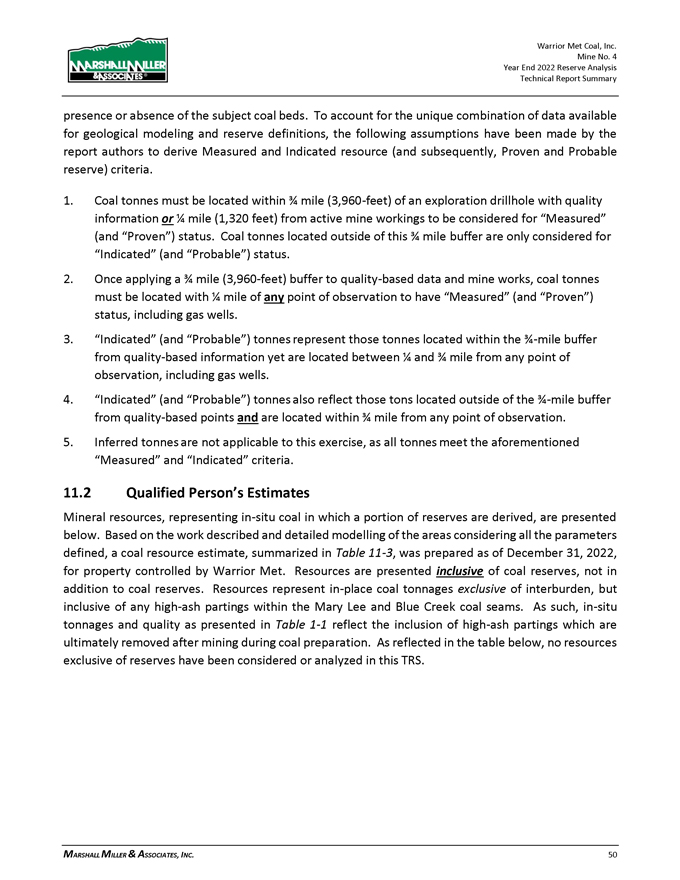
presence or absence of the subject coal beds. To account for the unique combination of data available for geological modeling and reserve definitions, the following assumptions have been made by the report authors to derive Measured and Indicated resource (and subsequently, Proven and Probable reserve) criteria. 1. Coal tones must be located within 3⁄4 mile (3,960-feet) of an exploration drillhole with quality information or 1⁄4 mile (1,320 feet) from active mine workings to be considered for “Measured” (and “Proven”) status. Coal tones located outside of this 3⁄4 mile buffer are only considered for “Indicated” (and “Probable”) status. 2. Once applying a 3⁄4 mile (3,960-feet) buffer to quality-based data and mine works, coal tones must be located with 1⁄4 mile of any point of observation to have “Measured” (and “Proven”) status, including gas wells. 3. “Indicated” (and “Probable”) tones represent those tones located within the 3⁄4-mile buffer from quality-based information yet are located between 1⁄4 and 3⁄4 mile from any point of observation, including gas wells. 4. “Indicated” (and “Probable”) tones also reflect those tons located outside of the 3⁄4-mile buffer from quality-based points and are located within 3⁄4 mile from any point of observation. 5. Inferred tones are not applicable to this exercise, as all tones meet the aforementioned “Measured” and “Indicated” criteria. 11.2 Qualified Person’s Estimates Mineral resources, representing in-situ coal in which a portion of reserves are derived, are presented below. Based on the work described and detailed modelling of the areas considering all the parameters defined, a coal resource estimate, summarized in Table 11-3, was prepared as of December 31, 2022, for property controlled by Warrior Met. Resources are presented inclusive of coal reserves, not in addition to coal reserves. Resources represent in-place coal tonnages exclusive of interburden, but inclusive of any high-ash partings within the Mary Lee and Blue Creek coal seams. As such, in-situ tonnages and quality as presented in Table 1-1 reflect the inclusion of high-ash partings which are ultimately removed after mining during coal preparation. As reflected in the table below, no resources exclusive of reserves have been considered or analyzed in this TRS. MARSHALL MILLER & ASSOCIATES, INC. 50

Table 11-3: Coal Resources Summary as of December 31, 2022 Coal Resource (Dry Tonnes, In Situ, Mt) Resource Quality (Dry) Seam Measured Indicated Inferred Total Ash% Sulfur% VM% Inclusive of Reserves Mary Lee 16.5 0.3 0.0 16.7 ——Blue Creek 42.4 0.6 0.0 43.0 —— Total 58.9 0.8 0.0 59.7 16.5 0.9 28 Exclusive of Reserves Mary Lee 0.0 0.0 0.0 0.0 ——Blue Creek 0.0 0.0 0.0 0.0 —— Total 0.0 0.0 0.0 0.0 0.0 0.0 0 Grand Total 58.9 0.8 0.0 59.7 16.5 0.9 28 Note 1: Coal resources are reported on a dry basis, inclusive of high-ash partings which are ultimately removed during coal preparation. Surface moisture and inherent moisture are excluded. Totals may not add due to rounding. 12 Mineral Reserve Estimates 12.1 Assumptions, Parameters and Methodology Coal Reserves are classified as proven or probable considering “modifying factors” including mining, metallurgical, economic, marketing, legal, environmental, social, and governmental factors. > Mineral Reserve is an estimate of tonnage and grade or quality of indicated and measured mineral resources that, in the opinion of the qualified person, can be the basis of an economically viable project. More specifically, it is the economically mineable part of a measured or indicated mineral resource, which includes diluting materials and allowances for losses that may occur when the material is mined or extracted. > Proven Coal Reserves are the economically mineable part of a measured coal resource, adjusted for diluting materials and allowances for losses when the material is mined. It is based on appropriate assessment and studies in consideration of and adjusted for reasonably assumed modifying factors. These assessments demonstrate that extraction could be reasonably justified at the time of reporting. > Probable Coal Reserves are the economically mineable part of an indicated coal resource, and in some circumstances a measured coal resource, adjusted for diluting materials and allowances for losses when the material is mined. It is based on appropriate assessment and studies in consideration of and adjusted for reasonably assumed modifying factors. These assessments demonstrate that extraction could be reasonably justified at the time of reporting. Upon completion of delineation and calculation of coal resources, MM&A generated a LOM plan for the Property based upon LOM Projections provided by Warrior Met. The footprint of the LOM plan is shown on the resource maps in Figure 7-1. The mine plan was generated based on the forecasted mine plans and permit plans provided by Warrior Met with modifications by MM&A where necessary due to MARSHALL MILLER & ASSOCIATES, INC. 51
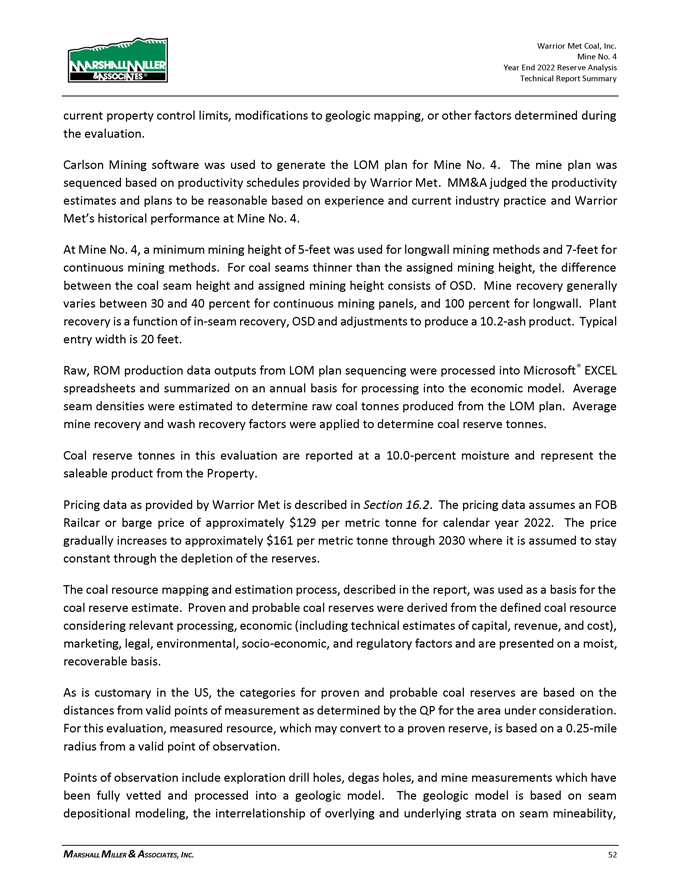
current property control limits, modifications to geologic mapping, or other factors determined during the evaluation. Carlson Mining software was used to generate the LOM plan for Mine No. 4. The mine plan was sequenced based on productivity schedules provided by Warrior Met. MM&A judged the productivity estimates and plans to be reasonable based on experience and current industry practice and Warrior Met’s historical performance at Mine No. 4. At Mine No. 4, a minimum mining height of 5-feet was used for long wall mining methods and 7-feet for continuous mining methods. For coal seams thinner than the assigned mining height, the difference between the coal seam height and assigned mining height consists of OSD. Mine recovery generally varies between 30 and 40 percent for continuous mining panels, and 100 percent for long wall. Plant recovery is a function of in-seam recovery, OSD and adjustments to produce a 10.2-ash product. Typical entry width is 20 feet. Raw, ROM production data outputs from LOM plan sequencing were processed into Microsoft® EXCEL spreadsheets and summarized on an annual basis for processing into the economic model. Average seam densities were estimated to determine raw coal tones produced from the LOM plan. Average mine recovery and wash recovery factors were applied to determine coal reserve tones. Coal reserve tones in this evaluation are reported at a 10.0-percent moisture and represent the saleable product from the Property. Pricing data as provided by Warrior Met is described in Section 16.2. The pricing data assumes an FOB Railcar or barge price of approximately $129 per metric ton for calendar year 2022. The price gradually increases to approximately $161 per metric ton through 2030 where it is assumed to stay constant through the depletion of the reserves. The coal resource mapping and estimation process, described in the report, was used as a basis for the coal reserve estimate. Proven and probable coal reserves were derived from the defined coal resource considering relevant processing, economic (including technical estimates of capital, revenue, and cost), marketing, legal, environmental, socio-economic, and regulatory factors and are presented on a moist, recoverable basis. As is customary in the US, the categories for proven and probable coal reserves are based on the distances from valid points of measurement as determined by the QP for the area under consideration. For this evaluation, measured resource, which may convert to a proven reserve, is based on a 0.25-mile radius from a valid point of observation. Points of observation include exploration drill holes, degas holes, and mine measurements which have been fully vetted and processed into a geologic model. The geologic model is based on seam depositional modeling, the interrelationship of overlying and underlying strata on seam mine ability, MARSHALL MILLER & ASSOCIATES, INC. 52

seam thickness trends, the impact of seam structure (i.e., faulting), intra-seam characteristics, etc. Once the geologic model was completed, a statistical analysis, described in Section 11.1.1 was conducted and a 0.25-mile radius from a valid point of observation was selected to define Measured Resources. Likewise, the distance between 0.25 and 0.75 of a mile radius was selected to define Indicated Resources. Indicated Resources may convert to Probable Reserves. There are no Inferred Resources (greater than a 0.75-mile radius from a valid point of observation) at Mine No. 4. 12.2 Qualified Person’s Estimates Reserve tonnage estimates provided herein report coal reserves derived from the in-situ resource tones presented in Table 11-3, and not in addition to coal resources. Proven and probable coal reserves were derived from the defined coal resource considering relevant mining, processing, infrastructure, economic (including estimates of capital, revenue, and cost), marketing, legal, environmental, socio-economic and regulatory factors. Such factors include a mine recovery of 72 percent derived from an engineered mine plan, the consideration of out-of-seam and in-seam dilution material, an effective a wash recovery of 49 percent and the consideration of moisture factors. The coal reserves, as shown in Table 12-1, are based on a technical evaluation of the geology and a preliminary feasibility study of the coal deposits. The extent to which the coal reserves may be affected by any known environmental, permitting, legal, title, socio-economic, marketing, political, or other relevant issues has been reviewed rigorously. Similarly, the extent to which the estimates of coal reserves may be materially affected by mining, metallurgical, infrastructure and other relevant factors has also been considered. Table 12-1: Coal Reserve Summary (Marketable Sales Basis) as of December 31, 2022 Demonstrated Coal Reserves (Wet Tonnes, Washed or Direct Shipped, Mt) By Reliability Category By Control Type Quality (Dry Basis) Wash Seam Proven Probable Total Owned Leased Ash% Sulfur% VM% Recovery Mary Lee 11.3 0.2 11.5 0.0 11.5 —— Blue Creek 27.4 0.4 27.8 0.0 27.8 ——49% Total 38.7 0.5 39.2 0.0 39.2 10.2 0.8 30 Note 1: Marketable reserve tones are reported on a moist basis, including a combination of surface and inherent moisture. The combination of surface and inherent moisture is modeled at 10-percent, comparable to Warrior Met’s current product moisture. Actual product moisture is dependent upon multiple geological factors, operational factors, and product contract specifications. Note 2: Wash recovery is based on LOM planning and reflects projected plant recovery after the consideration of out-of-seam dilution. Wash recovery is not stated on a seam-by-seam basis, as the Mary Lee and Blue Creek seams are mined together – allocation of dilution material on a seam-by-seam basis would introduce confusion with regards to wash recovery. Detailed reserve tables (see Appendix) show projected in-seam wash recovery on a seam-by -seam basis, absent dilution assumptions. Note 3: Coal Reserves are based upon sales assumptions provided to MM&A by Warrior and were relied upon by MM&A. Financial modeling assumes sales prices of approximately $129.46/ ton (FOB-mine) in 2023, increasing to a long-term price of approximately $161.24/ton. See Chapter 16 for further details on marketing assumptions. Totals may not add due to rounding. MARSHALL MILLER & ASSOCIATES, INC. 53

As shown below, coal shipments during 2022 (primarily from the eastern portion of the Property) exhibited a weight-averaged quality very similar to quality projected from core samples (refer to Table 12-1 above). > Moisture content: 9.7% > Ash content: 10.2% (db.) > Sulfur content: 0.8% (db.) > VM content: 27% (db.) The results of this TRS define an estimated 39.2 Mt of proven and probable marketable coal reserves. Of that total, 99 percent are proven, and 1 percent are probable. All of the Mine No. 4 reserves are leased and are considered suitable for the metallurgical coal market, and all of the reserves are assigned. 12.3 Qualified Person’s Opinion The estimate of coal reserves was determined in accordance with SEC standards. The LOM mining plan for Mine No. 4 was prepared to the level of preliminary feasibility. Mine projections were prepared with a timing schedule to match production with coal seam characteristics. Production timing was carried out from current locations to depletion of the coal reserve area. Coal reserve estimates could be materially affected by the risk factors described in Section 22.2. Based on the preliminary feasibility study and the attendant economic review, MM&A believes this is a fair and accurate estimation of Mine No. 4 coal reserves. 13 Mining Methods 13.1 Geotechnical and Hydrologic Issues The mining plan for Mine No. 4 was developed by Warrior Met and modified by MM&A to fit property constraints. Mine geometry, including pillar sizing and panel sizing is typical of ranges currently utilized by Warrior Met in its active operations. Mine recoveries in engineering mining projections are typical of those currently achieved by Warrior Met. MM&A does not anticipate insurmountable challenges with regards to geotechnical issue at the operations based upon 1) Warrior’s (and predecessor’s) historic success in high resource recovery; 2) Consistent geological criteria in future mining areas and 3) ongoing exploration programs to mitigate risks related to geological and geotechnical (fault) issues. Pillar stability was tested by MM&A using the Analysis of Coal Pillar Stability (ACPS) program that was developed by the National Institute for Occupational Safety and Health (NIOSH). MM&A reviewed the results from the ACPS analysis and considered them in the development of the LOM plan. MARSHALL MILLER & ASSOCIATES, INC. 54
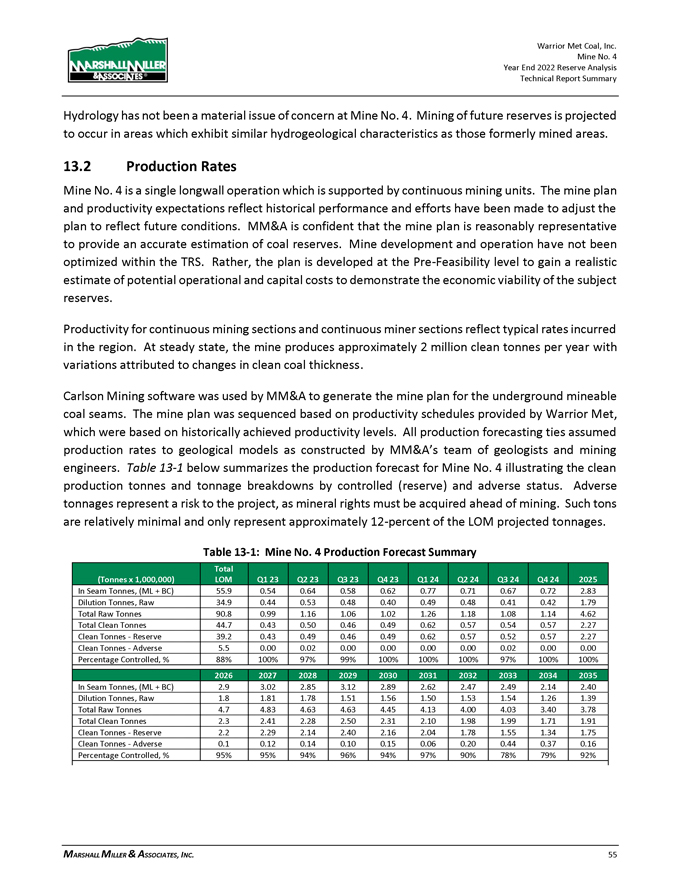
Hydrology has not been a material issue of concern at Mine No. 4. Mining of future reserves is projected to occur in areas which exhibit similar hydrogeological characteristics as those formerly mined areas. 13.2 Production Rates Mine No. 4 is a single long wall operation which is supported by continuous mining units. The mine plan and productivity expectations reflect historical performance and efforts have been made to adjust the plan to reflect future conditions. MM&A is confident that the mine plan is reasonably representative to provide an accurate estimation of coal reserves. Mine development and operation have not been optimized within the TRS. Rather, the plan is developed at the Pre-Feasibility level to gain a realistic estimate of potential operational and capital costs to demonstrate the economic viability of the subject reserves. Productivity for continuous mining sections and continuous miner sections reflect typical rates incurred in the region. At steady state, the mine produces approximately 2 million clean tones per year with variations attributed to changes in clean coal thickness. Carlson Mining software was used by MM&A to generate the mine plan for the underground mineable coal seams. The mine plan was sequenced based on productivity schedules provided by Warrior Met, which were based on historically achieved productivity levels. All production forecasting ties assumed production rates to geological models as constructed by MM&A’s team of geologists and mining engineers. Table 13-1 below summarizes the production forecast for Mine No. 4 illustrating the clean production tones and tonnage breakdowns by controlled (reserve) and adverse status. Adverse tonnages represent a risk to the project, as mineral rights must be acquired ahead of mining. Such tons are relatively minimal and only represent approximately 12-percent of the LOM projected tonnages. Table 13-1: Mine No. 4 Production Forecast Summary Total (Tonnes x 1,000,000) LOM Q1 23 Q2 23 Q3 23 Q4 23 Q1 24 Q2 24 Q3 24 Q4 24 2025 In Seam Tonnes, (ML + BC) 55.9 0.54 0.64 0.58 0.62 0.77 0.71 0.67 0.72 2.83 Dilution Tonnes, Raw 34.9 0.44 0.53 0.48 0.40 0.49 0.48 0.41 0.42 1.79 Total Raw Tonnes 90.8 0.99 1.16 1.06 1.02 1.26 1.18 1.08 1.14 4.62 Total Clean Tonnes 44.7 0.43 0.50 0.46 0.49 0.62 0.57 0.54 0.57 2.27 Clean Tonnes—Reserve 39.2 0.43 0.49 0.46 0.49 0.62 0.57 0.52 0.57 2.27 Clean Tonnes—Adverse 5.5 0.00 0.02 0.00 0.00 0.00 0.00 0.02 0.00 0.00 Percentage Controlled, % 88% 100% 97% 99% 100% 100% 100% 97% 100% 100% 2026 2027 2028 2029 2030 2031 2032 2033 2034 2035 In Seam Tonnes, (ML + BC) 2.9 3.02 2.85 3.12 2.89 2.62 2.47 2.49 2.14 2.40 Dilution Tonnes, Raw 1.8 1.81 1.78 1.51 1.56 1.50 1.53 1.54 1.26 1.39 Total Raw Tonnes 4.7 4.83 4.63 4.63 4.45 4.13 4.00 4.03 3.40 3.78 Total Clean Tonnes 2.3 2.41 2.28 2.50 2.31 2.10 1.98 1.99 1.71 1.91 Clean Tonnes—Reserve 2.2 2.29 2.14 2.40 2.16 2.04 1.78 1.55 1.34 1.75 Clean Tonnes—Adverse 0.1 0.12 0.14 0.10 0.15 0.06 0.20 0.44 0.37 0.16 Percentage Controlled, % 95% 95% 94% 96% 94% 97% 90% 78% 79% 92% MARSHALL MILLER & ASSOCIATES, INC. 55

2036 2037 2038 2039 2040 2041 2042 2043 2044 2045 In Seam Tonnes, (ML + BC) 2.1 2.27 2.09 2.15 2.41 2.23 2.35 2.05 1.88 1.32 Dilution Tonnes, Raw 1.3 1.43 1.31 1.65 1.52 1.54 1.49 1.42 1.30 0.82 Total Raw Tonnes 3.4 3.70 3.40 3.81 3.93 3.78 3.84 3.47 3.18 2.14 Total Clean Tonnes 1.7 1.82 1.68 1.72 1.93 1.79 1.88 1.64 1.50 1.05 Clean Tonnes—Reserve 1.2 1.23 1.28 1.04 1.90 1.10 1.69 1.42 1.50 0.81 Clean Tonnes—Adverse 0.5 0.59 0.40 0.68 0.03 0.69 0.19 0.22 0.00 0.24 Percentage Controlled, % 68% 68% 76% 60% 99% 61% 90% 87% 100% 77% 13.3 Mining-Related Requirements Although the continuous miner sections are significantly more expensive to operate on a cost-per-ton basis, they are necessary to open up areas of the mine by developing main entries and gate roads in preparation for the long wall. At steady state, the LOM plan included in this TRS requires two to three continuous mining support sections until the last few years of mining. 13.4 Required Equipment and Personnel Mine No. 4, along with Mine No. 7, are currently Warrior Met’s only long wall operations. The long wall shearing machine is used for extraction of coal at the production face. A chain conveyor is used to remove coal from the long wall face for discharge onto the conveyor belt which then ultimately delivers it to the skip systems. Development for the long wall is conducted by the extraction of coal from the production faces using continuous miners and haulage using shuttle cars to a feeder-breaker located at the tail of the section conveyor belt. The feeder-breaker crushes large pieces of coal and rock and regulates coal feed onto the mine conveyor. Roof-bolting machines are used to support the roof on the development sections of the long wall mine. Roof-bolting machines are used to install roof bolts, and battery scoops are available to clean the mine entries and assist in delivery of mine supplies to work areas. Other supplemental equipment such as personnel carriers, supply vehicles, etc., are also used daily. Mine conveyors typically range in width up to 6 feet. Multiple belt flights are arranged in series to deliver raw coal to the underground storage. Along the main and sub-main entries and panels, a travel way is provided for personnel and materials by rubber-tired equipment or on rail. A skip system is used to transport ROM coal from the underground storage bunker to the surface where the coal may be sampled, crushed and washed in the preparation plant and stockpiled to await shipment. Surface ventilation fans are installed as needed to provide a sufficient volume of air to ventilate production sections, coal haulage and transport entries, battery charging stations, and transformers in accordance with approved plans. High-voltage cables deliver power throughout the mine where transformers reduce voltage for specific equipment requirements. The Mine Improvement and New Emergency Response Act of 2006 (MINER Act) requires that carbon monoxide detection systems be installed along mine conveyor belts and that electronic two-way tracking and communications systems be installed throughout the underground mine. Water is required to control dust at production sections and along conveyor belts, and to cool electric motors. Water is available from nearby sources and is MARSHALL MILLER & ASSOCIATES, INC. 56

distributed within the mine by pipelines as required. At a steady state, the mine is projected to employ approximately 400 employees. 14 Processing and Recovery Methods 14.1 Description or Flowsheet Warrior Met currently operates a coal preparation plant at the Property. The Mine No. 4 Plant operates at a feed rate of approximately 1,180 raw tones per hour (mph). Coarse material is washed in a heavy media vessel; the intermediate-size material is washed in heavy media cyclones. Fine material is washed using reflux classifiers, and ultrafine material is cleaned by froth flotation. These processes are supported by the requisite screens, centrifuges, vacuum filters, sumps, pumps, and distribution systems. Processes and equipment are typical of those used in the coal industry and are in use in nearly all plants in the Black Warrior Basin. Warrior’s No. 4 Plant includes an ultrafine coal cleaning technology, namely that developed by Somerset, for additional recovery of coal fines. Table 14-1 below shows 5 years of historical, and the projected wash yields for the Mine No. 4 plant. Table 14-1: 5 Years of Historical and Projected Wash Yields for Mine No. 4 Year Basis Projected Yield % 2018 Historical 41% 2019 Historical 40% 2020 Historical 38% 2021 Historical 44% 2022 Historical 40% 2023 Projected 45% 2024 Projected 49% 2025 Projected 49% 2026 Projected 50% 2027 Projected 50% LOM Projected 49% Note—Increase in Projected Wash Recovery Attributed to Thickness Increases Suggested by Exploration Information in North Reserve Area. 14.2 Requirements for Energy, Water, Material and Personnel Personnel have historically been sourced from the surrounding communities in Tuscaloosa, Jefferson and Bibb Counties, and have proven to be adequate in numbers to operate the mine. As mining is common in the surrounding areas, the workforce is generally familiar with mining practices, and many are experienced miners. The Mine No. 4 Complex has sources of water, power, personnel, and supplies readily available for use. Water is sourced locally by a combination of municipal and freshwater sources. Electricity is sourced MARSHALL MILLER & ASSOCIATES, INC. 57

from Alabama Power. The service industry in the areas surrounding the mine complex has historically provided supplies, equipment repairs and fabrication, etc. 15 Infrastructure The Warrior Met-owned Mine No. 4 Preparation Plant services the mine via skip system which transports extracted coal from an underground bunker to the surface facility. A nearby rail line and the Black Warrior River serve as the primary means of transport from the mine. As an active operation, the necessary support infrastructure for Mine No. 4 is in place. In addition to the plant and loadout, there are also portal facilities, including personnel access to the mine and ventilation fans. A photo of the existing facilities is Figure 15-1. Additionally, Warrior Met is nearing the completion of a new portal for access to its northern reserve areas west of the Black Warrior River. This portal is currently being used to support continuous miner development. The new portal includes a 40-ton hoist for supplies and equipment. Water and emulsion systems at the portal are currently being constructed and will be completed ahead of longwall mining in west of the Black Warrior River. Figure 15-1: Mine No. 4 Surface Facilities MARSHALL MILLER & ASSOCIATES, INC. 58
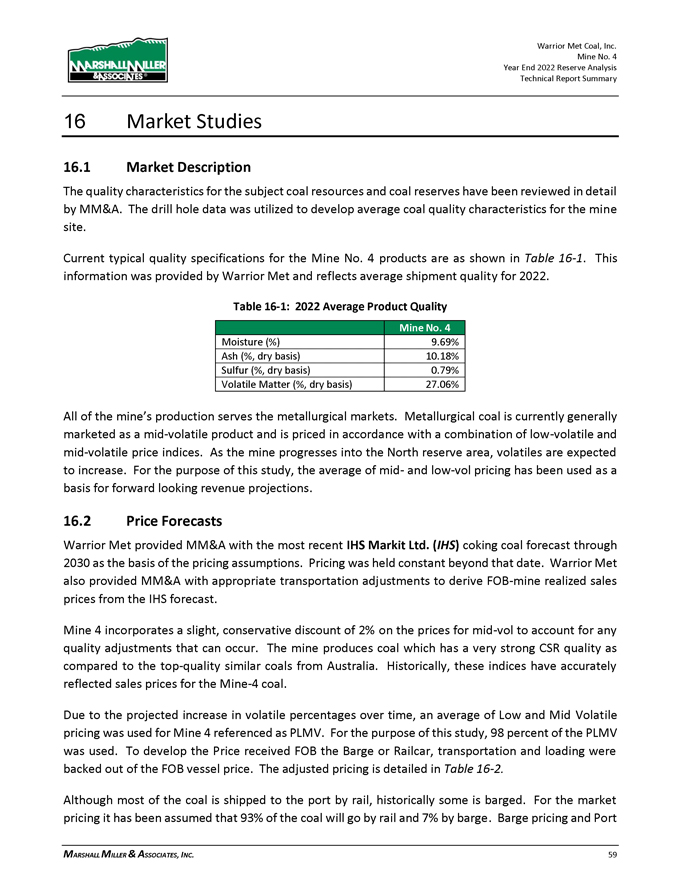
16 Market Studies 16.1 Market Description The quality characteristics for the subject coal resources and coal reserves have been reviewed in detail by MM&A. The drill hole data was utilized to develop average coal quality characteristics for the mine site. Current typical quality specifications for the Mine No. 4 products are as shown in Table 16-1. This information was provided by Warrior Met and reflects average shipment quality for 2022. Table 16-1: 2022 Average Product Quality Mine No. 4 Moisture (%) 9.69% Ash (%, dry basis) 10.18% Sulfur (%, dry basis) 0.79% Volatile Matter (%, dry basis) 27.06% All of the mine’s production serves the metallurgical markets. Metallurgical coal is currently generally marketed as a mid-volatile product and is priced in accordance with a combination of low-volatile and mid-volatile price indices. As the mine progresses into the North reserve area, volatiles are expected to increase. For the purpose of this study, the average of mid- and low-vol pricing has been used as a basis for forward looking revenue projections. 16.2 Price Forecasts Warrior Met provided MM&A with the most recent IHS Markit Ltd. (IHS) coking coal forecast through 2030 as the basis of the pricing assumptions. Pricing was held constant beyond that date. Warrior Met also provided MM&A with appropriate transportation adjustments to derive FOB-mine realized sales prices from the IHS forecast. Mine 4 incorporates a slight, conservative discount of 2% on the prices for mid-vol to account for any quality adjustments that can occur. The mine produces coal which has a very strong CSR quality as compared to the top-quality similar coals from Australia. Historically, these indices have accurately reflected sales prices for the Mine-4 coal. Due to the projected increase in volatile percentages over time, an average of Low and Mid Volatile pricing was used for Mine 4 referenced as PLMV. For the purpose of this study, 98 percent of the PLMV was used. To develop the Price received FOB the Barge or Railcar, transportation and loading were backed out of the FOB vessel price. The adjusted pricing is detailed in Table 16-2. Although most of the coal is shipped to the port by rail, historically some is barged. For the market pricing it has been assumed that 93% of the coal will go by rail and 7% by barge. Barge pricing and Port MARSHALL MILLER & ASSOCIATES, INC. 59

handling and loading costs remain constant, but Rail costs increase as Sales pricing increases plus an added premium once pricing is above $175/tonne FOB the Vessel. Table 16-2: Adjusted Pricing (per tonne) LOM 2023 2024 2025 2026 2027 Price FOB Vessel $179.30 $152.00 $153.00 $153.00 $158.00 $174.00 Transportation & Loading $25.08 $22.54 $22.64 $22.64 $23.17 $24.87 Revenue FOB Railcar or Barge $154.21 $129.46 $130.36 $130.36 $134.83 $149.13 2028 2029 2030 2031 2032 2033 Barge & Loading $180.00 $184.00 $187.00 $187.00 $187.00 $187.00 Transportation & Loading $25.30 $25.56 $25.76 $25.76 $25.76 $25.76 Revenue FOB Railcar or Barge $154.70 $158.44 $161.24 $161.24 $161.24 $161.24 2034 2035 2036 2037 2038 2039 FOB Barge $187.00 $187.00 $187.00 $187.00 $187.00 $187.00 Transportation & Loading $25.76 $25.76 $25.76 $25.76 $25.76 $25.76 Revenue FOB Railcar or Barge $161.24 $161.24 $161.24 $161.24 $161.24 $161.24 2040 2041 2042 2043 2044 2045 Pricing $187.00 $187.00 $187.00 $187.00 $187.00 $187.00 Transportation & Loading $25.76 $25.76 $25.76 $25.76 $25.76 $25.76 Revenue FOB Railcar or Barge $161.24 $161.24 $161.24 $161.24 $161.24 $161.24 Note: Actual realized sales revenues in January 2023 for Mine No. 4 indicate more favorable prices than those reflected in the table above as incorporated in financial modeling. While not fully indicative of 2023, it is noted that current market conditions suggest some potential conservatism in prices estimated for this calendar year, pending continued favorable market conditions. IHS is a well-recognized source of such data. IHS is a global diversified provider of critical information, analytics, and solutions. It offers next-generation information, analytics, and solutions to customers in business, finance, and government, improving their operational efficiency and providing deep insights. IHS serves business and government customers worldwide. 16.3 Contract Requirements Some contracts are necessary for successful marketing of the coal. For Mine No. 4, since all mining, preparation and marketing is done in-house, the remaining contracts required are: > Transportation – The mine’s contracts with the railroad and transportation companies for barges on the Black Warrior River to transport the coal to either the domestic customers or to the Mobile export terminal for overseas shipment. > Handling – Contracts for loading vessels for export sales are necessary. These are typically handled by annual negotiations based on projected shipments. > Sales – Sales contracts are a mix of spot and contract sales. MARSHALL MILLER & ASSOCIATES, INC. 60

17 Environmental Studies, Permitting and Plans, Negotiations or Agreements with Local Individuals 17.1 Results of Studies MM&A has not conducted environmental based services or studies for Warrior Met. Permitting activities are managed internally by Warrior Met. 17.2 Requirements and Plans for Waste Disposal Based on data provided by Warrior Met, the current Mine No.4 coarse refuse disposal sites have a remaining capacity of 15-million cubic yards as currently designed, which would provide approximately 17 years of capacity at 2022 production rates. Warrior Met has submitted an expansion to the existing coarse refuse disposal site which is currently under review with regulatory agencies. This new expansion is anticipated to provide an additional 5.5-million cubic yards of volume, which equates to an estimated 6 years at 2022 production rates. Additionally, Warrior Met reports that current active and permitted fines disposal sites have a cumulative remaining capacity of 1,300 acre-foot, equivalent to 5 years at 2022 production rates. A new 1,300-acre-foot fine refuse disposal facility has been designed and is currently under review within multiple regulatory agencies. This new facility is anticipated to be approved in 2023 and should provide 3.5 years of additional fine refuse storage capacity. Warrior Met has also identified additional future fine refuse areas with a total of 3,200 acre-foot, which could potentially add an additional 10 years of capacity. 17.3 Permit Requirements and Status All mining operations are subject to federal and state laws and must obtain permits to operate mines, coal preparation and related facilities, haul roads, and other incidental surface disturbances necessary for mining to occur. Permits generally require that the permittee post a performance bond in an amount established by the regulatory program to provide assurance that any disturbance or liability created during mining operations is properly restored to an approved post-mining land use and that all regulations and requirements of the permits are fully satisfied before the bond is returned to the permittee. Significant penalties exist for any permittee who fails to meet the obligations of the permits including cessation of mining operations, which can lead to potential forfeiture of the bond. Any company, and its directors, owners and officers, which are subject to bond forfeiture can be denied future permits under the program.1 New permits or permit revisions will occasionally be necessary to facilitate the expansion or addition of new mining areas on the property, such as amendments to existing permits and new permits for 1 Monitored under the Applicant Violator System (AVS) by the Federal Office of Surface Mining. MARSHALL MILLER & ASSOCIATES, INC. 61
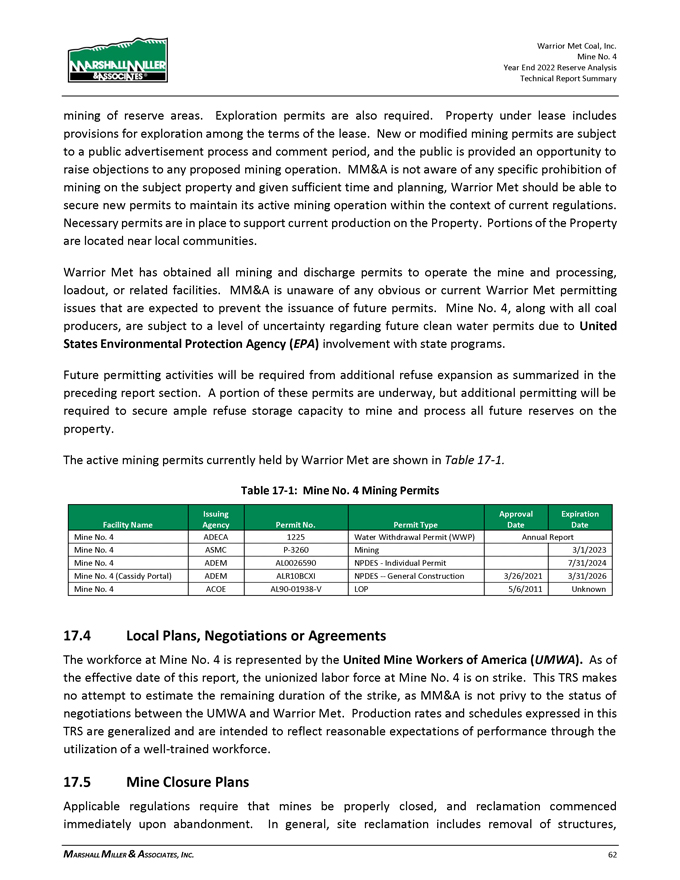
mining of reserve areas. Exploration permits are also required. Property under lease includes provisions for exploration among the terms of the lease. New or modified mining permits are subject to a public advertisement process and comment period, and the public is provided an opportunity to raise objections to any proposed mining operation. MM&A is not aware of any specific prohibition of mining on the subject property and given sufficient time and planning, Warrior Met should be able to secure new permits to maintain its active mining operation within the context of current regulations. Necessary permits are in place to support current production on the Property. Portions of the Property are located near local communities. Warrior Met has obtained all mining and discharge permits to operate the mine and processing, loadout, or related facilities. MM&A is unaware of any obvious or current Warrior Met permitting issues that are expected to prevent the issuance of future permits. Mine No. 4, along with all coal producers, are subject to a level of uncertainty regarding future clean water permits due to United States Environmental Protection Agency (EPA) involvement with state programs. Future permitting activities will be required from additional refuse expansion as summarized in the preceding report section. A portion of these permits are underway, but additional permitting will be required to secure ample refuse storage capacity to mine and process all future reserves on the property. The active mining permits currently held by Warrior Met are shown in Table 17-1. Table 17-1: Mine No. 4 Mining Permits Issuing Approval Expiration Facility Name Agency Permit No. Permit Type Date Date Mine No. 4 ADECA 1225 Water Withdrawal Permit (WWP) Annual Report Mine No. 4 ASMC P-3260 Mining 3/1/2023 Mine No. 4 ADEM AL0026590 NPDES—Individual Permit 7/31/2024 Mine No. 4 (Cassidy Portal) ADEM ALR10BCXI NPDES — General Construction 3/26/2021 3/31/2026 Mine No. 4 ACOE AL90-01938-V LOP 5/6/2011 Unknown 17.4 Local Plans, Negotiations or Agreements The workforce at Mine No. 4 is represented by the United Mine Workers of America (UMWA). As of the effective date of this report, the unionized labor force at Mine No. 4 is on strike. This TRS makes no attempt to estimate the remaining duration of the strike, as MM&A is not privy to the status of negotiations between the UMWA and Warrior Met. Production rates and schedules expressed in this TRS are generalized and are intended to reflect reasonable expectations of performance through the utilization of a well-trained workforce. 17.5 Mine Closure Plans Applicable regulations require that mines be properly closed, and reclamation commenced immediately upon abandonment. In general, site reclamation includes removal of structures, MARSHALL MILLER & ASSOCIATES, INC. 62
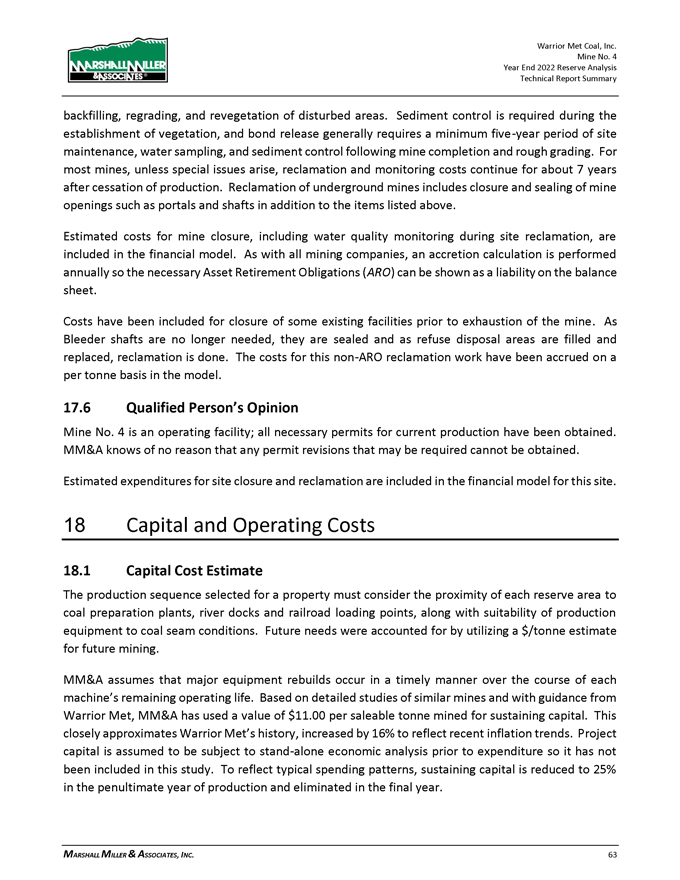
backfilling, regrading, and revegetation of disturbed areas. Sediment control is required during the establishment of vegetation, and bond release generally requires a minimum five-year period of site maintenance, water sampling, and sediment control following mine completion and rough grading. For most mines, unless special issues arise, reclamation and monitoring costs continue for about 7 years after cessation of production. Reclamation of underground mines includes closure and sealing of mine openings such as portals and shafts in addition to the items listed above. Estimated costs for mine closure, including water quality monitoring during site reclamation, are included in the financial model. As with all mining companies, an accretion calculation is performed annually so the necessary Asset Retirement Obligations (ARO) can be shown as a liability on the balance sheet. Costs have been included for closure of some existing facilities prior to exhaustion of the mine. As Bleeder shafts are no longer needed, they are sealed and as refuse disposal areas are filled and replaced, reclamation is done. The costs for this non-ARO reclamation work have been accrued on a per tonne basis in the model. 17.6 Qualified Person’s Opinion Mine No. 4 is an operating facility; all necessary permits for current production have been obtained. MM&A knows of no reason that any permit revisions that may be required cannot be obtained. Estimated expenditures for site closure and reclamation are included in the financial model for this site. 18 Capital and Operating Costs 18.1 Capital Cost Estimate The production sequence selected for a property must consider the proximity of each reserve area to coal preparation plants, river docks and railroad loading points, along with suitability of production equipment to coal seam conditions. Future needs were accounted for by utilizing a $/tonne estimate for future mining. MM&A assumes that major equipment rebuilds occur in a timely manner over the course of each machine’s remaining operating life. Based on detailed studies of similar mines and with guidance from Warrior Met, MM&A has used a value of $11.00 per saleable tonne mined for sustaining capital. This closely approximates Warrior Met’s history, increased by 16% to reflect recent inflation trends. Project capital is assumed to be subject to stand-alone economic analysis prior to expenditure so it has not been included in this study. To reflect typical spending patterns, sustaining capital is reduced to 25% in the penultimate year of production and eliminated in the final year. MARSHALL MILLER & ASSOCIATES, INC. 63
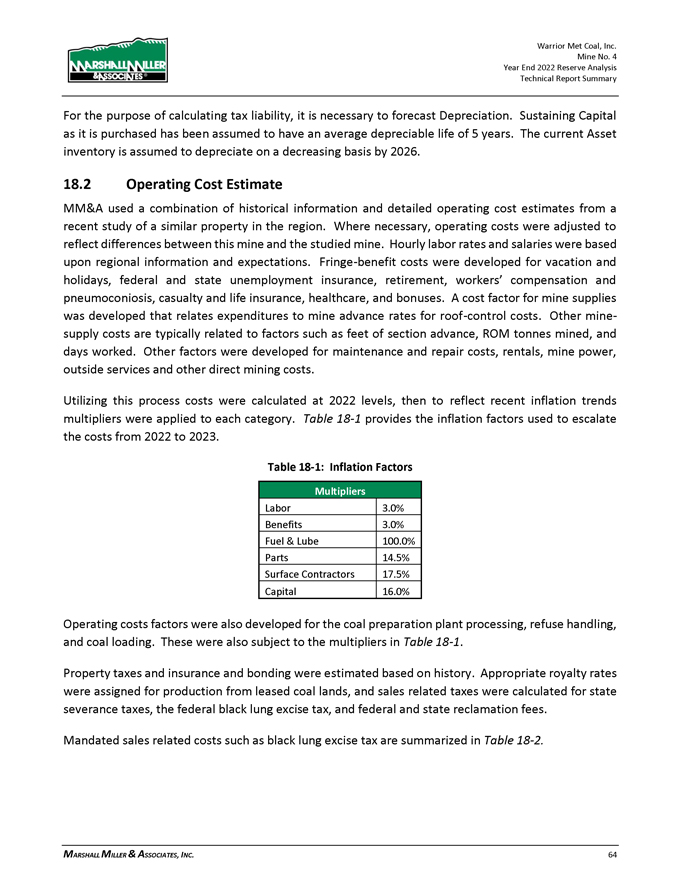
For the purpose of calculating tax liability, it is necessary to forecast Depreciation. Sustaining Capital as it is purchased has been assumed to have an average depreciable life of 5 years. The current Asset inventory is assumed to depreciate on a decreasing basis by 2026. 18.2 Operating Cost Estimate MM&A used a combination of historical information and detailed operating cost estimates from a recent study of a similar property in the region. Where necessary, operating costs were adjusted to reflect differences between this mine and the studied mine. Hourly labor rates and salaries were based upon regional information and expectations. Fringe-benefit costs were developed for vacation and holidays, federal and state unemployment insurance, retirement, workers’ compensation and pneumoconiosis, casualty and life insurance, healthcare, and bonuses. A cost factor for mine supplies was developed that relates expenditures to mine advance rates for roof-control costs. Other mine-supply costs are typically related to factors such as feet of section advance, ROM tonnes mined, and days worked. Other factors were developed for maintenance and repair costs, rentals, mine power, outside services and other direct mining costs. Utilizing this process costs were calculated at 2022 levels, then to reflect recent inflation trends multipliers were applied to each category. Table 18-1 provides the inflation factors used to escalate the costs from 2022 to 2023. Table 18-1: Inflation Factors Multipliers Labor 3.0% Benefits 3.0% Fuel & Lube 100.0% Parts 14.5% Surface Contractors 17.5% Capital 16.0% Operating costs factors were also developed for the coal preparation plant processing, refuse handling, and coal loading. These were also subject to the multipliers in Table 18-1. Property taxes and insurance and bonding were estimated based on history. Appropriate royalty rates were assigned for production from leased coal lands, and sales related taxes were calculated for state severance taxes, the federal black lung excise tax, and federal and state reclamation fees. Mandated sales related costs such as black lung excise tax are summarized in Table 18-2. MARSHALL MILLER & ASSOCIATES, INC. 64
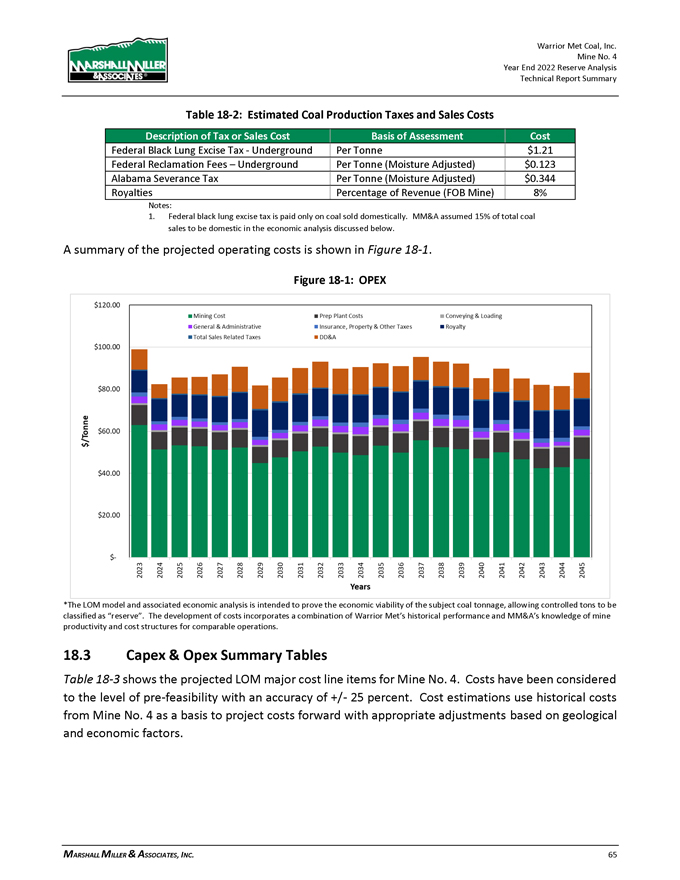
Table 18-2: Estimated Coal Production Taxes and Sales Costs Description of Tax or Sales Cost Basis of Assessment Cost Federal Black Lung Excise Tax—Underground Per Tonne $1.21 Federal Reclamation Fees – Underground Per Tonne (Moisture Adjusted) $0.123 Alabama Severance Tax Per Tonne (Moisture Adjusted) $0.344 Royalties Percentage of Revenue (FOB Mine) 8% Notes: 1. Federal black lung excise tax is paid only on coal sold domestically. MM&A assumed 15% of total coal sales to be domestic in the economic analysis discussed below. A summary of the projected operating costs is shown in Figure 18-1. Figure 18-1: OPEX *The LOM model and associated economic analysis is intended to prove the economic viability of the subject coal tonnage, allowing controlled tons to be classified as “reserve”. The development of costs incorporates a combination of Warrior Met’s historical performance and MM&A’s knowledge of mine productivity and cost structures for comparable operations. 18.3 Capex & Opex Summary Tables Table 18-3 shows the projected LOM major cost line items for Mine No. 4. Costs have been considered to the level of pre-feasibility with an accuracy of +/- 25 percent. Cost estimations use historical costs from Mine No. 4 as a basis to project costs forward with appropriate adjustments based on geological and economic factors. MARSHALL MILLER & ASSOCIATES, INC. 65
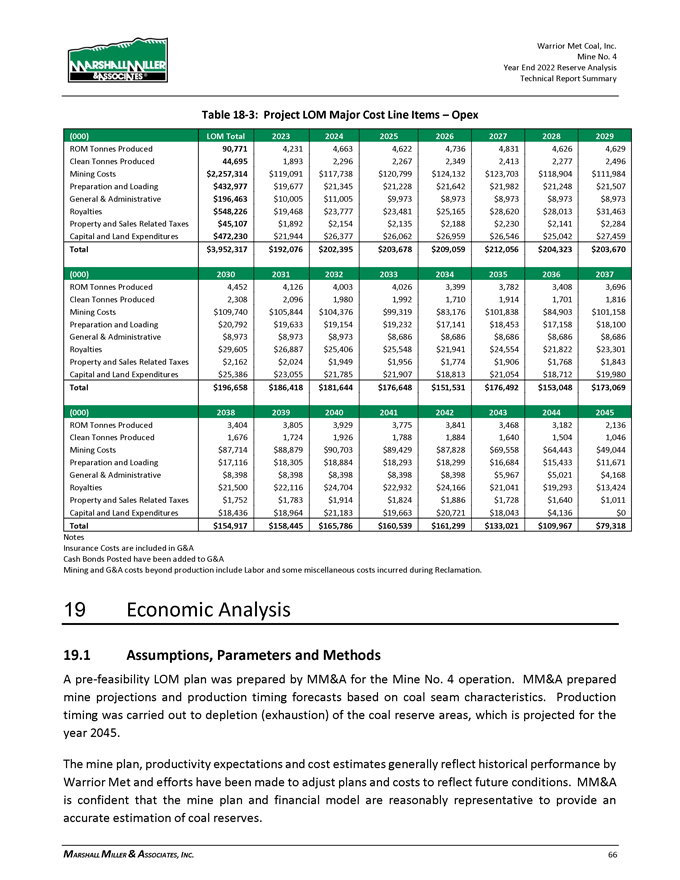
Table 18-3: Project LOM Major Cost Line Items – Opex (000) LOM Total 2023 2024 2025 2026 2027 2028 2029 ROM Tonnes Produced 90,771 4,231 4,663 4,622 4,736 4,831 4,626 4,629 Clean Tonnes Produced 44,695 1,893 2,296 2,267 2,349 2,413 2,277 2,496 Mining Costs $2,257,314 $119,091 $117,738 $120,799 $124,132 $123,703 $118,904 $111,984 Preparation and Loading $432,977 $19,677 $21,345 $21,228 $21,642 $21,982 $21,248 $21,507 General & Administrative $196,463 $10,005 $11,005 $9,973 $8,973 $8,973 $8,973 $8,973 Royalties $548,226 $19,468 $23,777 $23,481 $25,165 $28,620 $28,013 $31,463 Property and Sales Related Taxes $45,107 $1,892 $2,154 $2,135 $2,188 $2,230 $2,141 $2,284 Capital and Land Expenditures $472,230 $21,944 $26,377 $26,062 $26,959 $26,546 $25,042 $27,459 Total $3,952,317 $192,076 $202,395 $203,678 $209,059 $212,056 $204,323 $203,670 (000) 2030 2031 2032 2033 2034 2035 2036 2037 ROM Tonnes Produced 4,452 4,126 4,003 4,026 3,399 3,782 3,408 3,696 Clean Tonnes Produced 2,308 2,096 1,980 1,992 1,710 1,914 1,701 1,816 Mining Costs $109,740 $105,844 $104,376 $99,319 $83,176 $101,838 $84,903 $101,158 Preparation and Loading $20,792 $19,633 $19,154 $19,232 $17,141 $18,453 $17,158 $18,100 General & Administrative $8,973 $8,973 $8,973 $8,686 $8,686 $8,686 $8,686 $8,686 Royalties $29,605 $26,887 $25,406 $25,548 $21,941 $24,554 $21,822 $23,301 Property and Sales Related Taxes $2,162 $2,024 $1,949 $1,956 $1,774 $1,906 $1,768 $1,843 Capital and Land Expenditures $25,386 $23,055 $21,785 $21,907 $18,813 $21,054 $18,712 $19,980 Total $196,658 $186,418 $181,644 $176,648 $151,531 $176,492 $153,048 $173,069 (000) 2038 2039 2040 2041 2042 2043 2044 2045 ROM Tonnes Produced 3,404 3,805 3,929 3,775 3,841 3,468 3,182 2,136 Clean Tonnes Produced 1,676 1,724 1,926 1,788 1,884 1,640 1,504 1,046 Mining Costs $87,714 $88,879 $90,703 $89,429 $87,828 $69,558 $64,443 $49,044 Preparation and Loading $17,116 $18,305 $18,884 $18,293 $18,299 $16,684 $15,433 $11,671 General & Administrative $8,398 $8,398 $8,398 $8,398 $8,398 $5,967 $5,021 $4,168 Royalties $21,500 $22,116 $24,704 $22,932 $24,166 $21,041 $19,293 $13,424 Property and Sales Related Taxes $1,752 $1,783 $1,914 $1,824 $1,886 $1,728 $1,640 $1,011 Capital and Land Expenditures $18,436 $18,964 $21,183 $19,663 $20,721 $18,043 $4,136 $0 Total $154,917 $158,445 $165,786 $160,539 $161,299 $133,021 $109,967 $79,318 Notes Insurance Costs are included in G&A Cash Bonds Posted have been added to G&A Mining and G&A costs beyond production include Labor and some miscellaneous costs incurred during Reclamation. 19 Economic Analysis 19.1 Assumptions, Parameters and Methods A pre-feasibility LOM plan was prepared by MM&A for the Mine No. 4 operation. MM&A prepared mine projections and production timing forecasts based on coal seam characteristics. Production timing was carried out to depletion (exhaustion) of the coal reserve areas, which is projected for the year 2045. The mine plan, productivity expectations and cost estimates generally reflect historical performance by Warrior Met and efforts have been made to adjust plans and costs to reflect future conditions. MM&A is confident that the mine plan and financial model are reasonably representative to provide an accurate estimation of coal reserves. MARSHALL MILLER & ASSOCIATES, INC. 66

A capital forecast was developed by MM&A for mine development, infrastructure, and on-going capital requirements for the life of the mine. Staffing levels were prepared, and operating costs estimated by MM&A. MM&A utilized historical cost data provided by Warrior Met and its own knowledge and experience to estimate direct and indirect operating costs. The preliminary feasibility financial model, prepared for this TRS, was developed to test the economic viability of the coal reserve areas. Economic models include non-controlled tons which are expected to be acquired by Warrior Met. The results of this financial model are not intended to represent a bankable feasibility study, required for financing of any current or future mining operations, but are intended to prove the economic viability of the estimated coal reserves. All costs and prices are based on 2023 constant United States dollars. On an unlevered basis, the NPV of the real cash flows after taxes was estimated for the purpose of classifying coal reserves. The cash flows, excluding debt service, are calculated by subtracting direct and indirect operating expenses and capital expenditures from revenue. Direct costs include labor, operating supplies, maintenance and repairs, facilities costs for materials handling, coal preparation, refuse disposal, coal loading, sampling and analysis services, reclamation and general and administrative costs. Indirect costs include statutory and legally agreed upon fees related to direct extraction of the mineral. The indirect costs are the federal black lung tax, federal reclamation taxes, property taxes, local transportation prior to delivery at rail or barge loading sites, coal production royalties, sales and use taxes, income taxes and State severance taxes. Warrior Met’s historical costs provided a useful reference for MM&A’s cost estimates. Sales revenue is based on the metallurgical coal price information provided to MM&A by Warrior Met, based on the Platt’s forecast average of Low and Mid Volatile Coals. Projected debt service is excluded from the P&L and cash flow model to determine enterprise value. The financial model expresses coal sales prices, operating costs, and capital expenditures in current day dollars without adjustment for inflation. Capital expenditures and reclamation costs are included based on estimates for the mine by year. Warrior Met will pay royalties for the various current and projected operations. The royalty rates vary by mining method and location. The royalty rates for Mine No. 4 are estimated to be 8.0% of the sales revenue FOB the mine after deduction of all transportation and loading costs between the mine and the vessel. The projection model also includes consolidated income tax calculations at the Warrior Met level, incorporating federal and state income taxes with an overall effective rate of 19%. To the extent the mine generates net operating losses for tax purposes, the losses are assumed offset other corporate taxable income. The term “cash flows” is used in this report refer to after tax cash flows. MARSHALL MILLER & ASSOCIATES, INC. 67

Consolidated cash flows are driven by annual sales tonnage, which average approximately 2.0 million tonnes per year until dropping in 2045, the final year. Projected consolidated revenue averages just over $306 million per year, excluding the final year. Revenue totals $6.9 billion for the property’s life. Consolidated cash flow from the operation is positive throughout the projected operating period, with the exception of post-production years, due to end-of-mine reclamation spending. Consolidated cash flow from the operation totals $2.86 billion over the mine life. Capital expenditures total $468 million over the property’s life. Table 19-1 below shows the project LOM after-tax cash flows for Mine No. 4. Table 19-1: Mine No. 4 Project LOM After-tax Cash Flow (000) LOM Total 2023 2024 2025 2026 2027 2028 2029 Tonnes Produced 44,695 1,893 2,296 2,267 2,349 2,413 2,277 2,496 Tonnes Sold 44,695 1,893 2,296 2,267 2,349 2,413 2,277 2,496 Revenue $6,892,608 $245,031 $299,256 $295,526 $316,649 $359,901 $352,188 $395,508 Price ($/tonne FOB Mine) $154.21 $129.46 $130.36 $130.36 $134.83 $149.13 $154.70 $158.44 Mining Costs $2,257,314 $119,091 $117,738 $120,799 $124,132 $123,703 $118,904 $111,984 Preparation and Loading $432,977 $19,677 $21,345 $21,228 $21,642 $21,982 $21,248 $21,507 Royalties & non-income taxes $593,333 $21,360 $25,931 $25,616 $27,353 $30,850 $30,154 $33,747 General & Administrative $196,463 $10,005 $11,005 $9,973 $8,973 $8,973 $8,973 $8,973 Income Taxes $557,862 $10,970 $20,914 $19,302 $21,884 $28,446 $27,699 $36,382 Capital and Land Expenditures $472,230 $35,437 $30,114 $25,055 $28,471 $30,615 $24,983 $31,388 Reclamation and Closing Costs $29,746 $0 $0 $0 $0 $0 $0 $0 Total After Tax Cash Flow $2,352,684 $28,493 $72,210 $73,553 $84,194 $115,331 $120,226 $151,528 NPV at 9% Discount Factor $978,958 (000) 2030 2031 2032 2033 2034 2035 2036 2037 Tonnes Produced 2,308 2,096 1,980 1,992 1,710 1,914 1,701 1,816 Tonnes Sold 2,308 2,096 1,980 1,992 1,710 1,914 1,701 1,816 Revenue $372,122 $337,957 $319,342 $321,119 $275,779 $308,626 $274,287 $292,881 Price ($/tonne FOB Mine) $161.24 $161.24 $161.24 $161.24 $161.24 $161.24 $161.24 $161.24 Mining Costs $109,740 $105,844 $104,376 $99,319 $83,176 $101,838 $84,903 $101,158 Preparation and Loading $20,792 $19,633 $19,154 $19,232 $17,141 $18,453 $17,158 $18,100 Royalties & non-income taxes $31,767 $28,911 $27,356 $27,504 $23,714 $26,460 $23,590 $25,144 General & Administrative $8,973 $8,973 $8,973 $8,686 $8,686 $8,686 $8,686 $8,686 Income Taxes $33,211 $28,328 $25,638 $27,067 $22,966 $25,054 $22,704 $22,743 Capital and Land Expenditures $23,719 $20,611 $20,367 $22,244 $16,055 $22,917 $16,531 $20,873 Reclamation and Closing Costs $0 $0 $0 $0 $0 $0 $0 $0 Total After Tax Cash Flow $143,920 $125,654 $113,477 $117,067 $104,041 $105,216 $100,715 $96,177 (000) 2038 2039 2040 2041 2042 2043 2044 2045 Tonnes Produced 1,676 1,724 1,926 1,788 1,884 1,640 1,504 1,046 Tonnes Sold 1,676 1,724 1,926 1,788 1,884 1,640 1,504 1,046 Revenue $270,248 $277,980 $310,512 $288,236 $303,747 $264,478 $242,502 $168,733 Price ($/tonne FOB Mine) $161.24 $161.24 $161.24 $161.24 $161.24 $161.24 $161.24 $161.24 Mining Costs $87,714 $88,879 $90,703 $89,429 $87,828 $69,558 $64,443 $49,044 Preparation and Loading $17,116 $18,305 $18,884 $18,293 $18,299 $16,684 $15,433 $11,671 Royalties & non-income taxes $23,252 $23,898 $26,618 $24,756 $26,052 $22,770 $20,933 $14,435 General & Administrative $8,398 $8,398 $8,398 $8,398 $8,398 $5,967 $5,021 $4,168 Income Taxes $21,730 $22,623 $27,826 $24,266 $27,241 $24,659 $22,785 $14,611 Capital and Land Expenditures $17,431 $19,162 $23,768 $17,917 $22,147 $15,631 $4,258 ($4,873) Reclamation and Closing Costs $0 $0 $0 $0 $0 $5,071 $0 $2,350 Total After Tax Cash Flow $94,607 $96,713 $114,315 $105,178 $113,781 $104,138 $109,628 $77,326 MARSHALL MILLER & ASSOCIATES, INC. 68

(000) 2046 2047 2048 2049 2050 2051 2052 Tonnes Produced 0 0 0 0 0 0 0 Tonnes Sold 0 0 0 0 0 0 0 Revenue $0 $0 $0 $0 $0 $0 $0 Price ($/tonne FOB Mine) $0.00 $0.00 $0.00 $0.00 $0.00 $0.00 $0.00 Mining Costs $522 $522 $522 $361 $361 $361 $361 Preparation and Loading $0 $0 $0 $0 $0 $0 $0 Royalties & non-income taxes $332 $332 $166 $166 $166 $0 $0 General & Administrative $521 $436 $377 $377 $377 $0 $0 Income Taxes ($261) ($245) ($202) ($172) ($172) ($69) ($69) Capital and Land Expenditures ($12,607) $0 $6 $0 $0 $10 $0 Reclamation and Closing Costs $9,400 $9,400 $2,644 $529 $176 $88 $88 Total After Tax Cash Flow $2,092 ($10,445) ($3,513) ($1,261) ($908) ($390) ($380) 19.2 Results The pre-feasibility financial model, prepared by MM&A for this TRS, was developed to test the economic viability of each coal resource area. The results of this financial model are not intended to represent a bankable feasibility study, as may be required for financing of any current or future mining operations contemplated but are intended to prove the economic viability of the estimated coal reserves. Optimization of the LOM plan was outside the scope of the engagement. Table 19-2 shows LOM tonnage, P&L, and EBITDA for Mine No. 4. Table 19-2: Life-of-Mine Tonnage, P&L before Tax, and EBITDA Tonnes Pre-Tax P&L P&L EBITDA EBITDA (000) ($000) per Tonne ($000) per Tonne Mine #4 44,700 $2,936,114 $65.69 $3,416,521 $76.44 Note 1: The LOM model includes a small portion of tonnage contained within adverse tracts which are not included in reserve estimates. Note 2: The LOM model and associated economic analysis is intended to prove the economic viability of the subject coal tonnage, allowing controlled tons to be classified as “reserve”. The exercise should not be construed to represent a valuation of Warrior Met’s holdings. Long-term cash flows incorporate forward-looking market projections which are expected to vary over time based upon historic volatility of coal markets. The development of costs incorporates a combination of Warrior Met’s historical performance and MM&A’s knowledge of mine productivity and cost structures for comparable operations. As shown in Table 19-2, Mine No. 4 shows positive EBITDA over the LOM. Overall, the Warrior Met consolidated operation shows positive LOM P&L and EBITDA of $2.9 billion and $3.4 billion, respectively. Warrior Met’s Mine No. 4 annual production and revenue are shown in Figure 19.1 and the Mine’s after-tax cash flow summary in constant dollars, excluding debt service, is shown in Figure 19-2 below. The NPV is estimated to be $979 million at discount rate of 9%, which represents Warrior’s typical WACC. MARSHALL MILLER & ASSOCIATES, INC. 69
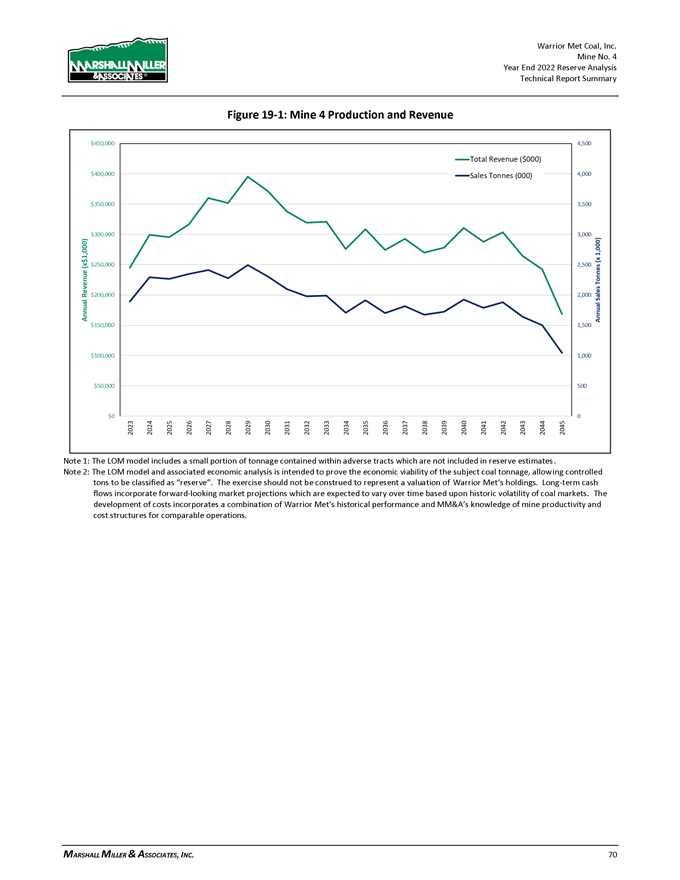
Figure 19-1: Mine 4 Production and Revenue Note 1: The LOM model includes a small portion of tonnage contained within adverse tracts which are not included in reserve estimates. Note 2: The LOM model and associated economic analysis is intended to prove the economic viability of the subject coal tonnage, allowing controlled tons to be classified as “reserve”. The exercise should not be construed to represent a valuation of Warrior Met’s holdings. Long-term cash flows incorporate forward-looking market projections which are expected to vary over time based upon historic volatility of coal markets. The development of costs incorporates a combination of Warrior Met’s historical performance and MM&A’s knowledge of mine productivity and cost structures for comparable operations. MARSHALL MILLER & ASSOCIATES, INC. 70
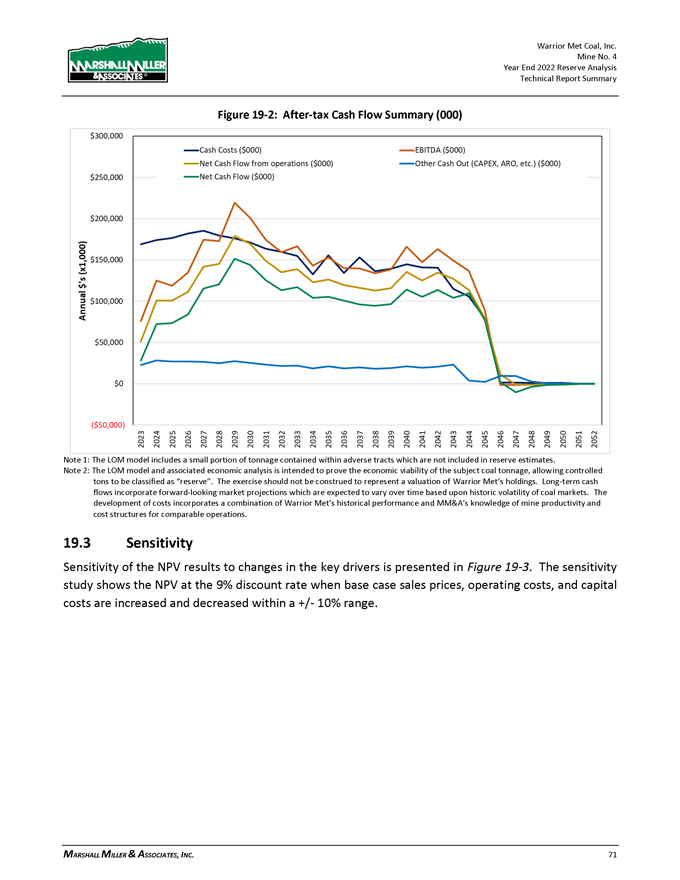
Figure 19-2: After-tax Cash Flow Summary (000) Note 1: The LOM model includes a small portion of tonnage contained within adverse tracts which are not included in reserve estimates. Note 2: The LOM model and associated economic analysis is intended to prove the economic viability of the subject coal tonnage, allowing controlled tons to be classified as “reserve”. The exercise should not be construed to represent a valuation of Warrior Met’s holdings. Long-term cash flows incorporate forward-looking market projections which are expected to vary over time based upon historic volatility of coal markets. The development of costs incorporates a combination of Warrior Met’s historical performance and MM&A’s knowledge of mine productivity and cost structures for comparable operations. 19.3 Sensitivity Sensitivity of the NPV results to changes in the key drivers is presented in Figure 19-3. The sensitivity study shows the NPV at the 9% discount rate when base case sales prices, operating costs, and capital costs are increased and decreased within a +/- 10% range. MARSHALL MILLER & ASSOCIATES, INC. 71
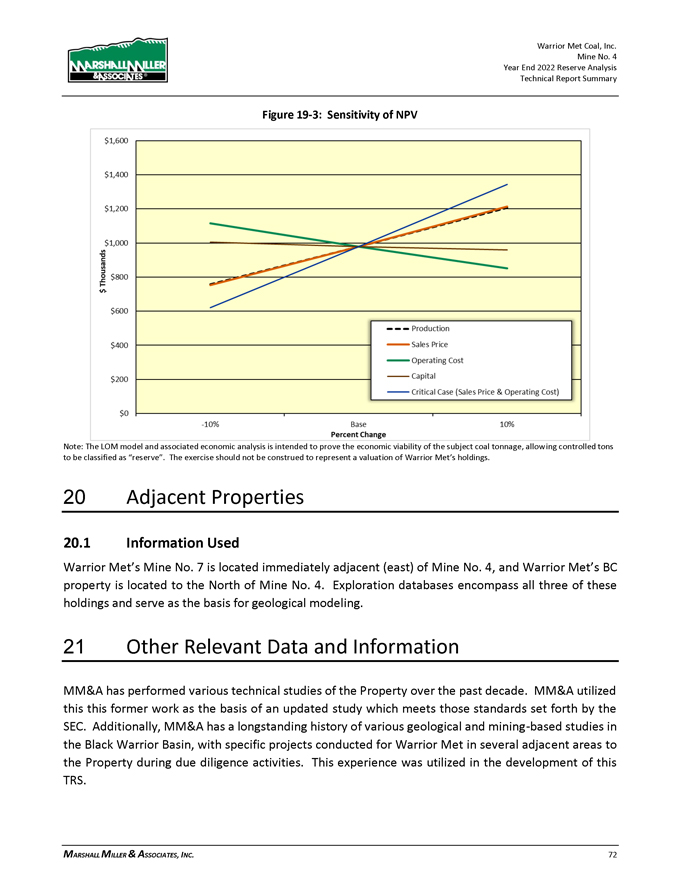
Figure 19-3: Sensitivity of NPV Note: The LOM model and associated economic analysis is intended to prove the economic viability of the subject coal tonnage, allowing controlled tons to be classified as “reserve”. The exercise should not be construed to represent a valuation of Warrior Met’s holdings. 20 Adjacent Properties 20.1 Information Used Warrior Met’s Mine No. 7 is located immediately adjacent (east) of Mine No. 4, and Warrior Met’s BC property is located to the North of Mine No. 4. Exploration databases encompass all three of these holdings and serve as the basis for geological modeling. 21 Other Relevant Data and Information MM&A has performed various technical studies of the Property over the past decade. MM&A utilized this this former work as the basis of an updated study which meets those standards set forth by the SEC. Additionally, MM&A has a longstanding history of various geological and mining-based studies in the Black Warrior Basin, with specific projects conducted for Warrior Met in several adjacent areas to the Property during due diligence activities. This experience was utilized in the development of this TRS. MARSHALL MILLER & ASSOCIATES, INC. 72
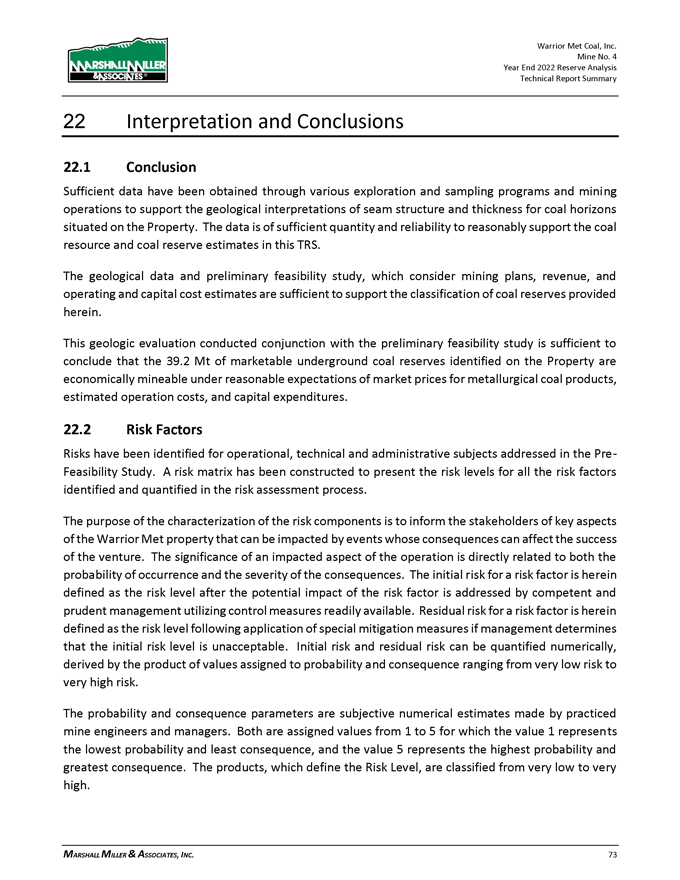
22 Interpretation and Conclusions 22.1 Conclusion Sufficient data have been obtained through various exploration and sampling programs and mining operations to support the geological interpretations of seam structure and thickness for coal horizons situated on the Property. The data is of sufficient quantity and reliability to reasonably support the coal resource and coal reserve estimates in this TRS. The geological data and preliminary feasibility study, which consider mining plans, revenue, and operating and capital cost estimates are sufficient to support the classification of coal reserves provided herein. This geologic evaluation conducted conjunction with the preliminary feasibility study is sufficient to conclude that the 39.2 Mt of marketable underground coal reserves identified on the Property are economically mineable under reasonable expectations of market prices for metallurgical coal products, estimated operation costs, and capital expenditures. 22.2 Risk Factors Risks have been identified for operational, technical and administrative subjects addressed in the Pre-Feasibility Study. A risk matrix has been constructed to present the risk levels for all the risk factors identified and quantified in the risk assessment process. The purpose of the characterization of the risk components is to inform the stakeholders of key aspects of the Warrior Met property that can be impacted by events whose consequences can affect the success of the venture. The significance of an impacted aspect of the operation is directly related to both the probability of occurrence and the severity of the consequences. The initial risk for a risk factor is herein defined as the risk level after the potential impact of the risk factor is addressed by competent and prudent management utilizing control measures readily available. Residual risk for a risk factor is herein defined as the risk level following application of special mitigation measures if management determines that the initial risk level is unacceptable. Initial risk and residual risk can be quantified numerically, derived by the product of values assigned to probability and consequence ranging from very low risk to very high risk. The probability and consequence parameters are subjective numerical estimates made by practiced mine engineers and managers. Both are assigned values from 1 to 5 for which the value 1 represents the lowest probability and least consequence, and the value 5 represents the highest probability and greatest consequence. The products, which define the Risk Level, are classified from very low to very high. MARSHALL MILLER & ASSOCIATES, INC. 73
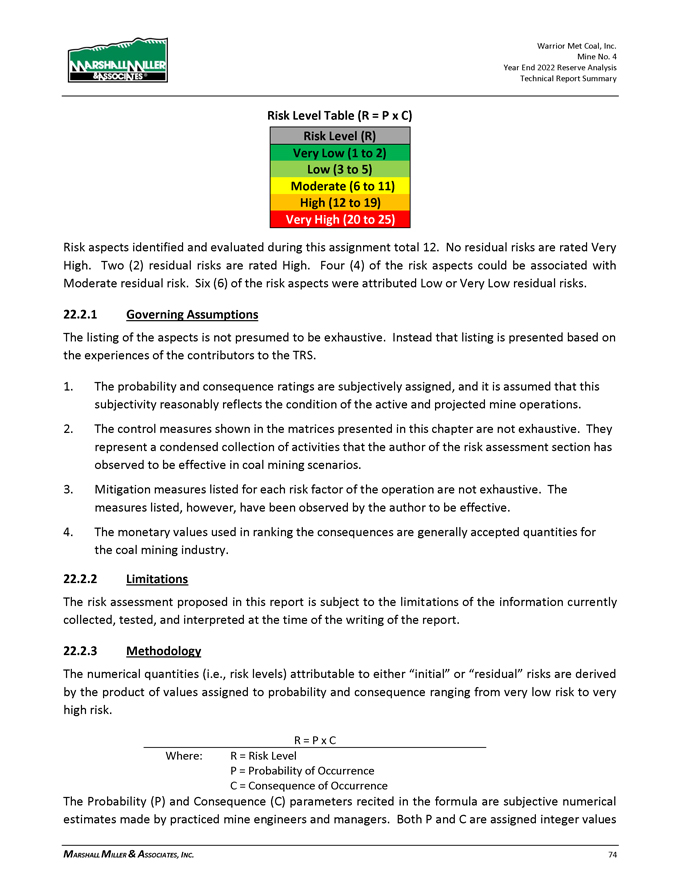
Risk Level Table (R = P x C) Risk Level (R) Very Low (1 to 2) Low (3 to 5) Moderate (6 to 11) High (12 to 19) Very High (20 to 25) Risk aspects identified and evaluated during this assignment total 12. No residual risks are rated Very High. Two (2) residual risks are rated High. Four (4) of the risk aspects could be associated with Moderate residual risk. Six (6) of the risk aspects were attributed Low or Very Low residual risks. 22.2.1 Governing Assumptions The listing of the aspects is not presumed to be exhaustive. Instead that listing is presented based on the experiences of the contributors to the TRS. 1. The probability and consequence ratings are subjectively assigned, and it is assumed that this subjectivity reasonably reflects the condition of the active and projected mine operations. 2. The control measures shown in the matrices presented in this chapter are not exhaustive. They represent a condensed collection of activities that the author of the risk assessment section has observed to be effective in coal mining scenarios. 3. Mitigation measures listed for each risk factor of the operation are not exhaustive. The measures listed, however, have been observed by the author to be effective. 4. The monetary values used in ranking the consequences are generally accepted quantities for the coal mining industry. 22.2.2 Limitations The risk assessment proposed in this report is subject to the limitations of the information currently collected, tested, and interpreted at the time of the writing of the report. 22.2.3 Methodology The numerical quantities (i.e., risk levels) attributable to either “initial” or “residual” risks are derived by the product of values assigned to probability and consequence ranging from very low risk to very high risk. R = P x C Where: R = Risk Level P = Probability of Occurrence C = Consequence of Occurrence The Probability (P) and Consequence (C) parameters recited in the formula are subjective numerical estimates made by practiced mine engineers and managers. Both P and C are assigned integer values MARSHALL MILLER & ASSOCIATES, INC. 74
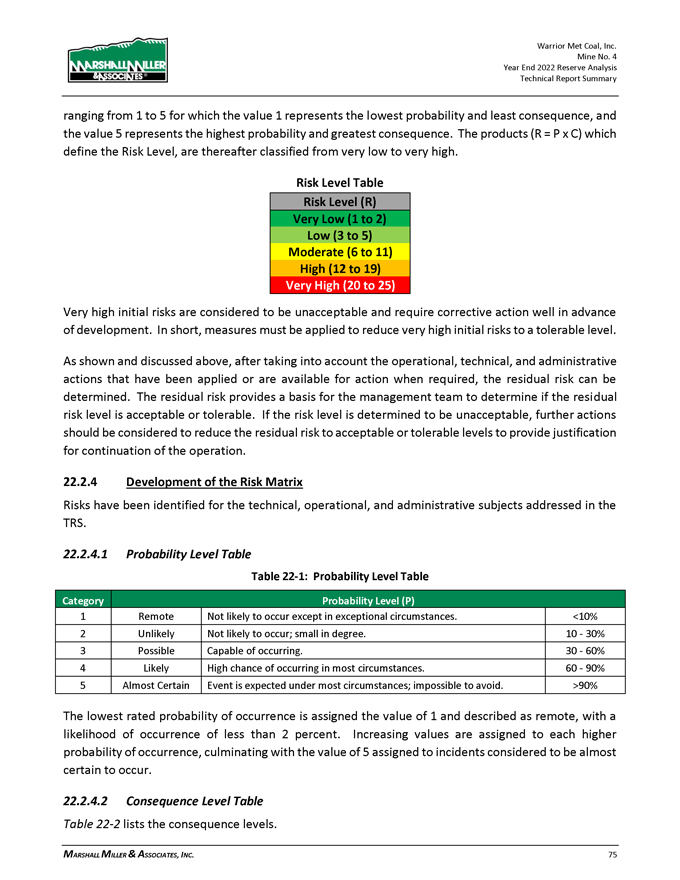
ranging from 1 to 5 for which the value 1 represents the lowest probability and least consequence, and the value 5 represents the highest probability and greatest consequence. The products (R = P x C) which define the Risk Level, are thereafter classified from very low to very high. Risk Level Table Risk Level (R) Very Low (1 to 2) Low (3 to 5) Moderate (6 to 11) High (12 to 19) Very High (20 to 25) Very high initial risks are considered to be unacceptable and require corrective action well in advance of development. In short, measures must be applied to reduce very high initial risks to a tolerable level. As shown and discussed above, after taking into account the operational, technical, and administrative actions that have been applied or are available for action when required, the residual risk can be determined. The residual risk provides a basis for the management team to determine if the residual risk level is acceptable or tolerable. If the risk level is determined to be unacceptable, further actions should be considered to reduce the residual risk to acceptable or tolerable levels to provide justification for continuation of the operation. 22.2.4 Development of the Risk Matrix Risks have been identified for the technical, operational, and administrative subjects addressed in the TRS. 22.2.4.1 Probability Level Table Table 22-1: Probability Level Table Category Probability Level (P) 1 Remote Not likely to occur except in exceptional circumstances. <10% 2 Unlikely Not likely to occur; small in degree. 10—30% 3 Possible Capable of occurring. 30—60% 4 Likely High chance of occurring in most circumstances. 60—90% 5 Almost Certain Event is expected under most circumstances; impossible to avoid. >90% The lowest rated probability of occurrence is assigned the value of 1 and described as remote, with a likelihood of occurrence of less than 2 percent. Increasing values are assigned to each higher probability of occurrence, culminating with the value of 5 assigned to incidents considered to be almost certain to occur. 22.2.4.2 Consequence Level Table Table 22-2 lists the consequence levels. MARSHALL MILLER & ASSOCIATES, INC. 75

Table 22-2: Consequence Level Table Correlation of Events in Key Elements of the Program to Event Severity Category Unplanned Loss of Production (Impact on Events Affecting the Program’s Severity of Financial Impact Commercial Events Impacting Social and Community Resultant Regulatory / Events Affecting Occupational Category the Event of the Event Operations) on the Environment Relations Sovereign Risk Health & Safety Insignificant loss of Event recurrence avoided by habitat; no < USD $0.5 Occasional nuisance impact on corrective action through 1 Insignificant ? 12 hours irreversible effects— million travel. established procedures on water, soil and (Engineering, guarding, training). the environment. No significant change to species First aid – lost time. Event Persistent nuisance impact on USD $0.5 million populations; short- recurrence avoided by corrective 2 Minor ? 1 day travel. Transient adverse media— to $2.0 million term reversible action thought established coverage. perturbation to procedures. ecosystem function. Appreciable change Uncertainty securing or Measurable impact on travel Medical Treatment – permanent to species retaining essential and water/air quality. incapacitation Avoiding event USD $2.0 million population; approval / license. 3 Moderate ? 1 week Significant adverse media recurrence requires modification to $10.0 million medium-term (?10 coverage / transient public Change to regulations to established corrective action years) detriment to outrage. (tax; bonds; standards). procedures. ecosystem function. Change to species Suspension / long-delay population Long-term, serious impact on in securing essential Fatality. Avoiding event USD $10.0 threatening travel and use of water approval / license. recurrence requires modification 4 Major million to $50.0 1 to 2 weeks viability; long-term resources; degradation of air to established corrective action million (>10 years) quality; sustained and effective Change to laws (tax; procedures and staff retraining. detriment to public opposition. bonds; standards). ecosystem function. Species extinction; Multiple fatalities. Avoiding Withdraw / failure to >USD $50.0 irreversible damage event recurrence requires major 5 Critical >1 month Loss of social license. secure essential million to ecosystem overhaul of policies and approval / license. function. procedures. MARSHALL MILLER & ASSOCIATES, INC. 76
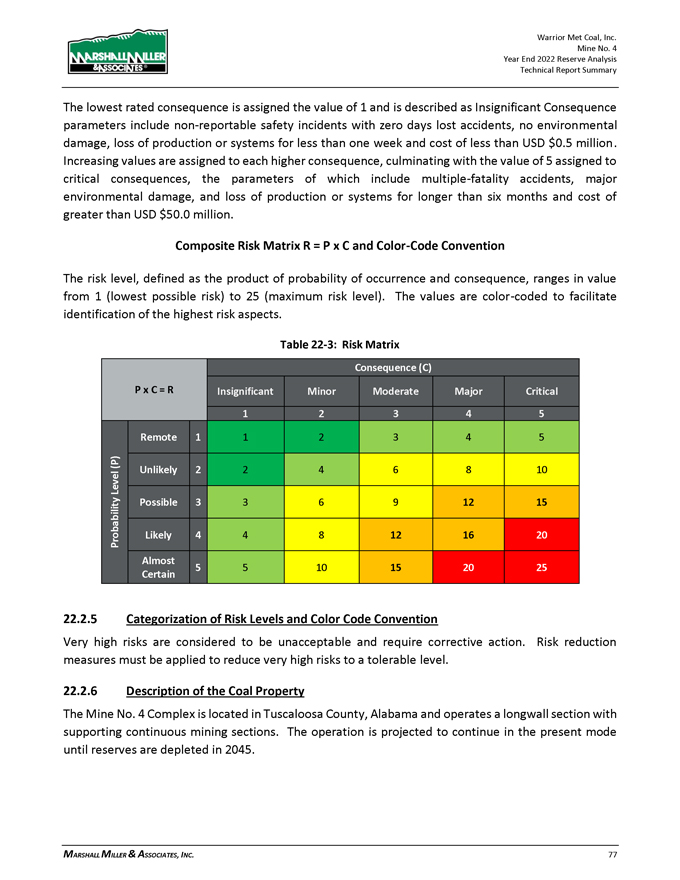
The lowest rated consequence is assigned the value of 1 and is described as Insignificant Consequence parameters include non-reportable safety incidents with zero days lost accidents, no environmental damage, loss of production or systems for less than one week and cost of less than USD $0.5 million. Increasing values are assigned to each higher consequence, culminating with the value of 5 assigned to critical consequences, the parameters of which include multiple-fatality accidents, major environmental damage, and loss of production or systems for longer than six months and cost of greater than USD $50.0 million. Composite Risk Matrix R = P x C and Color-Code Convention The risk level, defined as the product of probability of occurrence and consequence, ranges in value from 1 (lowest possible risk) to 25 (maximum risk level). The values are color-coded to facilitate identification of the highest risk aspects. Table 22-3: Risk Matrix Consequence (C) P x C = R Insignificant Minor Moderate Major Critical 1 2 3 4 5 Remote 1 1 2 3 4 5 (P) Level Unlikely 2 2 4 6 8 10 Possible 3 3 6 9 12 15 Probability Likely 4 4 8 12 16 20 Almost 5 5 10 15 20 25 Certain 22.2.5 Categorization of Risk Levels and Color Code Convention Very high risks are considered to be unacceptable and require corrective action. Risk reduction measures must be applied to reduce very high risks to a tolerable level. 22.2.6 Description of the Coal Property The Mine No. 4 Complex is located in Tuscaloosa County, Alabama and operates a longwall section with supporting continuous mining sections. The operation is projected to continue in the present mode until reserves are depleted in 2045. MARSHALL MILLER & ASSOCIATES, INC. 77
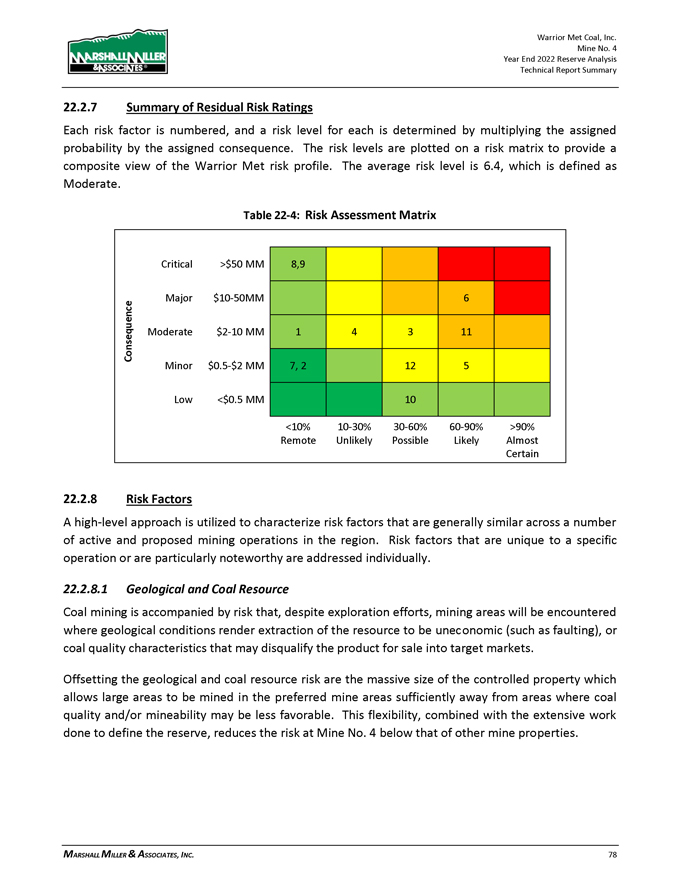
22.2.7 Summary of Residual Risk Ratings Each risk factor is numbered, and a risk level for each is determined by multiplying the assigned probability by the assigned consequence. The risk levels are plotted on a risk matrix to provide a composite view of the Warrior Met risk profile. The average risk level is 6.4, which is defined as Moderate. Table 22-4: Risk Assessment Matrix Critical >$50 MM 8,9 Major $10-50MM 6 Moderate $2-10 MM 1 4 3 11 Consequence Minor $0.5-$2 MM 7, 2 12 5 Low <$0.5 MM 10 <10% 10-30% 30-60% 60-90% >90% Remote Unlikely Possible Likely Almost Certain 22.2.8 Risk Factors A high-level approach is utilized to characterize risk factors that are generally similar across a number of active and proposed mining operations in the region. Risk factors that are unique to a specific operation or are particularly noteworthy are addressed individually. 22.2.8.1 Geological and Coal Resource Coal mining is accompanied by risk that, despite exploration efforts, mining areas will be encountered where geological conditions render extraction of the resource to be uneconomic (such as faulting), or coal quality characteristics that may disqualify the product for sale into target markets. Offsetting the geological and coal resource risk are the massive size of the controlled property which allows large areas to be mined in the preferred mine areas sufficiently away from areas where coal quality and/or mineability may be less favorable. This flexibility, combined with the extensive work done to define the reserve, reduces the risk at Mine No. 4 below that of other mine properties. MARSHALL MILLER & ASSOCIATES, INC. 78

Table 22-5: Geological and Coal Resource Risk Assessment (Risks 1 and 2) Initial Risk Level Residual Risk Level Aspect Impact Control Measures Mitigation Measures P C R P C R Recoverable coal Reserve base is adequate to Previous and ongoing 2 3 6 Optimize mine plan to 1 3 3 tonnes recognized to serve market commitments exploration and extensive increase resource be significantly less and respond to opportunities regional mining history recovery; develop than previously for many years. Local provide a high level of mine plan to provide estimated. adverse conditions may confidence of coal seam readily available increase frequency and cost correlation, continuity of alternate mining of production unit the coal seams, and coal locations to sustain relocations. resource tonnes. expected production level. Coal quality locally If uncontrolled, production Exploration and vast 2 3 6 Develop mine plan to 1 2 2 proves to be lower and sale of coal that is out of experience and history in provide readily than initially projected. specification can result in local coal seams provide available alternate rejection of deliveries, confidence in coal quality; mining locations to cancellation of coal sales limited excursions can be sustain expected agreements and damage to managed with careful production level; reputation. product segregation and modify coal sales blending. agreements to reflect coal quality. Conduct additional drilling to lower risk associated with quality concerns in suspect areas. 22.2.8.2 Environmental Water quality and other permit requirements are subject to modification and such changes could have a material impact on the capability of the operator to meet modified standards or to receive new permits and modifications to existing permits. Permit protests may result in delays or denials to permit applications. Environmental standards and permit requirements have evolved significantly over the past 50 years and to-date, mining operators and regulatory bodies have been able to adapt successfully to evolving environmental requirements. Table 22-6: Environmental (Risks 3 and 4) Residual Risk Initial Risk Level Level Aspect Impact Control Measures P C R Mitigation Measures P C R Environmental Delays in receiving new Work with regulatory 3 4 12 Modify mining and 3 3 9 performance standards permits and modifications to agencies to understand and reclamation plans to improve are modified in the existing permits; cost of influence final standards; compliance with new future. testing and treatment of water implement testing, treatment standards while reducing and soils and other actions to comply cost of compliance. with new standards. New permits and permit Interruption of production and Comply quickly with testing, 2 4 8 Establish and maintain close 2 3 6 modifications are delayed implementation of treatment and other actions and constructive working increasingly delayed or replacement production from required; continue excellent relationships with regulatory denied. new mining areas. compliance performance agencies, local communities within existing permits. and community action groups. Prepare and submit permits well in advance of needs. MARSHALL MILLER & ASSOCIATES, INC. 79
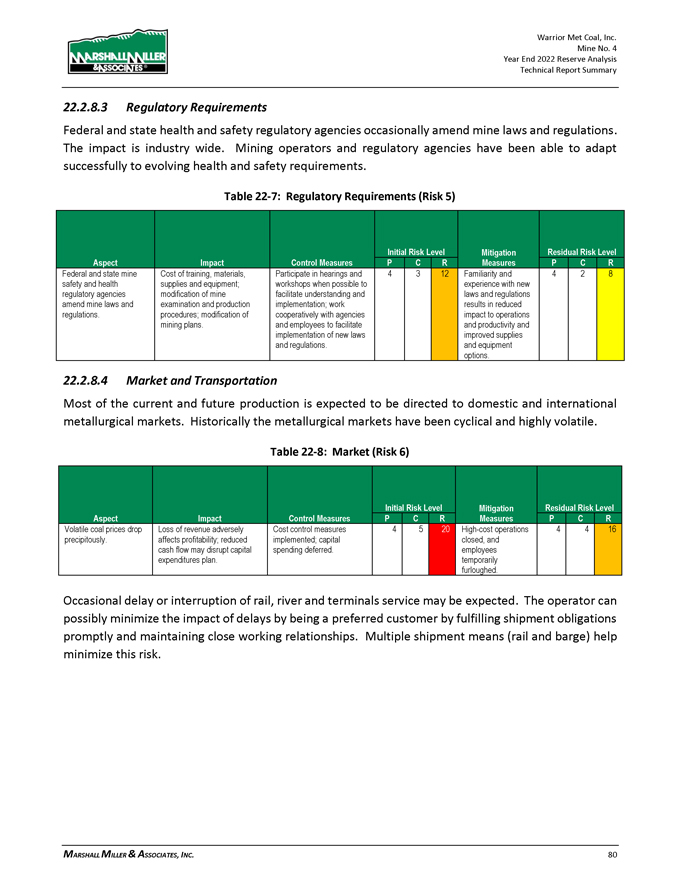
22.2.8.3 Regulatory Requirements Federal and state health and safety regulatory agencies occasionally amend mine laws and regulations. The impact is industry wide. Mining operators and regulatory agencies have been able to adapt successfully to evolving health and safety requirements. Table 22-7: Regulatory Requirements (Risk 5) Initial Risk Level Mitigation Residual Risk Level Aspect Impact Control Measures P C R Measures P C R Federal and state mine Cost of training, materials, Participate in hearings and 4 3 12 Familiarity and 4 2 8 safety and health supplies and equipment; workshops when possible to experience with new regulatory agencies modification of mine facilitate understanding and laws and regulations amend mine laws and examination and production implementation; work results in reduced regulations. procedures; modification of cooperatively with agencies impact to operations mining plans. and employees to facilitate and productivity and implementation of new laws improved supplies and regulations. and equipment options. 22.2.8.4 Market and Transportation Most of the current and future production is expected to be directed to domestic and international metallurgical markets. Historically the metallurgical markets have been cyclical and highly volatile. Table 22-8: Market (Risk 6) Initial Risk Level Mitigation Residual Risk Level Aspect Impact Control Measures P C R Measures P C R Volatile coal prices drop Loss of revenue adversely Cost control measures 4 5 20 High-cost operations 4 4 16 precipitously. affects profitability; reduced implemented; capital closed, and cash flow may disrupt capital spending deferred. employees expenditures plan. temporarily furloughed. Occasional delay or interruption of rail, river and terminals service may be expected. The operator can possibly minimize the impact of delays by being a preferred customer by fulfilling shipment obligations promptly and maintaining close working relationships. Multiple shipment means (rail and barge) help minimize this risk. MARSHALL MILLER & ASSOCIATES, INC. 80
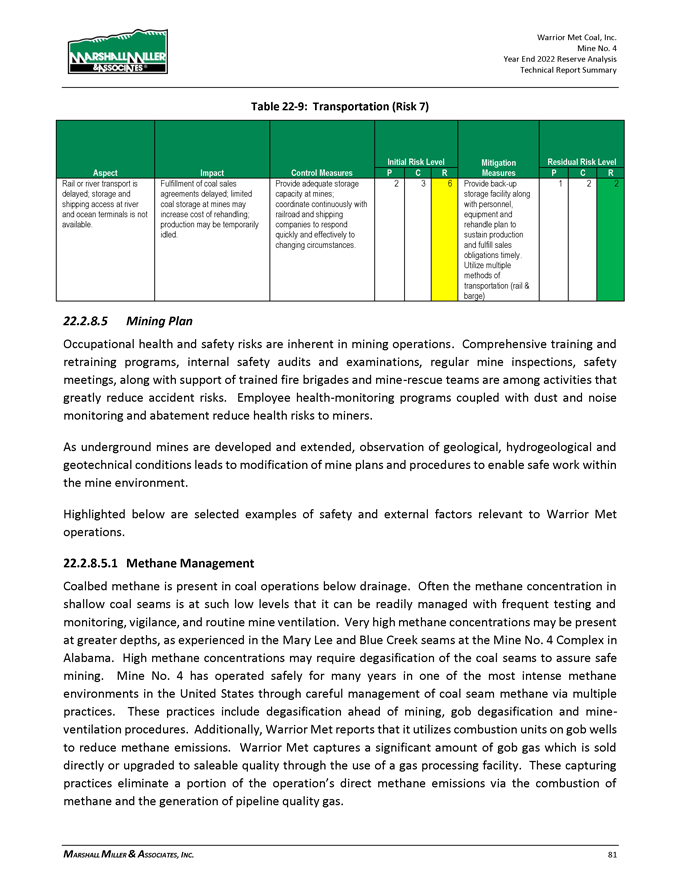
Table 22-9: Transportation (Risk 7) Initial Risk Level Mitigation Residual Risk Level Aspect Impact Control Measures P C R Measures P C R Rail or river transport is Fulfillment of coal sales Provide adequate storage 2 3 6 Provide back-up 1 2 2 delayed; storage and agreements delayed; limited capacity at mines; storage facility along shipping access at river coal storage at mines may coordinate continuously with with personnel, and ocean terminals is not increase cost of rehandling; railroad and shipping equipment and available. production may be temporarily companies to respond rehandle plan to idled. quickly and effectively to sustain production changing circumstances. and fulfill sales obligations timely. Utilize multiple methods of transportation (rail & barge) 22.2.8.5 Mining Plan Occupational health and safety risks are inherent in mining operations. Comprehensive training and retraining programs, internal safety audits and examinations, regular mine inspections, safety meetings, along with support of trained fire brigades and mine-rescue teams are among activities that greatly reduce accident risks. Employee health-monitoring programs coupled with dust and noise monitoring and abatement reduce health risks to miners. As underground mines are developed and extended, observation of geological, hydrogeological and geotechnical conditions leads to modification of mine plans and procedures to enable safe work within the mine environment. Highlighted below are selected examples of safety and external factors relevant to Warrior Met operations. 22.2.8.5.1 Methane Management Coalbed methane is present in coal operations below drainage. Often the methane concentration in shallow coal seams is at such low levels that it can be readily managed with frequent testing and monitoring, vigilance, and routine mine ventilation. Very high methane concentrations may be present at greater depths, as experienced in the Mary Lee and Blue Creek seams at the Mine No. 4 Complex in Alabama. High methane concentrations may require degasification of the coal seams to assure safe mining. Mine No. 4 has operated safely for many years in one of the most intense methane environments in the United States through careful management of coal seam methane via multiple practices. These practices include degasification ahead of mining, gob degasification and mine-ventilation procedures. Additionally, Warrior Met reports that it utilizes combustion units on gob wells to reduce methane emissions. Warrior Met captures a significant amount of gob gas which is sold directly or upgraded to saleable quality through the use of a gas processing facility. These capturing practices eliminate a portion of the operation’s direct methane emissions via the combustion of methane and the generation of pipeline quality gas. MARSHALL MILLER & ASSOCIATES, INC. 81
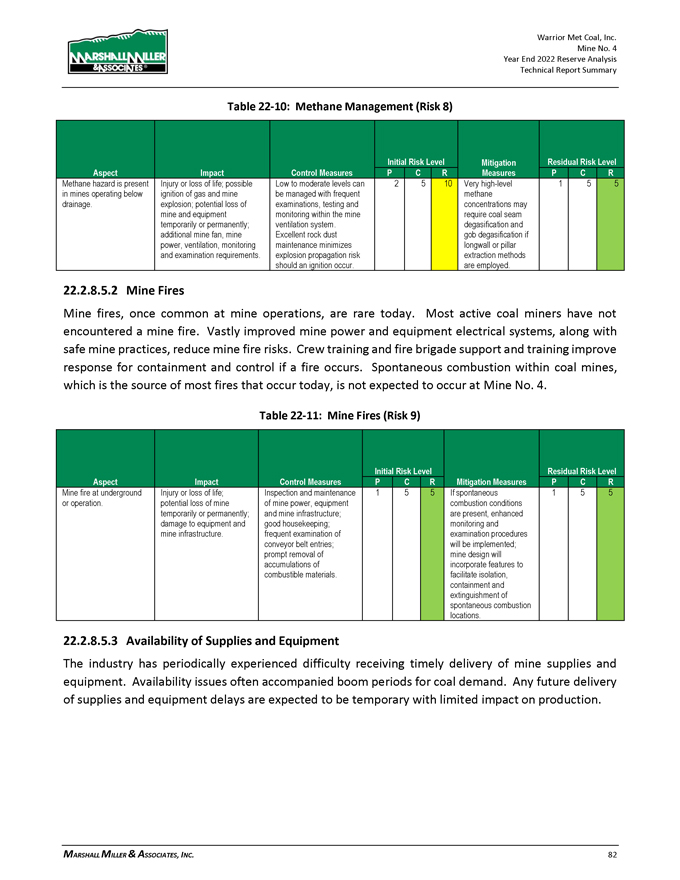
Table 22-10: Methane Management (Risk 8) Initial Risk Level Mitigation Residual Risk Level Aspect Impact Control Measures P C R Measures P C R Methane hazard is present Injury or loss of life; possible Low to moderate levels can 2 5 10 Very high-level 1 5 5 in mines operating below ignition of gas and mine be managed with frequent methane drainage. explosion; potential loss of examinations, testing and concentrations may mine and equipment monitoring within the mine require coal seam temporarily or permanently; ventilation system. degasification and additional mine fan, mine Excellent rock dust gob degasification if power, ventilation, monitoring maintenance minimizes longwall or pillar and examination requirements. explosion propagation risk extraction methods should an ignition occur. are employed. 22.2.8.5.2 Mine Fires Mine fires, once common at mine operations, are rare today. Most active coal miners have not encountered a mine fire. Vastly improved mine power and equipment electrical systems, along with safe mine practices, reduce mine fire risks. Crew training and fire brigade support and training improve response for containment and control if a fire occurs. Spontaneous combustion within coal mines, which is the source of most fires that occur today, is not expected to occur at Mine No. 4. Table 22-11: Mine Fires (Risk 9) Initial Risk Level Residual Risk Level Aspect Impact Control Measures P C R Mitigation Measures P C R Mine fire at underground Injury or loss of life; Inspection and maintenance 1 5 5 If spontaneous 1 5 5 or operation. potential loss of mine of mine power, equipment combustion conditions temporarily or permanently; and mine infrastructure; are present, enhanced damage to equipment and good housekeeping; monitoring and mine infrastructure. frequent examination of examination procedures conveyor belt entries; will be implemented; prompt removal of mine design will accumulations of incorporate features to combustible materials. facilitate isolation, containment and extinguishment of spontaneous combustion locations. 22.2.8.5.3 Availability of Supplies and Equipment The industry has periodically experienced difficulty receiving timely delivery of mine supplies and equipment. Availability issues often accompanied boom periods for coal demand. Any future delivery of supplies and equipment delays are expected to be temporary with limited impact on production. MARSHALL MILLER & ASSOCIATES, INC. 82

Table 22-12: Availability of Supplies and Equipment (Risk 10) Initial Risk Level Mitigation Residual Risk Level Aspect Impact Control Measures P C R Measures P C R Disruption of availability Temporary interruption of Force majeure provision in 3 2 6 Work closely with 3 1 3 for supplies and production. coal sales agreements to customers to assure equipment. limit liability for delayed or delayed coal delivery lost sales. rather than cancelled sales; monitor external conditions and increase inventory of critical supplies; accelerate delivery of equipment when possible. 22.2.8.5.4 Labor Work stoppage due to labor protests are considered unlikely and are accompanied by limited impact should it occur. Excellent employee relations and communications limit the exposure to outside protesters. Loss of supervisors and skilled employees to retirement is inevitable; the impact can be lessened with succession planning and training and training and mentorship of new employees. Table 22-13: Labor – Work Stoppage (Risk 11) Initial Risk Level Mitigation Residual Risk Level Aspect Impact Control Measures P C R Measures P C R Work stoppage due to Loss of production and coal Maintain excellent employee 4 4 16 Develop plan for 4 3 12 strikes, slowdowns or sales; damaged customer and relations and employee secondary boycott activity. employee relations; reputation communications; maintain communications and loss. frequent customer legal support to communications. Train minimize impact of salary employees for hourly secondary boycott tasks in case of long-term activities. strike. Table 22-14: Labor – Retirement (Risk 12) Initial Risk Level Mitigation Residual Risk Level Aspect Impact Control Measures P C R Measures P C R Retirement of supervisors Loss of leadership and critical Monitor demographics 3 3 9 Maintain selection of 3 2 6 and skilled employees. skills to sustain high levels of closely and maintain candidates and safety, maintenance and communications with implementation of in-productivity. employees who are house or third-party approaching retirement age; training for maintain employee selection electricians and and training programs. mechanics; develop employee mentoring program. MARSHALL MILLER & ASSOCIATES, INC. 83
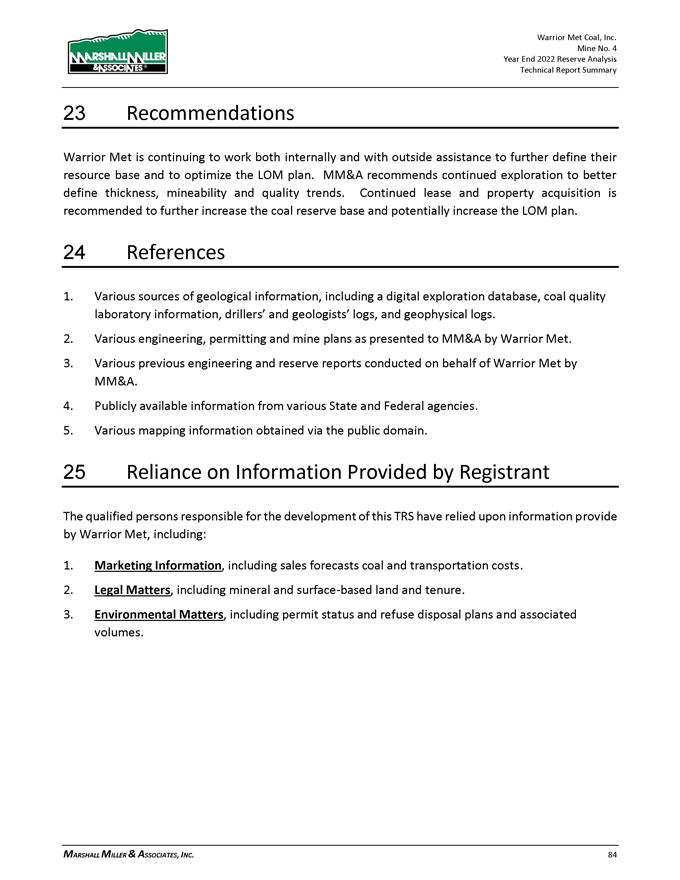
23 Recommendations Warrior Met is continuing to work both internally and with outside assistance to further define their resource base and to optimize the LOM plan. MM&A recommends continued exploration to better define thickness, mineability and quality trends. Continued lease and property acquisition is recommended to further increase the coal reserve base and potentially increase the LOM plan. 24 References 1. Various sources of geological information, including a digital exploration database, coal quality laboratory information, drillers’ and geologists’ logs, and geophysical logs. 2. Various engineering, permitting and mine plans as presented to MM&A by Warrior Met. 3. Various previous engineering and reserve reports conducted on behalf of Warrior Met by MM&A. 4. Publicly available information from various State and Federal agencies. 5. Various mapping information obtained via the public domain. 25 Reliance on Information Provided by Registrant The qualified persons responsible for the development of this TRS have relied upon information provide by Warrior Met, including: 1. Marketing Information, including sales forecasts coal and transportation costs. 2. Legal Matters, including mineral and surface-based land and tenure. 3. Environmental Matters, including permit status and refuse disposal plans and associated volumes. MARSHALL MILLER & ASSOCIATES, INC. 84
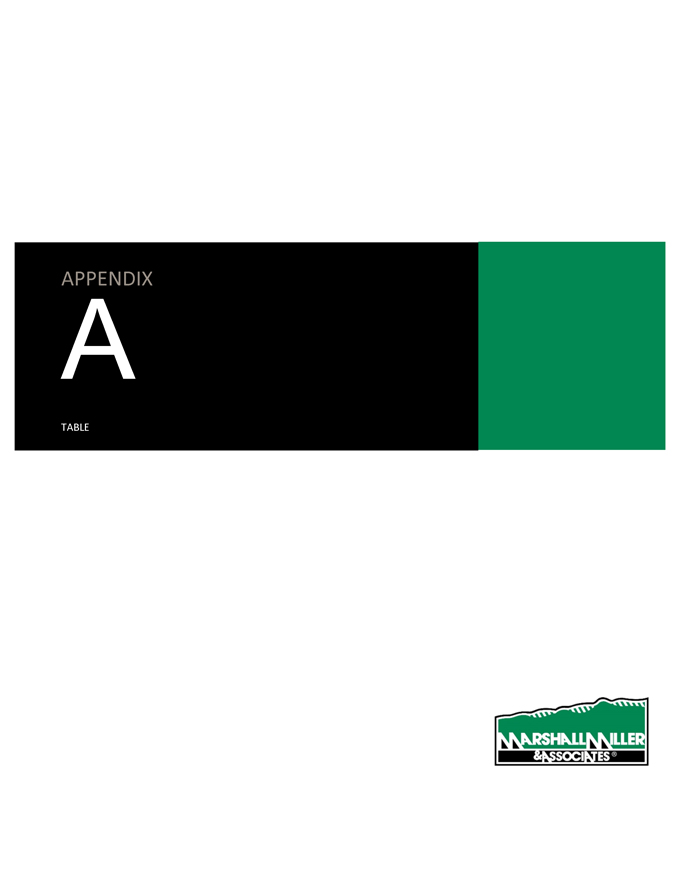
APPENDIX A TABLE
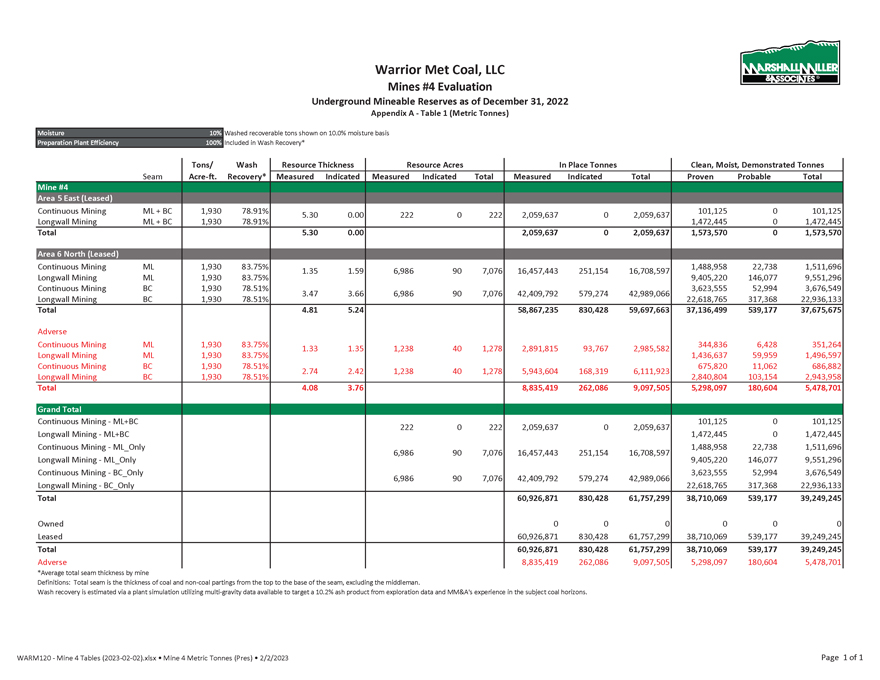
Warrior Met Coal, LLC Mines #4 Evaluation Underground Mineable Reserves as of December 31, 2022 Appendix A—Table 1 (Metric Tonnes) Moisture 10% Washed recoverable tons shown on 10.0% moisture basis Preparation Plant Efficiency 100% Included in Wash Recovery* Tons/ Wash Resource Thickness Resource Acres In Place Tonnes Clean, Moist, Demonstrated Tonnes Seam Acre-ft. Recovery* Measured Indicated Measured Indicated Total Measured Indicated Total Proven Probable Total Mine #4 Area 5 East (Leased) Continuous Mining ML + BC 1,930 78.91% 101,125 0 101,125 Longwall Mining ML + BC 1,930 78.91% 5.30 0.00 222 0 222 2,059,637 0 2,059,637 1,472,445 0 1,472,445 Total 5.30 0.00 2,059,637 0 2,059,637 1,573,570 0 1,573,570 Area 6 North (Leased) Continuous Mining ML 1,930 83.75% 1,488,958 22,738 1,511,696 Longwall Mining ML 1,930 83.75% 1.35 1.59 6,986 90 7,076 16,457,443 251,154 16,708,597 9,405,220 146,077 9,551,296 Continuous Mining BC 1,930 78.51% 3,623,555 52,994 3,676,549 3.47 3.66 6,986 90 7,076 42,409,792 579,274 42,989,066 Longwall Mining BC 1,930 78.51% 22,618,765 317,368 22,936,133 Total 4.81 5.24 58,867,235 830,428 59,697,663 37,136,499 539,177 37,675,675 Adverse Continuous Mining ML 1,930 83.75% 344,836 6,428 351,264 Longwall Mining ML 1,930 83.75% 1.33 1.35 1,238 40 1,278 2,891,815 93,767 2,985,582 1,436,637 59,959 1,496,597 Continuous Mining BC 1,930 78.51% 675,820 11,062 686,882 2.74 2.42 1,238 40 1,278 5,943,604 168,319 6,111,923 Longwall Mining BC 1,930 78.51% 2,840,804 103,154 2,943,958 Total 4.08 3.76 8,835,419 262,086 9,097,505 5,298,097 180,604 5,478,701 Grand Total Continuous Mining—ML+BC 101,125 0 101,125 Longwall Mining—ML+BC 222 0 222 2,059,637 0 2,059,637 1,472,445 0 1,472,445 Continuous Mining—ML_Only 1,488,958 22,738 1,511,696 Longwall Mining—ML_Only 6,986 90 7,076 16,457,443 251,154 16,708,597 9,405,220 146,077 9,551,296 Continuous Mining—BC_Only 3,623,555 52,994 3,676,549 Longwall Mining—BC_Only 6,986 90 7,076 42,409,792 579,274 42,989,066 22,618,765 317,368 22,936,133 Total 60,926,871 830,428 61,757,299 38,710,069 539,177 39,249,245 Owned 0 0 0 0 0 0 Leased 60,926,871 830,428 61,757,299 38,710,069 539,177 39,249,245 Total 60,926,871 830,428 61,757,299 38,710,069 539,177 39,249,245 Adverse 8,835,419 262,086 9,097,505 5,298,097 180,604 5,478,701 *Average total seam thickness by mine Definitions: Total seam is the thickness of coal and non-coal partings from the top to the base of the seam, excluding the middleman. Wash recovery is estimated via a plant simulation utilizing multi-gravity data available to target a 10.2% ash product from exploration data and MM&A’s experience in the subject coal horizons. (2023-02-02).xlsx • Mine 4 Metric Tonnes (Pres) • 2/2/2023 Page 1 of 1

APPENDIX B MARKET MEMORANDUM PROVIDED BY WARRIOR MET
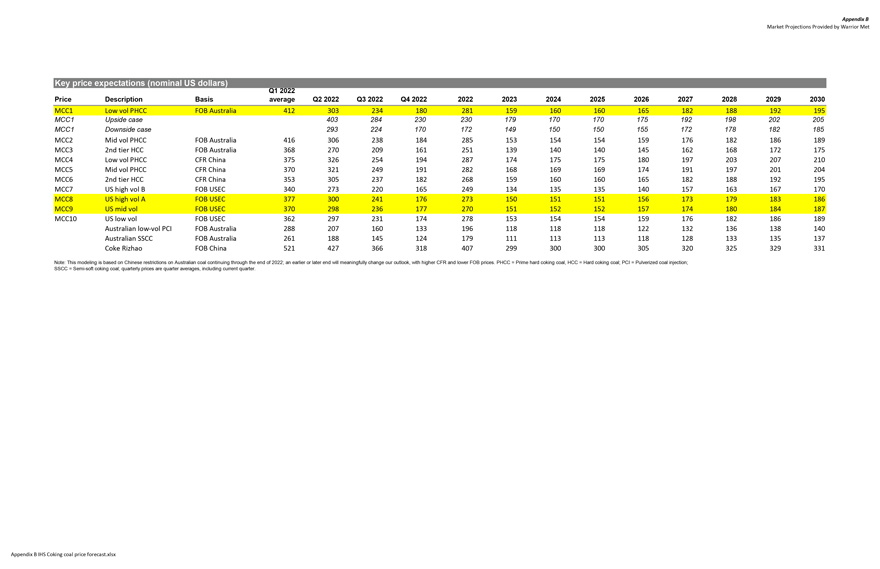
Appendix B Market Projections Provided by Warrior Met Key price expectations (nominal US dollars) Q1 2022 Price Description Basis average Q2 2022 Q3 2022 Q4 2022 2022 2023 2024 2025 2026 2027 2028 2029 2030 MCC1 Low vol PHCC FOB Australia 412 303 234 180 281 159 160 160 165 182 188 192 195 MCC1 Upside case 403 284 230 230 179 170 170 175 192 198 202 205 MCC1 Downside case 293 224 170 172 149 150 150 155 172 178 182 185 MCC2 Mid vol PHCC FOB Australia 416 306 238 184 285 153 154 154 159 176 182 186 189 MCC3 2nd tier HCC FOB Australia 368 270 209 161 251 139 140 140 145 162 168 172 175 MCC4 Low vol PHCC CFR China 375 326 254 194 287 174 175 175 180 197 203 207 210 MCC5 Mid vol PHCC CFR China 370 321 249 191 282 168 169 169 174 191 197 201 204 MCC6 2nd tier HCC CFR China 353 305 237 182 268 159 160 160 165 182 188 192 195 MCC7 US high vol B FOB USEC 340 273 220 165 249 134 135 135 140 157 163 167 170 MCC8 US high vol A FOB USEC 377 300 241 176 273 150 151 151 156 173 179 183 186 MCC9 US mid vol FOB USEC 370 298 236 177 270 151 152 152 157 174 180 184 187 MCC10 US low vol FOB USEC 362 297 231 174 278 153 154 154 159 176 182 186 189 Australian low-vol PCI FOB Australia 288 207 160 133 196 118 118 118 122 132 136 138 140 Australian SSCC FOB Australia 261 188 145 124 179 111 113 113 118 128 133 135 137 Coke Rizhao FOB China 521 427 366 318 407 299 300 300 305 320 325 329 331 Note: This modeling is based on Chinese restrictions on Australian coal continuing through the end of 2022; an earlier or later end will meaningfully change our outlook, with higher CFR and lower FOB prices. PHCC = Prime hard coking coal, HCC = Hard coking coal; PCI = Pulverized coal injection; SSCC = Semi-soft coking coal; quarterly prices are quarter averages, including current quarter. Appendix B IHS Coking coal price forecast.xlsx